Tanzania Wildlife Photo Safari
February 2014
Trip Report

Our 2014 trip was simply fantastic. A record number of Cheetah sightings -47, 180 Lions, 6 Leopards, Aardwolves and Golden Jackal dens, a Gnu birth, the best-ever Lion cubs, and so much more.
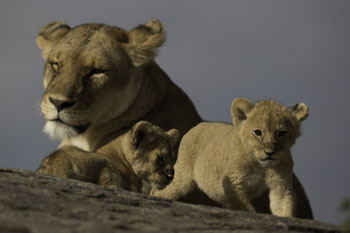
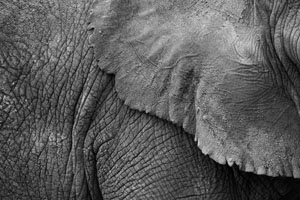

The Serengeti, the land of endless plains. Two weeks ago, as we drove across the Ngorongoro Conservation Area highlands and the famous Ngorongoro Crater and looked upon a landscape that stretched on and on until lost in haze, one might try to understand this vastness. On foot, as the first Maasai herdsmen traveled across the Serengeti across an unchanging sea of grass, this sense of expansion would be tangible, but for the modern traveler, the tourists crossing these grasslands on dirt tracks at Range Rover speeds, this sense of size can still be lost. From the air, however, it is a different story. As we flew back to Arusha from our last camp, flying over kopjes where yesterday we photographed lions and their cubs or days earlier photographed aardwolves and cheetahs, the sheer size and distance of the Serengeti truly struck home, as from this aerial perspective the grasslands simply didn’t seem to end.
Ascending the Ngorongoro highlands once again we passed over scattered Maasai villages, fewer in number in most places than I expected, before crossing the broad plateau of the highlands with unfamiliar crater lakes and the round depressions of unfilled craters far below, and ‘the crater’ itself distantly visible to the south. Clouds from the east hung on the forested eastern slopes, vividly showing the cloud forest effect, and on the western side that tapers down into the Serengeti, the rain shadow of dry, treeless slopes. One doesn’t, or at least I don’t, get the same awareness or perception when we drive across these areas, from one habitat into another, but from the air the transition from relatively flat grasslands to dry slopes to cloud forest seemed abrupt and obvious. And from the air, looking far out into the distance to where land and air comingled in a dusty haze, this wild landscape seemed to stretch forever.
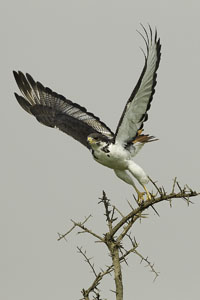
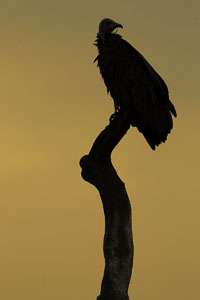
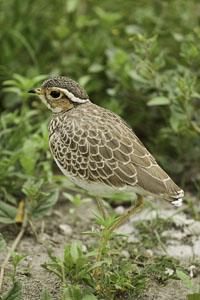
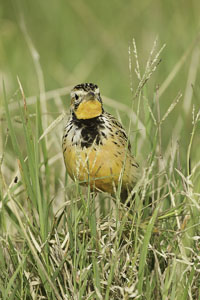
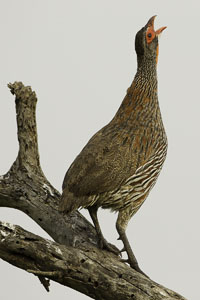
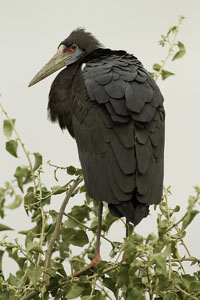
Birds of the Serengeti, Top: Augur Buzzard; Hooded Vulture; Two-banded Plover.
Bottom: Yellow-breasted Longclaw; Gray-breasted Spurfowl; Abdim's Stork.
The following is our day to day Trip Report.
Day 1. Arusha
Six of us arrived the evening prior, and all slept late, some missing the 10AM breakfast cutoff, some, like ourselves, barely slipping in. The day would have been completely uneventful except for the fire – unreported but generating the fire alarm that we were instructed to ignore in the mid-afternoon. After dinner, the fire, which had started in a tent erected somewhere in the lower level of the hotel, started smoldering again, triggering the alarm and, this time, a call to evacuate the hotel. Stupidly, Mary and I joined a Japanese couple in taking the elevator the three floors to the lobby, not the smartest move if the power had gone out. We were smart enough to carry all of our camera gear and computers down with us, in case the fire became serious. It did not, and thirty minutes later we were back in our rooms. By 11PM our last four travelers arrived at the hotel from their overseas flights, with no one missing luggage! By the way, both Mary and I carried our Gura Gear Bataflae bags as carry-on luggage, and of course used the same backpacks throughout the safari. We had no trouble on our flights, and of course the bags were perfect for field use. One of our participants used his Bataflae as carry-on, too, with a 600mm, 200-400mm, a camera body or two, and a 70-200mm all in the same bag once the center insert was removed!
Day 2. Arusha to Ngorongoro Crater
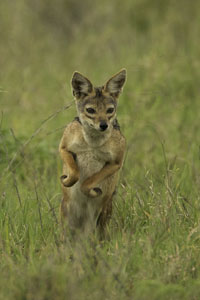 We left our hotel at 8:45 for the three plus hour drive to the crater. Twenty-six years ago, when we first made this trip, the same route would have taken nearly eight hours as we negotiated bombshell-like craters in the dirt road. Today that same route is paved and smooth, although with construction we had some minor delays with diversions. These, however, were paved or stoned, in contrast to Kenya where it almost seems as if vehicles are left to their own ingenuity to find a new route when a road is closed for repair. It was a refreshing difference.
We left our hotel at 8:45 for the three plus hour drive to the crater. Twenty-six years ago, when we first made this trip, the same route would have taken nearly eight hours as we negotiated bombshell-like craters in the dirt road. Today that same route is paved and smooth, although with construction we had some minor delays with diversions. These, however, were paved or stoned, in contrast to Kenya where it almost seems as if vehicles are left to their own ingenuity to find a new route when a road is closed for repair. It was a refreshing difference.
The landscape was surprisingly green, as the rains have come early and as we approached the Ngorongoro highlands the normally straw yellow fields were lush, with scattered flowers amid a verdant landscape. The highest peaks were shrouded in clouds, and at the overlook the inside of the crater was hazy with the moisture filled air, with the distant crater walls invisible in the murk.
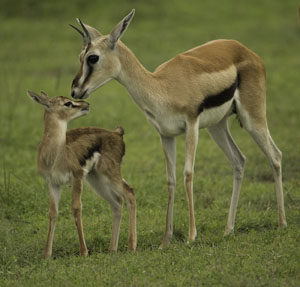 Normally there are two routes into the crater, with one of these, on the north side, accommodating two-way traffic. On the south side, where we would descend, one winding track goes down, and another climbs back out of the crater. Two years ago, construction was begun on this latter track, with a planned completion of nine months. It is still unfinished, and now everyone inside the crater must vacate via the northern road, which then adds at least one hour of driving along the crater rim to reach the majority of tourist hotels located on the south side. Consequently, by 3PM, when we reached the crater floor it was nearly empty, and less than six vehicles passed us over the next 2.5 hours, as tourists now begin to leave the crater by 3.
Normally there are two routes into the crater, with one of these, on the north side, accommodating two-way traffic. On the south side, where we would descend, one winding track goes down, and another climbs back out of the crater. Two years ago, construction was begun on this latter track, with a planned completion of nine months. It is still unfinished, and now everyone inside the crater must vacate via the northern road, which then adds at least one hour of driving along the crater rim to reach the majority of tourist hotels located on the south side. Consequently, by 3PM, when we reached the crater floor it was nearly empty, and less than six vehicles passed us over the next 2.5 hours, as tourists now begin to leave the crater by 3.
Our tented camp is located on the north side, inside the park gate, so both our entry in the morning and departure in the evening can be as close to start/finish times as possible. As we left the crater this evening, intentionally early so that we could move into our tents while we still had light, we were the only vehicles visible.
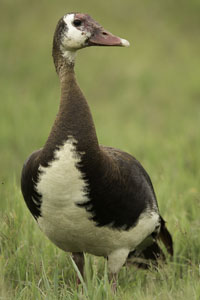 The crater is like Disney World, with all the attractions seemingly under one roof, and tame, completely habituated to vehicles. Whereas in the Serengeti gnus or zebras may shy from vehicles, here they are oblivious, and getting portraits is easy. For this, our break-in drive, our photographers shot Common Zebra, Gnus, Warthogs, Buffalo, Golden Jackal, Spotted Hyenas, and African Lions, and they saw a few dozen species of birds and mammals that we didn’t bother to shoot.
The crater is like Disney World, with all the attractions seemingly under one roof, and tame, completely habituated to vehicles. Whereas in the Serengeti gnus or zebras may shy from vehicles, here they are oblivious, and getting portraits is easy. For this, our break-in drive, our photographers shot Common Zebra, Gnus, Warthogs, Buffalo, Golden Jackal, Spotted Hyenas, and African Lions, and they saw a few dozen species of birds and mammals that we didn’t bother to shoot.
Our camp, Lion’s Paw, is located in the high country Tortillus acacia forest, where trees are bedecked with goat’s beard lichen and various orchids, and where we have often seen Elephants and Buffalo. The camp is beautiful, with running water and flush toilets, carpeted tent floors, and a sturdy, regular bed. While we ate the storms that dodged about the crater rim all afternoon advanced towards us, and at times it was difficult to hear beneath the canvas as rain pummeled the roof and thunder cracked nearby. Regardless, we did the day’s highlights, which ranged from the Golden Jackal and her pups to 11 of the 22 Black Rhinos found in the crater, from Yellow Bishop birds to displaying Kori Bustards, from seeing a first-ever Lion to simply being back to Africa. It was, despite the gloomy weather, a great start.
Day 3. Ngorongoro Crater
It rained through much of the evening and with heavy skies we had no dawn, descending into the crater in blackness. With a heavy canopy of clouds the temperature was in the fifties, but damp, and the air stayed cool throughout most of the day. Nonetheless, it was a very complete day.
Which began, in earnest after some miscellaneous shots, when a full black-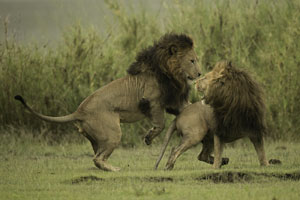 maned lion walked across the plains to drink at a roadside pool. It continued, meeting an equally large male, where they head-butted, wrestled, unseen except for the tantalizing tops of their heads when they stood upright, and scent marked along the high reeds. At one point one male stalked the other and charged, and we had a brief moment of play.
maned lion walked across the plains to drink at a roadside pool. It continued, meeting an equally large male, where they head-butted, wrestled, unseen except for the tantalizing tops of their heads when they stood upright, and scent marked along the high reeds. At one point one male stalked the other and charged, and we had a brief moment of play.
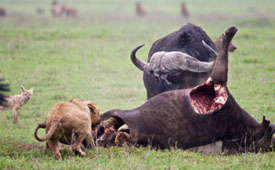 Side Note: On our flight home, while at a stopover in Dar es Salam, I happened to stop by a fellow passenger's seat as he was showing images from his ipad. He was showing some interesting lion images that caught my attention and I paused to watch and ask some questions. As it turned out, we'd met Tony on an Antarctica trip a few years earlier, although we didn't immediately recognize one another. At any rate, he too
Side Note: On our flight home, while at a stopover in Dar es Salam, I happened to stop by a fellow passenger's seat as he was showing images from his ipad. He was showing some interesting lion images that caught my attention and I paused to watch and ask some questions. As it turned out, we'd met Tony on an Antarctica trip a few years earlier, although we didn't immediately recognize one another. At any rate, he too
was in the Crater, for only one full day, and with five other friends in his vehicle. But he struck gold, and I'm relaying what he had to simply illustrate what one can see, and to describe a very interesting series of behaviors.
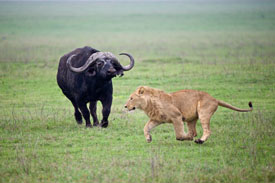 At least two of the Ngorongoro lion prides have several full grown males, and Tony found four males feeding upon an African Buffalo carcass. Several other bull buffalo were surrounding the lions as they fed, but the number of lions intimidated the buffalo and they kept their distance. Occasionally they'd move in as if to charge but the lions kept them at bay. Eventually the lions left the kill, which was then claimed by the spotted hyenas and black-backed jackals. Two younger male lions moved in, too, possibly to claim the kill, but the four full-grown, black maned lions reacted to their presence. One of the two young males ran off, but the other did not, and was soon surrounded by the four big males. They charged in, and Tony
At least two of the Ngorongoro lion prides have several full grown males, and Tony found four males feeding upon an African Buffalo carcass. Several other bull buffalo were surrounding the lions as they fed, but the number of lions intimidated the buffalo and they kept their distance. Occasionally they'd move in as if to charge but the lions kept them at bay. Eventually the lions left the kill, which was then claimed by the spotted hyenas and black-backed jackals. Two younger male lions moved in, too, possibly to claim the kill, but the four full-grown, black maned lions reacted to their presence. One of the two young males ran off, but the other did not, and was soon surrounded by the four big males. They charged in, and Tony 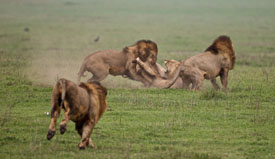 captured an entire sequence as they fought. Lions often do not go for a killing throat hold but instead simply try to bite the spine and paralyze their adversary. Doing so, and striking from behind, keeps the aggressor out of harm's way, out of the reach of damaging claws or fangs, while still ultimately accomplishing his goal. Tony caught this bite, as one big male bit the younger, and also another, when in the excitement of the fight one of the coalition males bit another in the rump, which potentially could have crippled him as well. The last shot Tony showed was of the young lion, alive but ruined, paralyzed and left to die. I've seen brief lion fights, and the roars
captured an entire sequence as they fought. Lions often do not go for a killing throat hold but instead simply try to bite the spine and paralyze their adversary. Doing so, and striking from behind, keeps the aggressor out of harm's way, out of the reach of damaging claws or fangs, while still ultimately accomplishing his goal. Tony caught this bite, as one big male bit the younger, and also another, when in the excitement of the fight one of the coalition males bit another in the rump, which potentially could have crippled him as well. The last shot Tony showed was of the young lion, alive but ruined, paralyzed and left to die. I've seen brief lion fights, and the roars 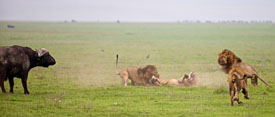 alone are so primeval I can't imagine what that whole experience was like, but it certainly would have been truly unforgettable. While we missed this incredible event, I was happy to see another photographer catch it, and this little anecdote illustrates that anything can happen any time, but you have to be there, on safari!
alone are so primeval I can't imagine what that whole experience was like, but it certainly would have been truly unforgettable. While we missed this incredible event, I was happy to see another photographer catch it, and this little anecdote illustrates that anything can happen any time, but you have to be there, on safari!
This is such an incredibly rare event to see I just had to share
Tony Wong and Wexler Mayer's images of this!
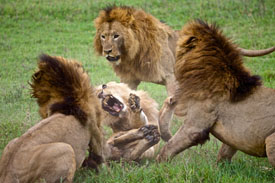
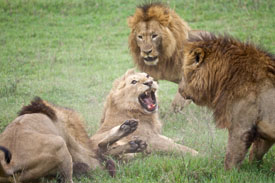

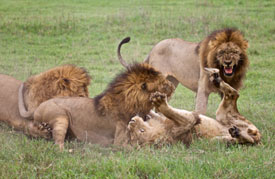
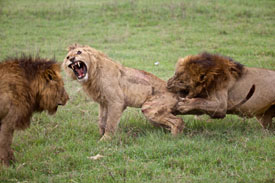
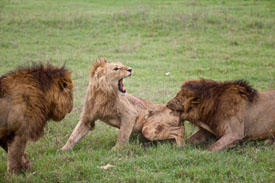
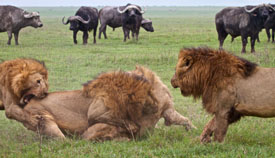
All photos above concerning the Side Note on the incredible sequence in the Ngorongoro Crater were taken by photographer Tony Wong, except for the last in this series photographed by Wexler Mayers. Well done!
You can see all of Tony's images at
https://www.flickr.com/gp/14190814@N08/898B5o/
http://flickr.com/gp/14190814@N08/mq9955/
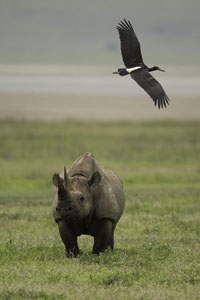 We saw several Black Rhinos, and one mating, although we arrived late and my small set of binoculars disappeared within my 800mm’s lens hood, blocking my view until I figured out the source. Afterwards, the male followed the female about, attempting to mate several times but she always rebuffed him. The male quite frequently blasted a fire hose squirt of urine, shooting a spray horizontally that was as long as the rhino itself, and I figured at least a liter of water each time.
We saw several Black Rhinos, and one mating, although we arrived late and my small set of binoculars disappeared within my 800mm’s lens hood, blocking my view until I figured out the source. Afterwards, the male followed the female about, attempting to mate several times but she always rebuffed him. The male quite frequently blasted a fire hose squirt of urine, shooting a spray horizontally that was as long as the rhino itself, and I figured at least a liter of water each time.
Along the riverine stream we encountered a Spotted Hyena that walked towards us on the track, slowly, hang-dogged and tired looking. As it got closer we could see that it was injured, with blood splatters on its legs and side, and prominent bite marks around its hips, sure sign of a lion bite. We assumed that the injured animal was limping back to its den where it would recuperate, so imagine our surprise less than an hour later when we found the hyena flat on the road, dead. When we passed the hyena in late afternoon it was still untouched, and not even a vulture had attempted to scavenge.
At the picnic area the pesky Black Kites stole chicken legs from two of our people, swooping in so quickly that the food was literally snatched from their  hands before they could react. Hippos were surprisingly close to the tourist-side of the picnic area, and the hippos surfaced close, although 90% of the time they were completely invisible, resting beneath the water. A Fan-tailed Widowbird and an African Darter made the rest of that visit more noteworthy.
hands before they could react. Hippos were surprisingly close to the tourist-side of the picnic area, and the hippos surfaced close, although 90% of the time they were completely invisible, resting beneath the water. A Fan-tailed Widowbird and an African Darter made the rest of that visit more noteworthy.
Several Common Zebras had skirmishes, with one fight lasting twenty minutes or more as immature zebras tested one another or followed a defeated foe about, harassing it to fight again. Good Warthog, Thompson’s Gazelles, and Kori Bustards rounded out some portfolios
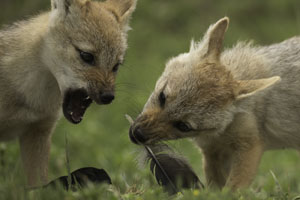 In the late afternoon we found another Golden Jackal den with two half-grown pups that played continually. The female had walked right beside us as we drove off, and we hoped that she’d return with food before the black western skies forced us to flee. The rains won, although we did part of our late afternoon driving through the rain. Still, we managed to see three Serval, and photograph good Spur-winged Geese and Black-bellied Bustards.
In the late afternoon we found another Golden Jackal den with two half-grown pups that played continually. The female had walked right beside us as we drove off, and we hoped that she’d return with food before the black western skies forced us to flee. The rains won, although we did part of our late afternoon driving through the rain. Still, we managed to see three Serval, and photograph good Spur-winged Geese and Black-bellied Bustards.
Day 4. Ngorongoro Crater
We planned for a 5:45AM breakfast, anticipating cloudy, dreary skies. Instead, the skies were clear and the stars shone brightly in an atmosphere devoid of extraneous ambient light. By the time we entered the crater the sun was just peeping over the horizon, muted somewhat with heavy humid still in the air.
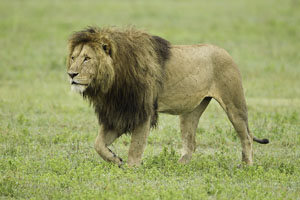 We headed towards the lion luggas, and almost immediately our guide spotted a black-maned Lion in the distance with two lionesses. As we watched they mated, but the distance was too far for any shots or the likelihood of the pair coming any closer. We moved on. Table Mountain, the remnants of the peak which one towered higher than Kilimanjaro, is the highest point within the crater and we ascended, reaching the top for a wonderful view of the misty valley floor, sparkling everywhere from permanent and ephemeral ponds. A pair of Spotted Hyenas were running in the distance, and one carried a kill which we thought was a newborn gnu. We did a U-turn and headed back downhill, following the path of the hyenas in hopes of intersecting them for some shots. We succeeded, and discovered that the kill was the front end of a baby Zebra, now just a bloody thorax, neck, and legs.
We headed towards the lion luggas, and almost immediately our guide spotted a black-maned Lion in the distance with two lionesses. As we watched they mated, but the distance was too far for any shots or the likelihood of the pair coming any closer. We moved on. Table Mountain, the remnants of the peak which one towered higher than Kilimanjaro, is the highest point within the crater and we ascended, reaching the top for a wonderful view of the misty valley floor, sparkling everywhere from permanent and ephemeral ponds. A pair of Spotted Hyenas were running in the distance, and one carried a kill which we thought was a newborn gnu. We did a U-turn and headed back downhill, following the path of the hyenas in hopes of intersecting them for some shots. We succeeded, and discovered that the kill was the front end of a baby Zebra, now just a bloody thorax, neck, and legs.

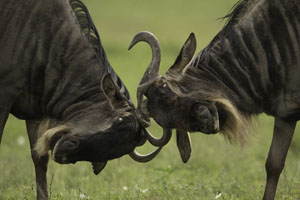
Cresting the mountain again we photographed the zebras and Gnus against the backdrop of the crater floor, before heading downhill where we spotted four big-maned Lions in the distance. They were bloated like sausages from a kill and we thought they’d head to the only pond, behind us, but after walking over a half mile the lead lion turned around and joined his lazy mates lying on a low hill hundreds of yards away. In the leopard lugga we found a Lioness with two cubs only six weeks old, quite unexpected, although the shooting window was limited because of the high weeds.
We continued to the Golden Jackal den, where the young played but slightly further than before, until two uncaring tourists stood so high in their vehicle that their human silhouette frightened the jackals into retreating much further from the den. While we watched, however, one of our guides spotted 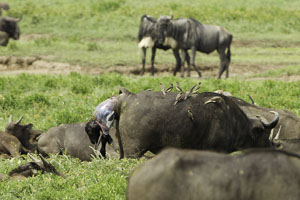 an African Buffalo in the beginning stage of birthing, with a reddish balloon protruding from her backside. It took 44 minutes until the baby finally dropped, and while the birthing occurred the calf looked listless or dead. We’ll never know, as the cow dropped the calf in vegetation that hid it from our view, and for nearly 40 minutes we could see her licking the baby, but never saw any evidence of movement. In the last twenty minutes the cow wandered about, as far as twenty feet away, and we suspected that the calf might indeed be dead. None of our guides had ever seen a buffalo give birth, so estimates ranged from ten minutes to two hours before a calf would stand, but we saw no movement at all.
an African Buffalo in the beginning stage of birthing, with a reddish balloon protruding from her backside. It took 44 minutes until the baby finally dropped, and while the birthing occurred the calf looked listless or dead. We’ll never know, as the cow dropped the calf in vegetation that hid it from our view, and for nearly 40 minutes we could see her licking the baby, but never saw any evidence of movement. In the last twenty minutes the cow wandered about, as far as twenty feet away, and we suspected that the calf might indeed be dead. None of our guides had ever seen a buffalo give birth, so estimates ranged from ten minutes to two hours before a calf would stand, but we saw no movement at all.
We drove on, now close to noon, and found a Tawny Eagle feeding upon the remains of an Abdim’s Stork which, we were later told, a Caracal had killed and then deserted. Continuing towards our lunch spot we filmed several gnu babies and a less than two day old zebra foal. Lunch didn’t occur to after 1:30, and afterwards we headed back into the plains where we had a fairly close Black Rhino, the same female that had been mating yesterday.
 Later we discovered another Golden Jackal den, with three pups close to the road tussling over an Abdim’s Stork feather. The pups were close enough to be frame-filling. Another Rhino passed by in the distance and our guide wanted to follow it, and in doing so we encountered one of the adult Golden Jackals returning with the back end of another stork. We immediately turned around and raced back to the den, but the adult took a different route and delivered the carcass far from the road. There the pups wrestled until one took possession of the bird and ran away.
Later we discovered another Golden Jackal den, with three pups close to the road tussling over an Abdim’s Stork feather. The pups were close enough to be frame-filling. Another Rhino passed by in the distance and our guide wanted to follow it, and in doing so we encountered one of the adult Golden Jackals returning with the back end of another stork. We immediately turned around and raced back to the den, but the adult took a different route and delivered the carcass far from the road. There the pups wrestled until one took possession of the bird and ran away.
We headed back to the Table Mountain area, where we spotted a distant Serval, and great Secretary Birds by the leopard lugga. With only forty minutes left to the day we found a female Grant’s Gazelle with unusual down-pointed horns that formed a heart-shaped crescent around her face, with the tips of her horns actually piercing into her muzzle. As we left the crater we had our most cooperative Black-backed Jackal, and a pair of Warthogs that were so close to be frame-filling head shots. In all, on one camera I shot 58gb!
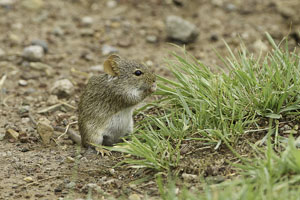
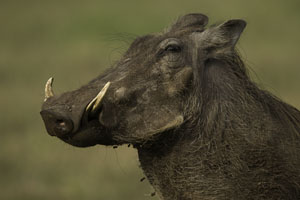
While mice and rats form the foundation of the food chain they are rarely see, while larger herbivores, like warthogs, are very conspicuous.
Day 5. Ngorongoro Crater to Ndutu Camp, NCA
We left our camp at 6:40 for the four-five hour drive to our next camp, although that planned wasn’t really followed. Originally, we’d contemplated dropping into the Crater for the first two hours and then heading west, but we amended that, and thought we might do the Crater if we had clear skies. We changed that, again, to simply leave early, and fortunately we stuck with that plan as the skies were dreary and overcast and the light in the crater would have been poor.
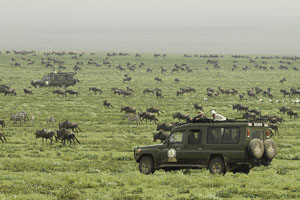 We headed west into the Ngorongoro Conservation Area (NCA) and soon were into one of the largest congregations of gnus we’d ever seen. Animals extended half a mile deep and from horizon to horizon, and just basing our estimate on what a football stadium of 100,000 people might look like, we figure we’d seen over 1 million animals. Birthing seemed to be at its peak, and bloody sacks of placentas dotted the plains, the afterbirths of the multiple births. We spotted several that were about to give birth, with either balloon-like sacks of amniotic fluid or tiny legs protruding from the female’s butts. Although birthing was imminent, the entire process still took hours, and surprisingly the females appeared to be suffering a great deal of discomfort, getting up and changing positions, squeezing and pushing, standing, lying down, all signs of a lot of stress.
We headed west into the Ngorongoro Conservation Area (NCA) and soon were into one of the largest congregations of gnus we’d ever seen. Animals extended half a mile deep and from horizon to horizon, and just basing our estimate on what a football stadium of 100,000 people might look like, we figure we’d seen over 1 million animals. Birthing seemed to be at its peak, and bloody sacks of placentas dotted the plains, the afterbirths of the multiple births. We spotted several that were about to give birth, with either balloon-like sacks of amniotic fluid or tiny legs protruding from the female’s butts. Although birthing was imminent, the entire process still took hours, and surprisingly the females appeared to be suffering a great deal of discomfort, getting up and changing positions, squeezing and pushing, standing, lying down, all signs of a lot of stress.
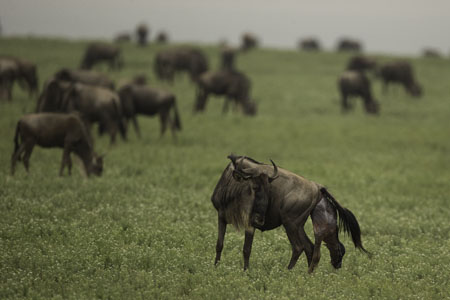 One female stayed along the edge of the herd and presented a good show, standing up when the baby was half out and only lying back down as the baby slipped free. While we didn’t record the time for the delivery, 9 minutes went by until the baby finally stood. At 6 minutes the baby tried to stand, at six and a half the baby half stood and ran forward, only to fall on its head. And, after its rest, standing at nine. The female laid down next, with the baby circling and coming face-to-face, but when the female rose she butted the baby, and as it tried to nurse was pushed away. Frequently finding the teats is a challenge, but this baby was headed in the right direction but prevented from doing so, and I thought that at any moment the baby might be hooked, horned, and tossed. After 15 minutes the baby was allowed to nurse and all went as normal after that.
One female stayed along the edge of the herd and presented a good show, standing up when the baby was half out and only lying back down as the baby slipped free. While we didn’t record the time for the delivery, 9 minutes went by until the baby finally stood. At 6 minutes the baby tried to stand, at six and a half the baby half stood and ran forward, only to fall on its head. And, after its rest, standing at nine. The female laid down next, with the baby circling and coming face-to-face, but when the female rose she butted the baby, and as it tried to nurse was pushed away. Frequently finding the teats is a challenge, but this baby was headed in the right direction but prevented from doing so, and I thought that at any moment the baby might be hooked, horned, and tossed. After 15 minutes the baby was allowed to nurse and all went as normal after that.
We just missed two births, with the first occurring too far away to shoot. We drove closer, and although we didn’t time it we suspected that only three or four minutes, at most, had passed.. When we saw the baby it was still just weaving its head about but it stood, breaking the whitish birth sack, and immediately followed the mother. This occurred almost immediately, and we figure no more than four minutes, total, from birth to walking away with the mother had elapsed.
Another gun in the distance was struggling to deliver but we left her to have our picnic lunch where, on the open plain, we found several Dung Beetles rolling dung balls. A few years ago I had dug up a few beetles after they disappeared beneath the soil, finding that the adult was lying in a death-like state. After a few minutes the adult revived, and when placed on the ground the beetle headed directly back towards the site where it had been buried.
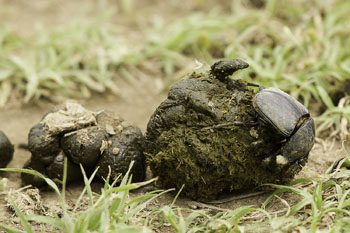 Two different types of dung beetle seemed to be active today, with one rolling dung and the other simply burying the dung under some soil. I scraped several of the latter free, and found only one small scrap of dung, although one of our guides did so and we found one beetle. This too seemed dead, but after a few minutes revived, and when placed on the ground made a few circles before heading in the direction of its dung ball.
Two different types of dung beetle seemed to be active today, with one rolling dung and the other simply burying the dung under some soil. I scraped several of the latter free, and found only one small scrap of dung, although one of our guides did so and we found one beetle. This too seemed dead, but after a few minutes revived, and when placed on the ground made a few circles before heading in the direction of its dung ball.
We watched a ‘traditional’ dung beetle pair inter their dung ball, and while we waited the adults disappeared and did not reappear. Another dung ball was being rolled by a single adult, followed closely behind by another which may have been its mate or a rival male intent on stealing the ball. Whatever, at one point the second caught up, but the first rolled the ball away and in doing so lost its pursuer. Later, that beetle took to the air and soon located the dung ball, landed, and took possession.
I still don’t know whether the adults, disappearing with the dung ball, die beneath the soil like salmon that spawned up river and then expired, or simply go into an aestivation state. We wondered how the beetles suddenly appeared when fresh dung was present, since we rarely saw beetles flying about. Could they be beneath the soil, with their last buried ball of dung, and sense (or smell) fresh dung and reemerge? I haven’t read anything on this and, at least for now, the mystery continues.
We continued on to the Ndutu forest where we photographed Lionesses, 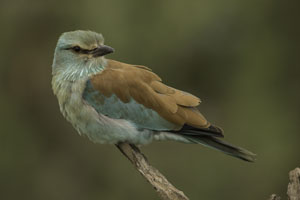 European Rollers, Tawny Eagles, Lovebirds, Masai Giraffe, Elephant, and the streams of migration Gnus racing through the forest. Around 5 we learned of a mother Cheetah with tiny young still sporting their silver mane and resembling a Honey Badger (which we saw on the Crater rim this morning) and thus perhaps protected since these badgers are notoriously bad-tempered. By the time I arrived the cheetahs were slinking into the high grass of a marsh, as 8 lions were visible about a quarter mile away. They never reappeared, but as we drove to our next camp we passed another female Cheetah and two young adults, still sporting their juvenile mane.
European Rollers, Tawny Eagles, Lovebirds, Masai Giraffe, Elephant, and the streams of migration Gnus racing through the forest. Around 5 we learned of a mother Cheetah with tiny young still sporting their silver mane and resembling a Honey Badger (which we saw on the Crater rim this morning) and thus perhaps protected since these badgers are notoriously bad-tempered. By the time I arrived the cheetahs were slinking into the high grass of a marsh, as 8 lions were visible about a quarter mile away. They never reappeared, but as we drove to our next camp we passed another female Cheetah and two young adults, still sporting their juvenile mane.
Our next camp is beautiful, and our tent is nearly 100 yards from the dining area, with each tent spaced about 20 yards apart. Caracals and Servals have been spotted just in front of the tents, and as we walked to diner this evening Lions roared nearby.

Day 6. Ndutu
 We awoke to a thick fog, with trees and the tents before us hidden in the thick mist. Occasionally the fog parted sufficiently that a star briefly glowed, but those moments were few. The first two hours of the game drive were interesting, and we spent time lining up the spectral shapes of Tortillus Acacia trees as stacked silhouettes, with the more distant ones progressively disappearing in the fog.
We awoke to a thick fog, with trees and the tents before us hidden in the thick mist. Occasionally the fog parted sufficiently that a star briefly glowed, but those moments were few. The first two hours of the game drive were interesting, and we spent time lining up the spectral shapes of Tortillus Acacia trees as stacked silhouettes, with the more distant ones progressively disappearing in the fog.
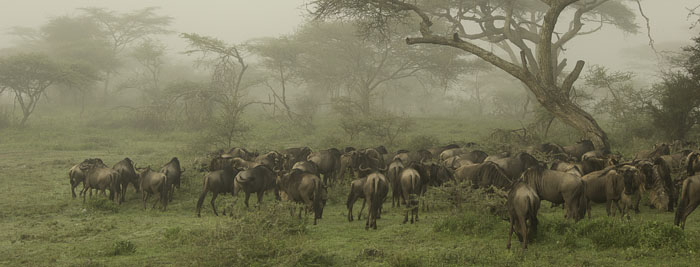 Four Cheetahs were spotted almost immediately, two pairs of subadults that we wondered might be part of the same litter, and might even still be together at times. Both were hunting, with one pair intently so, stalking towards two different sets of gnus. Interestingly, both pairs frequently explored and climbed trees, only to eight feet or so, but unique nonetheless.
Four Cheetahs were spotted almost immediately, two pairs of subadults that we wondered might be part of the same litter, and might even still be together at times. Both were hunting, with one pair intently so, stalking towards two different sets of gnus. Interestingly, both pairs frequently explored and climbed trees, only to eight feet or so, but unique nonetheless.

The cats spotted a distant herd of gnus and zebras adjacent to the swamp and started stalking. We drove ahead, hoping that the cats would precipitate a stampede into the open bottomland. They did not, and instead the herd 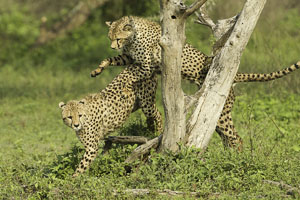 charged off, away from us, and we raced ahead, eventually finding both cheetahs on a baby gnu. While we photographed the two grabbed the baby, one at the throat, the other at the hind quarters, and carrying the gnu aloft carried it into the shelter of the brush. We left it soon after, not interested in the feeding and hoping to avoid the congestion of vehicles that soon gathered, at least 17 at one point.
charged off, away from us, and we raced ahead, eventually finding both cheetahs on a baby gnu. While we photographed the two grabbed the baby, one at the throat, the other at the hind quarters, and carrying the gnu aloft carried it into the shelter of the brush. We left it soon after, not interested in the feeding and hoping to avoid the congestion of vehicles that soon gathered, at least 17 at one point.
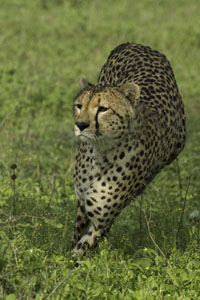
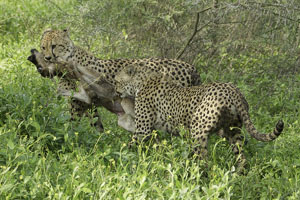
The cheetah with small cubs was in the same spot as we’d seen them last evening, but a vehicle had attempted to get close and was deeply mired in the mud. Another vehicle tried freeing it and got stuck, and then two other vehicles drove in, with one freeing the first vehicle, which then tried pulling the second out by gunning forward with the chain attached. Naturally the chain broke, and luckily the windshield of the stuck vehicle was not struck, or anyone inside. About an hour later the second vehicle was freed, by another vehicle coming to its rescue. A short time later, the driver of one of the two stuck vehicles mired himself once again, and the process had to be repeated. We drove on.
 The rest of the morning was fairly uneventful as we searched for another lion pride and cheetah family, although Sue and Tom’s vehicle had a great serval, and Sue caught it in mid leap as it jumped over the tall grasses. Mary found a fresh zebra birth, with a dead baby, and a mother that nudged and guarded it, walking off at times but then returning. Eventually the mother wandered off, stopping about sixty yards away to gaze back at her foal. Nubian Vultures perched nearby, soon to have a meal.
The rest of the morning was fairly uneventful as we searched for another lion pride and cheetah family, although Sue and Tom’s vehicle had a great serval, and Sue caught it in mid leap as it jumped over the tall grasses. Mary found a fresh zebra birth, with a dead baby, and a mother that nudged and guarded it, walking off at times but then returning. Eventually the mother wandered off, stopping about sixty yards away to gaze back at her foal. Nubian Vultures perched nearby, soon to have a meal.
PM. We originally planned on a 3:30 departure but at lunch it clouded over and I moved our time to 3, and soon after it cleared once again. Instead, we dallied with tea and drinks for twenty minutes, fun socializing actually, before departing. Cheetahs had been spotted by Ndutu lake and we headed there, soon finding a single cheetah sitting on top of a low mound. Mary was with another pair, a mother with a nearly full-grown young, and the shooting was good so we changed cats, arriving just as the pair settled down to mutually groom one another.
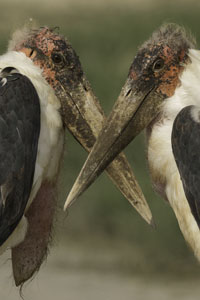 En route, Jim and I photographed Maribou Storks close to the road. These were courting and beginning nest building activities, picking up sticks and transferring them to their mates, and mutually preening each other. We were so close that portraits of that activity was possible, and rewarding.
En route, Jim and I photographed Maribou Storks close to the road. These were courting and beginning nest building activities, picking up sticks and transferring them to their mates, and mutually preening each other. We were so close that portraits of that activity was possible, and rewarding.
After the cheetahs we headed towards the forest but a pride of six Lioness, two lionesses and four cubs, stopped us for an hour as they nursed and tempted us with half-hearted play. Mary left early to look for leopards, unsuccessfully, but eventually we all abandoned the lions when, after nursing, the cubs and the adults fell fast asleep.
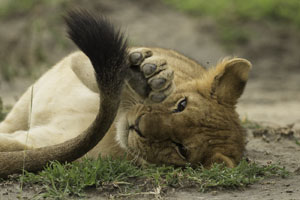
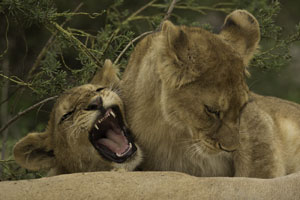
In our last hour we photographed two large nursery herds of Gnus, where almost every adult had a calf in tow, an excellent Black-chested Snake Eagle, and a den of surprisingly shy (for this area) Bat-eared Fox. Surprisingly, there were young pups at the den but they were shy and darted into the den, while one adult stayed out and another, an older juvenile, appeared briefly. Mary recalled seeing this before but I did not, seeing three different age groups, obviously an adult pair that were the parents of the young pups, and the teen-age foxes that were also at the den.
Day 7. Ndutu
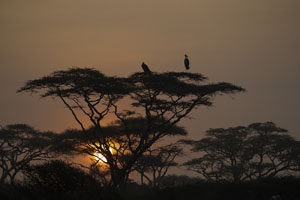
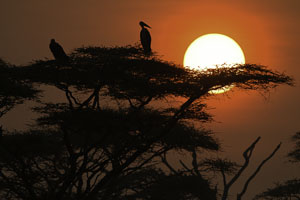
Today was a definitive Cheetah day, one of the best. We intended to visit Hidden Valley, a magical depression that appears, unannounced, in the middle of the lower Serengeti plains. After skirting Lake Ndutu, where we photographed Maribou Storks against a red sunrise, we moved onto the plains. En route, my vehicle had a surprisingly cooperative pair of Bat-eared Foxes, surprising because out in the middle of the plains the likelihood that they’d been visited often enough to be habituated is very slim. Another, larger family group later on were more typical, darting off as soon as we stopped the ‘rover. Spotted Hyenas slunk across the grasslands on their way home from a night’s foraging, and we photographed one pair that were finishing off the skull of a Gnu, carrying it off as we approached.
Bill’s vehicle had a Cheetah that chased after a Zebra foal, but the distance was too great and the protective mother discouraged a serious hunt. We encountered the same Cheetah a short time later, after spending some time following another female that we thought might be returning to small cubs. When we reached the cheetah she was obviously intent on finding game, sitting upright and scanning the horizon. The other vehicles had continued on to Hidden Valley, which proved to be a disappointment with no large herds around the water.
 Our Cheetah stood, and started walking towards a distant herd of Grant’s Gazelles but had only traveled a short distance when she kicked up an African Hare. She pursued it immediately, as the hare zig-zagged about, keeping ahead of the cheetah as, whenever she drew near, she’d try to trip the hare with an outstretched paw. Doing so, she lost speed, and the hare raced ahead. Using our camera’s metadata we could time the entire chase, which lasted 33 seconds, a very long time for a cheetah run and one that ended unsuccessfully as the cheetah simply ran out of steam.
Our Cheetah stood, and started walking towards a distant herd of Grant’s Gazelles but had only traveled a short distance when she kicked up an African Hare. She pursued it immediately, as the hare zig-zagged about, keeping ahead of the cheetah as, whenever she drew near, she’d try to trip the hare with an outstretched paw. Doing so, she lost speed, and the hare raced ahead. Using our camera’s metadata we could time the entire chase, which lasted 33 seconds, a very long time for a cheetah run and one that ended unsuccessfully as the cheetah simply ran out of steam.
Although the cheetah was exhausted we stayed with her and our other three vehicles joined us, leaving Hidden Valley for a possible hunt. Nearly an hour passed before the cheetah resumed hunting, moving in spurts towards a distant herd of Grant’s Gazelles. When she decided to hunt, she scuttled closer, running a very short distance before setting back down, wiggling to get her hind legs tucked beneath her for a charge. She began this stalk at 10:39:03, moving forward and sometimes looking about, presumably to look for pesky hyenas but making us wonder if she was truly serious. At 11:21:15 she began a serious stalk, aimed at a pair of young Grant’s Gazelles that were now standing and visible. She moved closer in quick little bursts, then started her charge two minutes later, at 11:23:26. Three times it looked as if she had tripped up the young gazelle, but for the first two of gazelle regained its feet and continued running. On the third trip, or slip as is often the case, the cheetah caught the kid, at 11:23:52, twenty-six seconds later.
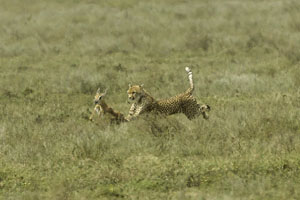 10:39:03 started the hunt
10:39:03 started the hunt
11:21:15 serious stalk
11:23:26 started the charge
11:23:52 knock down
We stayed with the cheetah while she regained her breath, and at fifty feet we could clearly hear her panting. We shot some nice images as she grabbed the kid by the throat and carried it to some thicker vegetation, where we left her to feed as we continued driving back to camp.
PM. We hoped to find leopards or the cheetah family with small cubs, and drove through the Ndutu forest and into the plains. We found two of the Cheetah males from yesterday morning, and they were thin and hungry, and obviously hunting but no game was nearby. We had a radio call that a Cheetah with cubs was spotted and we left, passing another Cheetah lying in the grass with a few vehicles in attendance. Ten minutes later we arrived, to find a mother Cheetah with two very young cubs, still with the full white mane that makes the babies resemble the formidable Honey Badger. Mary was in a perfect position with a great window to where the mother lay, but all of our vehicles had good shooting as the two cubs changed positions constantly, exploring or wrestling or climbing on top of the mother. She cooperated too, coming out into clear view to lie down for a few minutes before us, with the cubs clambering about.
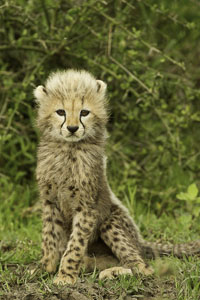

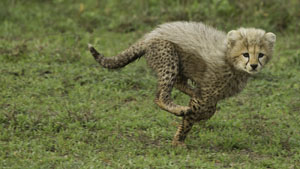
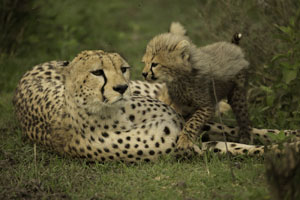
The cheetah eventually moved out into the open savannah, where vehicles kept a respectful distance after one tourist vehicle tailed behind, too closely, and spooked one of the babies into a long, dangerous run ahead. Luckily she returned, and from that point on everyone kept their distance. Three of our vehicles had had great shooting earlier and moved on, while Tom and I remained, hoping for more action but the cheetah mother slept and nursed, while the babies suckled or slept.
The other vehicles returned to the forest where Sue, Randy, and Jim had a mother Lioness and cub climb a tree in the last light of the day, and the others saw that the two male Cheetahs had made a kill in the interim, capturing a Gnu calf. In all, we had 6 Cheetahs this evening, and 4 this morning, for a total of 13 Cheetahs in this area in two days.
Day 8. Ndutu
We left camp at 6:30 for an all-day game drive, after packing for our transfer to our next camp at Naabi Hills. The sky was overcast and dreary as we headed through the forest looking for leopards, and passing the two Cheetah brothers we’d seen yesterday. Today, they were lying on a bank, relaxed and, for our now satiated tastes, not too tempting. A trio of the endemic Gray-breasted Spurfowl stopped us for a short time, providing nice portraits of this chicken-like bird that seems a cross between a red-necked and the yellow-necked spurfowl.
 We received a radio call that Lions were at a kill and all of us congregated there, and for the new people it was exciting but my vehicle, with veterans, passed on the scene and the mob of vehicles around it. Shortly after, our guide spotted a Cheetah in the distance, which proved to be the same mother with small cubs we had last night. The cheetah was hunting, and we had several opportunities to photograph the three as they walked through the grasses or towards us on the dirt track. At one point, our guide, taking a huge risk, did a wide detour to be at a spot where, if the cheetahs crossed a lugga, we’d be in position.
We received a radio call that Lions were at a kill and all of us congregated there, and for the new people it was exciting but my vehicle, with veterans, passed on the scene and the mob of vehicles around it. Shortly after, our guide spotted a Cheetah in the distance, which proved to be the same mother with small cubs we had last night. The cheetah was hunting, and we had several opportunities to photograph the three as they walked through the grasses or towards us on the dirt track. At one point, our guide, taking a huge risk, did a wide detour to be at a spot where, if the cheetahs crossed a lugga, we’d be in position. 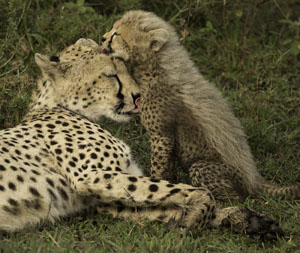 The cheetah did just that, and then laid down in the open with a cub joining her to mutually groom. We were, truly, in a perfect spot, when one of the Film Crew vehicles we’d seen the last few days, and who have been particularly obnoxious with speeding through the grasslands and forests, crossed the lugga close to the cheetahs. To do so required a lot of engine gunning and banging, and our cheetah was disturbed, got up, and continued on its way. This behavior, on the part of the driver and the film guy, was so blatantly callous, unconcerned either for anyone else watching or, most importantly, how his rash behavior might affect the cheetahs, that one has to question the validity or value of some of these films. That’s a sad thought on my part.
The cheetah did just that, and then laid down in the open with a cub joining her to mutually groom. We were, truly, in a perfect spot, when one of the Film Crew vehicles we’d seen the last few days, and who have been particularly obnoxious with speeding through the grasslands and forests, crossed the lugga close to the cheetahs. To do so required a lot of engine gunning and banging, and our cheetah was disturbed, got up, and continued on its way. This behavior, on the part of the driver and the film guy, was so blatantly callous, unconcerned either for anyone else watching or, most importantly, how his rash behavior might affect the cheetahs, that one has to question the validity or value of some of these films. That’s a sad thought on my part.
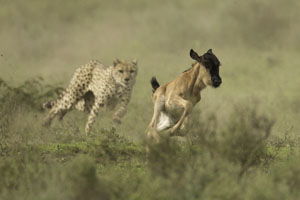
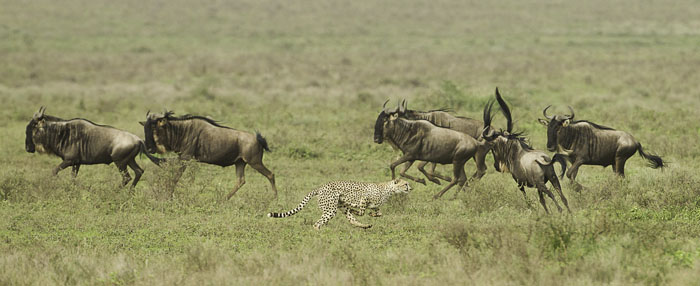
We continued to follow the cheetahs, and positioned ourselves opposite a long line of Gnus where, at its end, several babies ran with their mothers. As one group ran by our mother cheetah charged, and the two ran directly towards our vehicle, in the complete open in low grass or bare ground. I had guessed that when she charged the mother gnu, instead of guarding the baby, would be overcome by the herd instinct and panic, and would run, leaving the baby to its fate. I was wrong, and instead the mother charged after the cheetah, breaking up the chase and our chance at some truly spectacular shots. A few seconds later the cheetah charged another mother/calf pair, but was unsuccessful as well. Meanwhile, the tourists vehicles around had displayed such disregard for the hunt, or giving space to the cheetahs, that we were disgusted and chose to head off to the Matiti area where we’d be alone. We drove off.
We were headed in the direction where African Wild Dogs had been spotted but we had no luck, although we encountered huge herds of gnus, and one orphan that ran up to me and circled several times when I got out of the 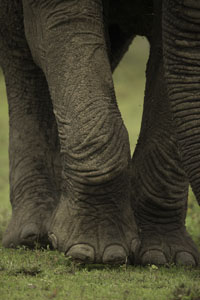 vehicle. A bull Elephant strode directly to us, giving great portraits, and another mother-daughter pair of Cheetahs provided us with some nice shooting in the latter part of the afternoon.
vehicle. A bull Elephant strode directly to us, giving great portraits, and another mother-daughter pair of Cheetahs provided us with some nice shooting in the latter part of the afternoon.
It rained, and we closed our roof hatches for a short time, while our vehicles skidded through the slick black cotton soil. Mary’s vehicle actually did a 180 degree spin, and another time almost slid into a small tree but the surrounding brush buffered the collision and they slid past. We continued toward our next destination at Naabi Hill, stopping at Lake Ndutu where several herds of Gnus were passing, with one large group appearing to be ready to cross this shallow alkaline lake. While we waited several adults entered the water and began a slow wade across the shallows, while my vehicle did a fast race around the back end of the lake to join our other vehicles on the other side, waiting for the gnus. They crossed, in a long, snaking line, with most simply walking while the younger gnus swam through the center portion of the lake. About four-fifths of the herd had crossed when a bird spooked the remainder, with the leaders suddenly turning and crashing through the water, driving the remaining gnus back the way they had come. The herd skirted the lake shore at that point and we drove on.
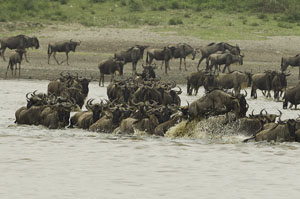
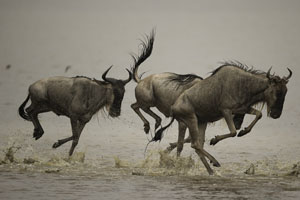
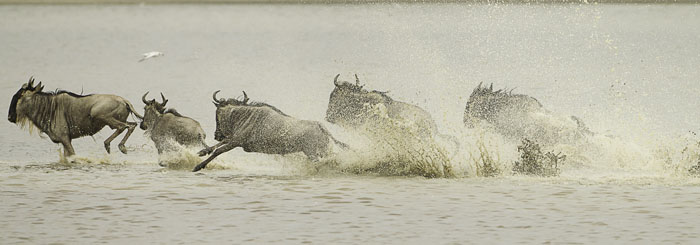
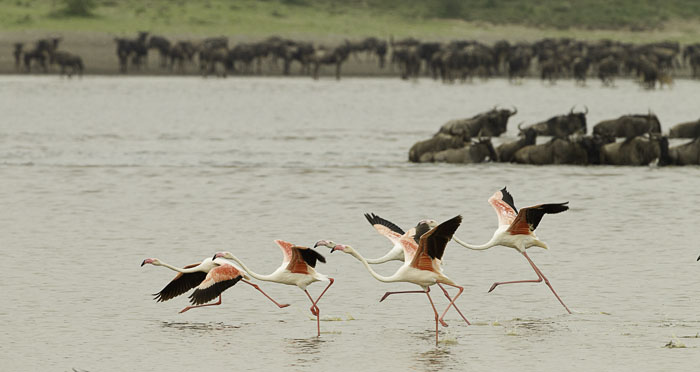
An enormous Gnu herd spread across the Ndutu plains, rivaling the numbers we’d seen a few days earlier when we first entered the NCA. After a few miles the herd ended, but a new herd of several hundred Grant’s and Thompson’s Gazelles took their place, and a short while later another enormous Gnu herd appeared, stretching to the distant Gol Kopjes and beyond. We reached camp by 5:30, tired but extremely satisfied with a very rewarding day.
Day 9. Gol Kopjes
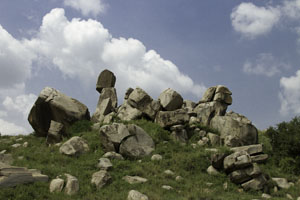 Life can be very short in the Serengeti, measured in minutes. We were watching a male Cheetah lying on top a high kopje, nearly silhouetted against the sky and not any type of pleasing image. We were about to leave and head for home when it sat up and looked beyond us. Mary glassed the plains and a little over a quarter mile away a Grant’s Gazelle had just given birth and was licking the baby. In the grasses the baby, which stands no higher than 18 inches, was barely visible through binoculars, but the cheetah saw and recognized the baby and strode leisurely off the rock wall. We headed ahead, as a game track led parallel to the gazelle. From there we watched the cheetah walking confidently the first third, then moving in spurts, often hunkered low and stalking, rushing a few feet before pausing, sometimes almost in the beginning of a step. The cheetah covered the second third in this way before beginning a run, as the gazelle, until then unaware, led its baby into the grasslands. When the charge came the gazelle bolted and the baby, instinctively, dropped to the ground, but the cheetah was there and captured it without a run or struggle. A few minutes later the cheetah carried the baby further into the grasses, where we lost track.
Life can be very short in the Serengeti, measured in minutes. We were watching a male Cheetah lying on top a high kopje, nearly silhouetted against the sky and not any type of pleasing image. We were about to leave and head for home when it sat up and looked beyond us. Mary glassed the plains and a little over a quarter mile away a Grant’s Gazelle had just given birth and was licking the baby. In the grasses the baby, which stands no higher than 18 inches, was barely visible through binoculars, but the cheetah saw and recognized the baby and strode leisurely off the rock wall. We headed ahead, as a game track led parallel to the gazelle. From there we watched the cheetah walking confidently the first third, then moving in spurts, often hunkered low and stalking, rushing a few feet before pausing, sometimes almost in the beginning of a step. The cheetah covered the second third in this way before beginning a run, as the gazelle, until then unaware, led its baby into the grasslands. When the charge came the gazelle bolted and the baby, instinctively, dropped to the ground, but the cheetah was there and captured it without a run or struggle. A few minutes later the cheetah carried the baby further into the grasses, where we lost track.
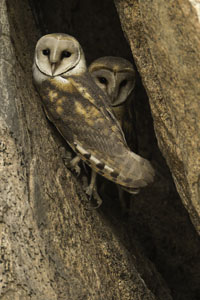 We started our morning with a 5:30AM breakfast and 6AM departure, in near darkness, reaching the first kopje after sunrise, had we had one. The skies were gloomy and the light low, although some photographed the Barn Owl that usually resides in a long vertical crevice in one of the larger rocks. Earlier, we found a Cheetah mother and large cub, and sadly the cub had either a sprained or broken front leg, at the wrist, and limped along. Yesterday, I’d seen a three legged Spotted Hyena, missing its left hind leg, but the hyena was running along at what seemed like a normal speed. For a cheetah, however, a permanent injury is a death sentence, and we could only hope that this was a sprain and the cat would recover.
We started our morning with a 5:30AM breakfast and 6AM departure, in near darkness, reaching the first kopje after sunrise, had we had one. The skies were gloomy and the light low, although some photographed the Barn Owl that usually resides in a long vertical crevice in one of the larger rocks. Earlier, we found a Cheetah mother and large cub, and sadly the cub had either a sprained or broken front leg, at the wrist, and limped along. Yesterday, I’d seen a three legged Spotted Hyena, missing its left hind leg, but the hyena was running along at what seemed like a normal speed. For a cheetah, however, a permanent injury is a death sentence, and we could only hope that this was a sprain and the cat would recover.
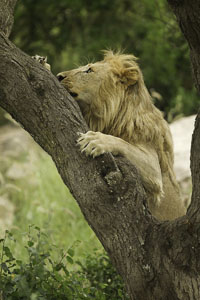 At another kopje we found three Lion cubs, a lioness, and a golden maned large male. The shooting was marginal until the male approached an acacia tree and, to our complete surprise, climbed up into the lower branches, about 12 feet or so. We have never seen a male in a tree, and it was a bit comical to watch as the lion reversed directions and tried getting back down. It did so with little grace.
At another kopje we found three Lion cubs, a lioness, and a golden maned large male. The shooting was marginal until the male approached an acacia tree and, to our complete surprise, climbed up into the lower branches, about 12 feet or so. We have never seen a male in a tree, and it was a bit comical to watch as the lion reversed directions and tried getting back down. It did so with little grace.
Later we found two black-maned Lions, one sitting upright the other sleeping, atop a low kopje that overlooked the grasslands and a distant Naabi Hill. It was an iconic shot, made humorous, however, when the sleeping lion urinated without stirring, with the puddle flowing downhill and beneath the cat’s outstretched tail.
One of our vehicles spotted a Honey Badger or Ratel, but it was running and continued doing so until it reached a burrow, where it disappeared. We waited a few minutes but it was fruitless and we drove off. In another kopje 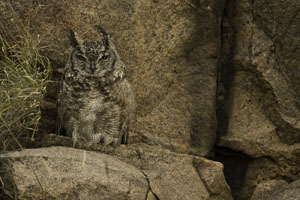 a Spotted Eagle Owl was spotted and photographed by everyone. The owl is a dead ringer of our Great Horned Owl, and I’d bet showing an image to a US birder they’d identify it as such without hesitation. The owl perched in the grasses in front of a small crevice which was probably its normal roost.
a Spotted Eagle Owl was spotted and photographed by everyone. The owl is a dead ringer of our Great Horned Owl, and I’d bet showing an image to a US birder they’d identify it as such without hesitation. The owl perched in the grasses in front of a small crevice which was probably its normal roost.
Denny and Deb had a Lioness chase a Bat-eared Fox which also escaped into a hole, and as we drove back to camp I photographed a Martial Eagle perched in an acacia. On the way home we stopped again at the Barn Owl rock, where now two stood in the crack low and closer to the opening, providing the best opportunity I’ve had with these birds. Barn owls looks very similar to a rarer species, the Marsh Owl, and my guide thought it was the latter until convinced otherwise. Interestingly, the two best field guides show two different views of the two species, emphasizing or dismissing certain points in one book and not the other, compounding the problem. I’d seen enough barn owls to know the difference.
PM. Gol Kopjes
By 2PM a thunderstorm rolled in and for the next 1.5 hours in rained, hard. We postponed our afternoon game drive until 4, worried that the dirt track to the kopjes would be nearly impossible but the rains were localized and the kopjes and area around them were almost completely dry. We found many of the same subjects as this morning – the owls were in the crack, the lions were lying on the rocks, and the Martial Eagle was perched in an acacia. The two male Lions had moved, and were now feeding upon a Topi carcass. In the morning the lions had some blood on their fur, which we presumed was from a previous kill, not a current meal, but they had been merely resting between courses in late morning.
Although the storm had cleared the western horizon was still lost in murk and the sun disappeared behind a wall of haze, although it was still light at 6:50 when we returned to camp.
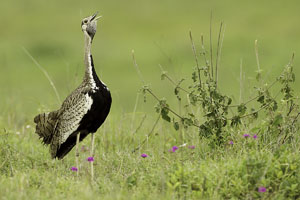
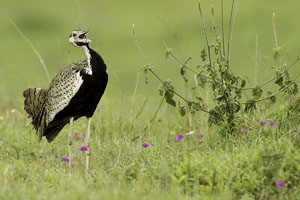
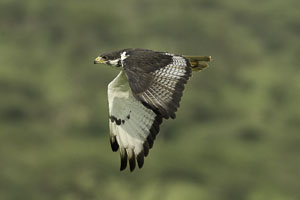
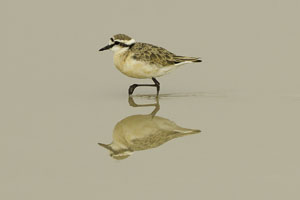
Birds of the Serengeti: A Black-bellied Bustard gives its chirp and hiccup;
Augur Buzzard in flight; Kittlitz's Plover.
Day 10. Simba Kopjes
We started out in our usual gloom, heading north and having to wait at the Park Gate for a sleepy guard to open the chain blocking access into the park, he being only twenty minutes for duty. Gnu herds stretched north of Naabi Hill and as we descended a Spotted Hyena was working the gnu herds. As we watched the hyena isolated a baby gnu who ran away from the herd while the hyena, in its steady rocking lope, continued to gain ground. The baby gnu hit the road and I hoped would run towards us, on the hard surface and towards the herd, but instead it ran up the bank, losing ground, and the hyena closed, grabbing it from behind and stopping it. The hyena began feeding immediately, with the baby’s legs flailing, but fortunately that didn’t last long and the hyena picked up the carcass and trotted off into the grasses.
We continued, and at the first of the many rock piles comprising the Simba Kopjes we found two Servals high atop the larger rock. It took a moment for us to register what we were seeing, and my first thought was African wild cat. The cats didn’t linger and jumped down as we approached, although one popped its head out of the bushes and chirped for the other, which I presume was its large kitten. This was the FIRST TIME I’ve ever seen a serval on top of anything, a termite mound, log, or rock, and certainly not fifteen feet up a kopje!
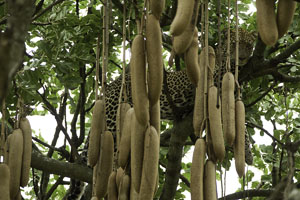 We continued, and along the lugga that snakes towards Moru Kopjes Mary’s vehicle spooked a Leopard lying beneath a tree. The leopard ran off into the grasses but, oddly, it wasn’t shy after that initial run. Instead the leopard walking directly towards a distant sausage tree, giving us fairly decent side shots. At the tree it leaped and climbed, pausing for a few minutes in full view before practically disappearing among the leaves and hanging sausage fruits. We took a few shots there and moved on, continuing another
We continued, and along the lugga that snakes towards Moru Kopjes Mary’s vehicle spooked a Leopard lying beneath a tree. The leopard ran off into the grasses but, oddly, it wasn’t shy after that initial run. Instead the leopard walking directly towards a distant sausage tree, giving us fairly decent side shots. At the tree it leaped and climbed, pausing for a few minutes in full view before practically disappearing among the leaves and hanging sausage fruits. We took a few shots there and moved on, continuing another 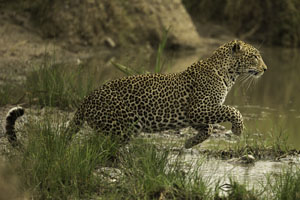 mile or so before U-turning and returning. As we approached the tree the Leopard was climbing back down, dropping to the ground and out of sight. As we drove closer I was surprised to find the leopard almost beside us in the grass, walking opposite our direction of travel. We turned again, drove ahead, and followed the leopard. The big male walked to a shallow pool and drank, in full view, then leaped across the channel, presenting another wonderful series of shots. We headed home.
mile or so before U-turning and returning. As we approached the tree the Leopard was climbing back down, dropping to the ground and out of sight. As we drove closer I was surprised to find the leopard almost beside us in the grass, walking opposite our direction of travel. We turned again, drove ahead, and followed the leopard. The big male walked to a shallow pool and drank, in full view, then leaped across the channel, presenting another wonderful series of shots. We headed home.
PM. Gol Kopjes
We returned to the Gol kopjes, and en route found three Jackson’s Bustards (aka Denham’s) close to the main road. I’ve never seen this species in the Serengeti, nor has one of our most experienced guides, and I’d last seen one years ago, in film days, in the northern Masai Mara in Kenya. The trio consisted of a juvenile and two adults. At the Barn Owl rocks we found the mother Cheetah with the lame cub. They were resting close to the road but eventually retreated a little further onto the slope, but with no game in sight we left the very, very hungry cheetahs.
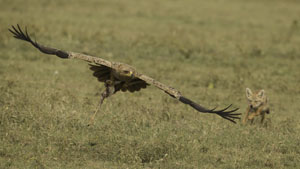 After checking several kopjes we spotted a pair of Golden Jackals feeding on a Thompson’s Gazelle baby they had torn in half. We approached, and the female picked up her half and trotted a short distance away. From out of nowhere a Tawny Eagle swooped down and snatched her kill, and although I shot a nice series as the eagle flew towards us carrying the kill, I missed a wonderful shot as the Jackal leaped into the air, trying to snatch the kill back from the eagle. With 800mm I was just too tight, and had I used my zoom …. I’d have had it.
After checking several kopjes we spotted a pair of Golden Jackals feeding on a Thompson’s Gazelle baby they had torn in half. We approached, and the female picked up her half and trotted a short distance away. From out of nowhere a Tawny Eagle swooped down and snatched her kill, and although I shot a nice series as the eagle flew towards us carrying the kill, I missed a wonderful shot as the Jackal leaped into the air, trying to snatch the kill back from the eagle. With 800mm I was just too tight, and had I used my zoom …. I’d have had it.
We found the Lioness we’d seen yesterday, still in the same kopje, and now lying on her back, exposing prominent nipples that I believe indicates she is about to give birth at this chosen rock pile. Five lions were asleep atop another kopje, as was one of the male lions from yesterday, on still another kopje.
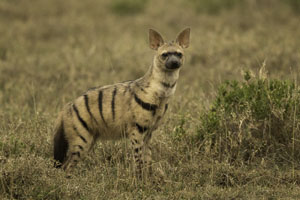 As we headed back to camp our lead vehicle encountered an Aardwolf, a species we’ve seen in this area before but very rare. Aardwolves normally feed upon termites, and this one meandered about, allowing a fairly close approach. In fact, at the end of the shoot the aardwold walked straight up to Mary’s vehicle, giving her frame-filling shots. As we drove home the same? or a different aardwolf ran towards us and disappeared into a den quite close to the road, and a mile further on another stood on the road – making a possible three for the day.
As we headed back to camp our lead vehicle encountered an Aardwolf, a species we’ve seen in this area before but very rare. Aardwolves normally feed upon termites, and this one meandered about, allowing a fairly close approach. In fact, at the end of the shoot the aardwold walked straight up to Mary’s vehicle, giving her frame-filling shots. As we drove home the same? or a different aardwolf ran towards us and disappeared into a den quite close to the road, and a mile further on another stood on the road – making a possible three for the day.
Day 11. Gol Kopjes
 Another early start with a sunless sky, although the full moon was partially visible for a short time. I had thought I had taken a GPS reading on the Aardwolf den, but didn’t, and so we drove along the main road slowly, looking for signs of the den. It proved to be much further along, and closer to the Owl Kopje, than we expected.
Another early start with a sunless sky, although the full moon was partially visible for a short time. I had thought I had taken a GPS reading on the Aardwolf den, but didn’t, and so we drove along the main road slowly, looking for signs of the den. It proved to be much further along, and closer to the Owl Kopje, than we expected.
One of our guides spotted an adult Aardwolf out in the distance, meandering about and occasionally feeding, slowly working towards the den. The adult never came in, but we had a baby Aardwolf appear out of the den, and from Mary’s position she could see another pup and, she thinks, one of the adults. The light was so low that we were missing nothing, and stayed until 7:30AM, but the den stayed quiet.
In the next hour we found a Lioness high atop a kopje, which we shot from several different angles until she got down from the rocks and started walking through the high grasses towards a distance kopje. She climbed high on the second, then down again and off to another kopje where we left her. Later, almost exactly 2 miles from the first sighting, we had the two Male Lions and the third, that had climbed a tree a few days earlier, now together on top of a broad, flat kopje. They posed, and moved about, but otherwise did little of interest and, hoping to perhaps have a cheetah hunt in the late morning, we moved on.
We saw several Hartlaub’s Bustards, which look similar (the female is nearly identical) to the more common Black-bellied Bustard, and once again the field guides added some confusion. In the guides, the area between the bill and eye of a male is black, but the ones we saw today had a mottled grayish lore area, similar to the common species. One bird was extremely tame, and after we surprised it and it moved on to a track it settled in the high grasses, just feet from our vehicle, where he sat until gaining confidence once more and walking off.
We had four Cheetahs in total, with the mother and lame cub off in the distance at the aardwolf den, and a female that was hunting and another male that was full. The male, on a kopje, was photographed, but the others we chose to pass on.
As we drove back to camp at noon an orphan Gnu calf trotted in wide circles in the distance, but no predators were in sight. With oddly colored, whitish legs, and a black face and big ears, it would have been easy to imagine we were seeing a distant African wild dog, and even as we talked of this we could ‘see’ a dog in the shape. So goes some observations, I’m sure.
Because it was cold and dreary Rock Agama lizards had clustered on top of the split rocks where they spent the night. All were nearly black in color, and I watched with interest as males, still quite dark, moved away from the sleeping site and on to territories. I was hoping to see a rather speedy change of color, as the males adopted the distinctive reddish coloration, but 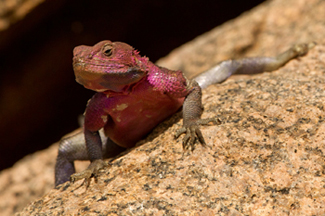 the color change came very slowly, starting with some orange-ish tinges around the snout. Later, when the sun appeared and it began to grow warm, the agamas we were watching began to color up, but it wasn’t until mid-day, as we were driving home that I saw males fully colored, with bright red heads and orange bodies, tapering to coal black waists.
the color change came very slowly, starting with some orange-ish tinges around the snout. Later, when the sun appeared and it began to grow warm, the agamas we were watching began to color up, but it wasn’t until mid-day, as we were driving home that I saw males fully colored, with bright red heads and orange bodies, tapering to coal black waists.
Although I haven’t read anything on this, this color change is similar to what happens with Galapagos Marine Iguanas which are black when they emerge from the cold sea surrounding their islands. Black absorbs the sunlight faster, heating the reptile, and the same obviously holds true for the Agamas. In the evening, I’ve noticed the agamas darken as well, which makes sense in the cooling temperatures, but now, seeing this congregation, it makes even more sense. Males returning to a communal sleeping site fight provoke fights if they were still in their territorial colors but if dark, and aside from size, virtually identical to the females, aggression might be curtailed or avoided.
PM. Gol Kopjes
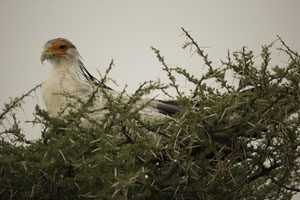 It was a slow afternoon, as Bill and I sat at the Aardwolf den the entire afternoon, without luck. At 6PM one of the babies popped its head up, twice, but disappeared again and nothing more. Everyone else did a normal game drive until 5:30 or so, where they joined me at the den. A few cheetahs, two Honey Badgers playing, and good Spotted Thickknees were the other highlights.
It was a slow afternoon, as Bill and I sat at the Aardwolf den the entire afternoon, without luck. At 6PM one of the babies popped its head up, twice, but disappeared again and nothing more. Everyone else did a normal game drive until 5:30 or so, where they joined me at the den. A few cheetahs, two Honey Badgers playing, and good Spotted Thickknees were the other highlights.
Day 11. To Moru Kopjes, Simba, and Sametu
We broke camp to head to our last location, leaving around 6:15 and delayed, as usual, for 15 minutes while our guides found the sleeping night watchman. At the old cattle egret tree, where we used to photograph egrets clustered by the hundreds in the predawn, we turned left to a borrow pit where two young male lions sat. They were nomads and although not shy, they walked off into the grassland. A few minutes later we spotted another male, a larger golden maned adult, who was following the others, doing flehman. We wondered if it was a resident male defending territory, as the male continued walking, reaching a large, clear water hole. The two young males saw him and advanced, and for a moment we thought a war was imminent. Instead, as the lions got closer they flopped to their sides, rubbing heads, clearly in peaceful overtures. As they approached the male they head butted and acted submissive, then joined him to drink. While  doing so, one of the young males mounted the other and began humping, a sexual or dominance display I’ve never seen, nor had the guides, before. After this mounting the male approached the larger male, who immediately reacted like ‘not me, buddy!’ and semi-charged. Both younger males responded, rising in the air, but the confrontation went no further.
doing so, one of the young males mounted the other and began humping, a sexual or dominance display I’ve never seen, nor had the guides, before. After this mounting the male approached the larger male, who immediately reacted like ‘not me, buddy!’ and semi-charged. Both younger males responded, rising in the air, but the confrontation went no further.
Later, when we reviewed the images on our laptops, we had a clearer view of the event. Indeed, the larger of the two younger lions approached the yellow maned male, and as he turned that male charged, claws fully extended. That male’s teeth were fully bared, but a moment later his paws were back upon the ground. As the smaller male now responded the other resumed his aggression, but interestingly neither extended their claws. The smaller never bared his upper fangs, either, a sign of not serious intent.
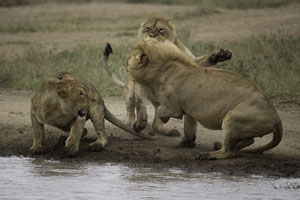
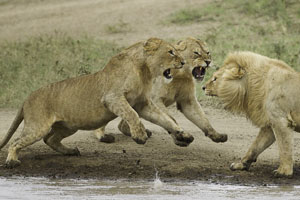
The yellow-maned lion, meanwhile, dipped his head, a submissive pose extended towards the larger of the two younger males. After the spat the two younger lions, probably siblings, groomed one another while the maned lion lay nearby and looked on. A few minutes later, the larger male walked off into the grasses, followed closely behind by the two young males.
I suspect that the two younger males were siblings, with the larger either a cousin from the same pride or, more likely, a lone male they met up with and formed a coalition that, at this stage, is still tenuous and tentative, and hence the partial aggression. I can envision the male making a kill and the two siblings coming in, or vise versa, and after some initial conflict settling down to share the kill. With that contact, they stayed together, and with time will become a strong, cohesive group of three.
We continued on to the Simba kopjes where another 17 lions were lying upon the rocks, too distant for any photos. The lugga, which we now call Reedbuck lugga, was empty, and after reaching the end we headed back to the main road where, a short distance north, we encountered a bad traffic accident.
A vehicle (with a part time employee driver)had a front tire blowout, lost control, rolled over, and crashed into the bank. When we arrived several vehicles were already parked, and the two most seriously injured tourists looked attended to. Nonetheless, with our First Aid training we stopped, to find that the more seriously injured of the two, the man, was almost abandoned, with one Spanish woman shooing away flies. We took over, and Mary added bandages to his head wound, which was still bleeding badly. Eventually a vehicle was cleared and we helped the injured into the vehicle and we were off.
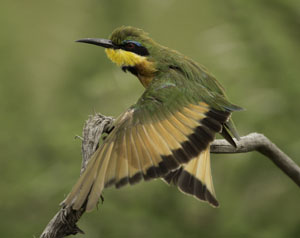
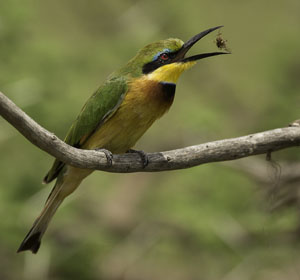
 At Moru Kopjes we had an excellent session with a Little Bee-eater, who landed repeatedly on an open branch, challenging us to capture the bird in flight. I think I succeeded, once, but otherwise had wonderful portraits and grooming. We did a group shot at the Gong Rocks, and continued towards our next camp, and soon spotted a distant Leopard in an acacia. While we watched it climbed down, and we got some nice, though distant, images, before it disappeared in the grasses.
At Moru Kopjes we had an excellent session with a Little Bee-eater, who landed repeatedly on an open branch, challenging us to capture the bird in flight. I think I succeeded, once, but otherwise had wonderful portraits and grooming. We did a group shot at the Gong Rocks, and continued towards our next camp, and soon spotted a distant Leopard in an acacia. While we watched it climbed down, and we got some nice, though distant, images, before it disappeared in the grasses.
Later, along the Seronera Riverine forest, we had three more Leopards, with one that teased us as it changed positions repeatedly. We were in a wonderful position for catching the cat as it left the tree, but it did not, and with an hour ride still to go to reach camp we left the cat. As we drove away I looked back, watching the hanging tail until it disappeared in the distance.
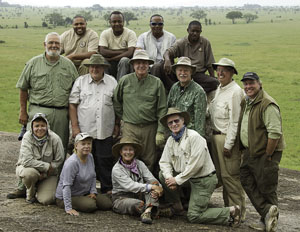
Our group, top row: Arnold, Angelbert, David, Pokea
Middle Row: Dennis, Jim, Bill, John, Tom, Randy
Bottom Row: Deb, Sue, Mary, Joe
Day 12. Sametu
It rained all day and was so dark in the morning that we postponed and then cancelled the morning game drive. We had planned to leave shortly after lunch but an even heavier rain arrived, and everyone gladly agreed that it was better to stay at camp and edit than fight mud-slick roads, rain, and cramped shooting from a window. As it turned out, this decision may have led to one of the best days we’ve ever had with lions.
Day 13. Sametu
During the evening, yesterday, a breeze developed and as we went to dinner we actually had a sunset, a thin sliver of orange framed by dark clouds and distant plains. This morning we awoke again to partial overcast, with the moon appearing fleetingly and hazy between the scudding clouds.
Yesterday, had we gone out, we’d have driven to the Sametu Kopjes where a large lion pride resides. Had we done so, our shooting would have been extremely marginal, at best, and it was likely that today we’d have returned to the crowded central part of the park, Seronera, to look for leopards. Instead, this morning we headed to the Sametu Kopjes, arriving at the first series around 7:30AM, just as the light was finally strengthening. And there we found Lions.
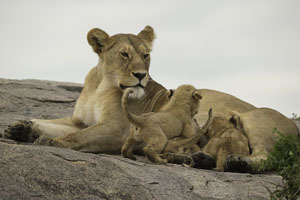 Two Lionesses with five young cubs, the same cubs that one of our guides had photographed nearly three weeks earlier when one of the lionesses carried the cubs between dens. Now around eight weeks old, the likelihood of seeing them carried was slim, but still existed. The lionesses walked down a track, then headed onto a small kopje, just a series of five large boulders and a few bushes, but enough to hide the cubs. Instead, both lionesses climbed to the top of the rocks and the cubs, stymied by the slickness of the rock, worked around, finding an easier route. There they joined the two lionesses who took turns nursing one or all five of the cubs, who periodically left either lioness to either play or nurse from the other.
Two Lionesses with five young cubs, the same cubs that one of our guides had photographed nearly three weeks earlier when one of the lionesses carried the cubs between dens. Now around eight weeks old, the likelihood of seeing them carried was slim, but still existed. The lionesses walked down a track, then headed onto a small kopje, just a series of five large boulders and a few bushes, but enough to hide the cubs. Instead, both lionesses climbed to the top of the rocks and the cubs, stymied by the slickness of the rock, worked around, finding an easier route. There they joined the two lionesses who took turns nursing one or all five of the cubs, who periodically left either lioness to either play or nurse from the other.
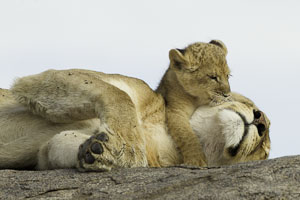
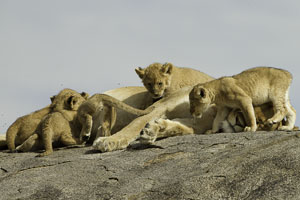
For over 2.5 hours we were the only vehicles there, and for the entire time at least one lioness and cubs were visible, often settling down close to the edge of the boulders. In all our years, we’ve never had just a clear view, nor as long, with no grass or brush obstructing, and a clear sky behind. It was perfect.
A few vehicles started to arrive and the skies cleared, and our last shots were against a blue sky, and with some contrast, until the heat of the sun drove the cubs into the shade. I stayed on, as the lioness was still visible and I hoped the cubs would waken and join the lioness. Mary drove on, stopping at a nearby marsh where she and Randy and Bill photographed African Clawed Frogs at a pool. These are the frogs, completely aquatic, that were used in the 1950’s and earlier to determine human pregnancy. Urine from a woman suspecting pregnancy was injected  and, if she was pregnant, the frog would ovulate. These frogs were used worldwide, and sold in the pet trade as well, and some were released to the wild in foreign countries. Although not proven, these frogs may have introduced a fungus that has spread to other frogs around the world, killing them. This has wiped out entire species and greatly reduced numbers worldwide, an extinction herpetologists liken to the end of the dinosaurs. It is possible there is another cause for this mass die-off, but either way these frogs are compared to canaries in coal mines, in that they may be an indicator of very serious environmental threats.
and, if she was pregnant, the frog would ovulate. These frogs were used worldwide, and sold in the pet trade as well, and some were released to the wild in foreign countries. Although not proven, these frogs may have introduced a fungus that has spread to other frogs around the world, killing them. This has wiped out entire species and greatly reduced numbers worldwide, an extinction herpetologists liken to the end of the dinosaurs. It is possible there is another cause for this mass die-off, but either way these frogs are compared to canaries in coal mines, in that they may be an indicator of very serious environmental threats.
While Mary photographed the frogs she noticed a Lioness further out in the marsh, and she suspected it might be hiding cubs. Don’t ask me why she thought that! But she was correct, and as she watched the lioness picked up 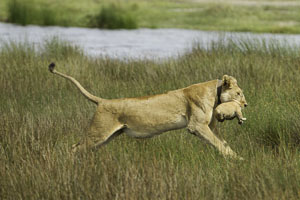 a three week old cub and started walking, and, with cub in its mouth, leaped across a small stream. They caught the jump, and Mary got on the radio and, in English, told everyone to get over here, now!
a three week old cub and started walking, and, with cub in its mouth, leaped across a small stream. They caught the jump, and Mary got on the radio and, in English, told everyone to get over here, now!
When we arrived the lioness was heading towards the second cub. She retrieved it, skirted the stream, and walked straight at us before turning in the grass and depositing the cub. It was a great shoot and we were elated, but it wasn’t over.
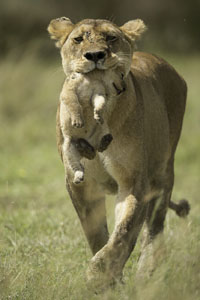
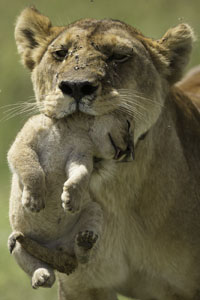
A few minutes later the lioness picked up one of the cubs and started walking again, this time walking directly at our vehicle. She came within head-shot, frame-filling range before turning and skirting our vehicle, and continued on to a distant kopje where she deposited the cub. A few minutes later she retraced her steps, retrieved the second cub, and followed the exact same path. This time, all of our vehicles were in position somewhere along the route, as well as some other vehicles who parked closer to the kopje. After depositing the cub she turned back, as if to get a third, but one of the cubs squealed and she wheeled, jogging back to the kopje to investigate. I always worry about pythons in these situations, as these snakes are a major predator of young cubs. We didn’t see the lioness again, and we wonder why she headed back towards the marsh, as Mary saw her relay only two cubs between a few spots.
We headed back to camp, thrilled, stopping for some scenics of kopjes against one of our first blue skies. As I write this, the skies are once again overcast, as we head out for our last game drive of this safari.
PM. Maasai Kopjes
The skies cleared as we left for a 2:45 game drive. Soon after leaving camp we spotted Lions we’d seen earlier in the day. Six rested beneath a tree while a lone lioness sat like a Sphinx some distance away. She was watching a mother Warthog and two babies, and as the warthogs drew closer she began a stalk. The lioness was hungry, with her stomach deeply tucked, and she slowly, deliberately moved closer. Meanwhile, some of the young males still beneath the tree stood, and the warthog spotted the cats, although we’re not sure if she saw the lioness or the others beneath the tree. Regardless, she started trotting off, but headed in a direction that flanked the tree. Oddly, after passing she turned back, and started walking towards the tree and the Lioness which had resumed a stalk.
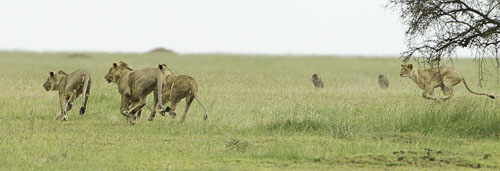
As the warthog drew closer the lioness charged, scattering the warthogs, with the two young warthogs running near the tree, which triggered the entire pride into a chase, with the other lioness running with full intent. Everyone missed, but looking at our images later we saw that the adult 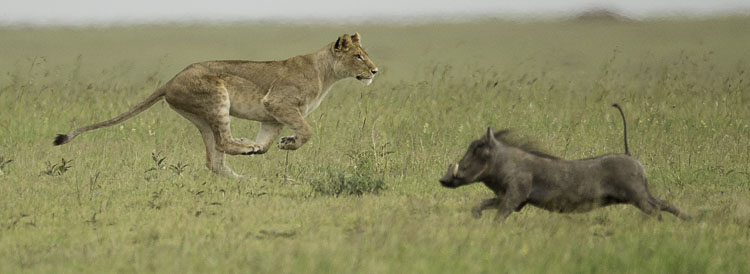
Telephoto compression makes this warthog appear to be running right
in to the
lioness, who was focused on one of her babies.
warthog actually ran towards and passed the charging lion, which must have been focused on one of the young. Regardless, we didn’t see this, and only recorded the event via the images!
We continued on to the Maasai Kopjes, finding several Rock Hyrax that we had missed at the other kopjes. Our search for leopards was fruitless, and by 5:15 we headed towards camp to pack up camera gear for the drive back and to finish with duffels and bags.
As I write this, a few minutes before we’ll gather for drinks at the campfire, African Elephants meander through the grasses a few hundred yards from our tent. Doves coo in the background, and the last Magpie and White-crowned Shrikes flutter about, their last activity before settling in their evening roosts. Although almost every safari, as it occurs, seems to be among the best we’d ever had, I truly believe that this one was, indeed, one of the very best we’ve had in Tanzania. A lion hunt, incredible lion cubs, several cheetah hunts and great cub interaction, six Leopards, and all the rest, even with a day lost to rain, it was action packed and exciting. Both Mary and I wish we could come back in February sooner than in 2016, but our Baja Whales, Costa Rica Wildlife, and our Snow Leopard and Tiger Photo Tours will occupy the first few months of 2015. Luckily, we will be back in October of this year, and both of us can’t wait to return.
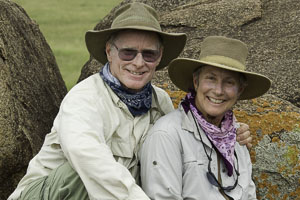 .
.
We will be offering this tour in February, 2016
and although the exact dates are not yet set, all other details are pertinent.
This brochure will present all the information you might need to choose this trip.
Read the Brochure.
If you are interested, contact our office at info@hoothollow.com. We will be doing two trips, in February of 2016. The trip is limited to thirteen participants.
Tanzania Wildlife Photo Safari
February 2014
Trip Report

Our 2014 trip was simply fantastic. A record number of Cheetah sightings -47, 180 Lions, 6 Leopards, Aardwolves and Golden Jackal dens, a Gnu birth, the best-ever Lion cubs, and so much more.



The Serengeti, the land of endless plains. Two weeks ago, as we drove across the Ngorongoro Conservation Area highlands and the famous Ngorongoro Crater and looked upon a landscape that stretched on and on until lost in haze, one might try to understand this vastness. On foot, as the first Maasai herdsmen traveled across the Serengeti across an unchanging sea of grass, this sense of expansion would be tangible, but for the modern traveler, the tourists crossing these grasslands on dirt tracks at Range Rover speeds, this sense of size can still be lost. From the air, however, it is a different story. As we flew back to Arusha from our last camp, flying over kopjes where yesterday we photographed lions and their cubs or days earlier photographed aardwolves and cheetahs, the sheer size and distance of the Serengeti truly struck home, as from this aerial perspective the grasslands simply didn’t seem to end.
Ascending the Ngorongoro highlands once again we passed over scattered Maasai villages, fewer in number in most places than I expected, before crossing the broad plateau of the highlands with unfamiliar crater lakes and the round depressions of unfilled craters far below, and ‘the crater’ itself distantly visible to the south. Clouds from the east hung on the forested eastern slopes, vividly showing the cloud forest effect, and on the western side that tapers down into the Serengeti, the rain shadow of dry, treeless slopes. One doesn’t, or at least I don’t, get the same awareness or perception when we drive across these areas, from one habitat into another, but from the air the transition from relatively flat grasslands to dry slopes to cloud forest seemed abrupt and obvious. And from the air, looking far out into the distance to where land and air comingled in a dusty haze, this wild landscape seemed to stretch forever.






Birds of the Serengeti, Top: Augur Buzzard; Hooded Vulture; Two-banded Plover.
Bottom: Yellow-breasted Longclaw; Gray-breasted Spurfowl; Abdim's Stork.
The following is our day to day Trip Report.
Day 1. Arusha
Six of us arrived the evening prior, and all slept late, some missing the 10AM breakfast cutoff, some, like ourselves, barely slipping in. The day would have been completely uneventful except for the fire – unreported but generating the fire alarm that we were instructed to ignore in the mid-afternoon. After dinner, the fire, which had started in a tent erected somewhere in the lower level of the hotel, started smoldering again, triggering the alarm and, this time, a call to evacuate the hotel. Stupidly, Mary and I joined a Japanese couple in taking the elevator the three floors to the lobby, not the smartest move if the power had gone out. We were smart enough to carry all of our camera gear and computers down with us, in case the fire became serious. It did not, and thirty minutes later we were back in our rooms. By 11PM our last four travelers arrived at the hotel from their overseas flights, with no one missing luggage! By the way, both Mary and I carried our Gura Gear Bataflae bags as carry-on luggage, and of course used the same backpacks throughout the safari. We had no trouble on our flights, and of course the bags were perfect for field use. One of our participants used his Bataflae as carry-on, too, with a 600mm, 200-400mm, a camera body or two, and a 70-200mm all in the same bag once the center insert was removed!
Day 2. Arusha to Ngorongoro Crater
 We left our hotel at 8:45 for the three plus hour drive to the crater. Twenty-six years ago, when we first made this trip, the same route would have taken nearly eight hours as we negotiated bombshell-like craters in the dirt road. Today that same route is paved and smooth, although with construction we had some minor delays with diversions. These, however, were paved or stoned, in contrast to Kenya where it almost seems as if vehicles are left to their own ingenuity to find a new route when a road is closed for repair. It was a refreshing difference.
We left our hotel at 8:45 for the three plus hour drive to the crater. Twenty-six years ago, when we first made this trip, the same route would have taken nearly eight hours as we negotiated bombshell-like craters in the dirt road. Today that same route is paved and smooth, although with construction we had some minor delays with diversions. These, however, were paved or stoned, in contrast to Kenya where it almost seems as if vehicles are left to their own ingenuity to find a new route when a road is closed for repair. It was a refreshing difference.
The landscape was surprisingly green, as the rains have come early and as we approached the Ngorongoro highlands the normally straw yellow fields were lush, with scattered flowers amid a verdant landscape. The highest peaks were shrouded in clouds, and at the overlook the inside of the crater was hazy with the moisture filled air, with the distant crater walls invisible in the murk.
 Normally there are two routes into the crater, with one of these, on the north side, accommodating two-way traffic. On the south side, where we would descend, one winding track goes down, and another climbs back out of the crater. Two years ago, construction was begun on this latter track, with a planned completion of nine months. It is still unfinished, and now everyone inside the crater must vacate via the northern road, which then adds at least one hour of driving along the crater rim to reach the majority of tourist hotels located on the south side. Consequently, by 3PM, when we reached the crater floor it was nearly empty, and less than six vehicles passed us over the next 2.5 hours, as tourists now begin to leave the crater by 3.
Normally there are two routes into the crater, with one of these, on the north side, accommodating two-way traffic. On the south side, where we would descend, one winding track goes down, and another climbs back out of the crater. Two years ago, construction was begun on this latter track, with a planned completion of nine months. It is still unfinished, and now everyone inside the crater must vacate via the northern road, which then adds at least one hour of driving along the crater rim to reach the majority of tourist hotels located on the south side. Consequently, by 3PM, when we reached the crater floor it was nearly empty, and less than six vehicles passed us over the next 2.5 hours, as tourists now begin to leave the crater by 3.
Our tented camp is located on the north side, inside the park gate, so both our entry in the morning and departure in the evening can be as close to start/finish times as possible. As we left the crater this evening, intentionally early so that we could move into our tents while we still had light, we were the only vehicles visible.
 The crater is like Disney World, with all the attractions seemingly under one roof, and tame, completely habituated to vehicles. Whereas in the Serengeti gnus or zebras may shy from vehicles, here they are oblivious, and getting portraits is easy. For this, our break-in drive, our photographers shot Common Zebra, Gnus, Warthogs, Buffalo, Golden Jackal, Spotted Hyenas, and African Lions, and they saw a few dozen species of birds and mammals that we didn’t bother to shoot.
The crater is like Disney World, with all the attractions seemingly under one roof, and tame, completely habituated to vehicles. Whereas in the Serengeti gnus or zebras may shy from vehicles, here they are oblivious, and getting portraits is easy. For this, our break-in drive, our photographers shot Common Zebra, Gnus, Warthogs, Buffalo, Golden Jackal, Spotted Hyenas, and African Lions, and they saw a few dozen species of birds and mammals that we didn’t bother to shoot.
Our camp, Lion’s Paw, is located in the high country Tortillus acacia forest, where trees are bedecked with goat’s beard lichen and various orchids, and where we have often seen Elephants and Buffalo. The camp is beautiful, with running water and flush toilets, carpeted tent floors, and a sturdy, regular bed. While we ate the storms that dodged about the crater rim all afternoon advanced towards us, and at times it was difficult to hear beneath the canvas as rain pummeled the roof and thunder cracked nearby. Regardless, we did the day’s highlights, which ranged from the Golden Jackal and her pups to 11 of the 22 Black Rhinos found in the crater, from Yellow Bishop birds to displaying Kori Bustards, from seeing a first-ever Lion to simply being back to Africa. It was, despite the gloomy weather, a great start.
Day 3. Ngorongoro Crater
It rained through much of the evening and with heavy skies we had no dawn, descending into the crater in blackness. With a heavy canopy of clouds the temperature was in the fifties, but damp, and the air stayed cool throughout most of the day. Nonetheless, it was a very complete day.
Which began, in earnest after some miscellaneous shots, when a full black- maned lion walked across the plains to drink at a roadside pool. It continued, meeting an equally large male, where they head-butted, wrestled, unseen except for the tantalizing tops of their heads when they stood upright, and scent marked along the high reeds. At one point one male stalked the other and charged, and we had a brief moment of play.
maned lion walked across the plains to drink at a roadside pool. It continued, meeting an equally large male, where they head-butted, wrestled, unseen except for the tantalizing tops of their heads when they stood upright, and scent marked along the high reeds. At one point one male stalked the other and charged, and we had a brief moment of play.
 Side Note: On our flight home, while at a stopover in Dar es Salam, I happened to stop by a fellow passenger's seat as he was showing images from his ipad. He was showing some interesting lion images that caught my attention and I paused to watch and ask some questions. As it turned out, we'd met Tony on an Antarctica trip a few years earlier, although we didn't immediately recognize one another. At any rate, he too
Side Note: On our flight home, while at a stopover in Dar es Salam, I happened to stop by a fellow passenger's seat as he was showing images from his ipad. He was showing some interesting lion images that caught my attention and I paused to watch and ask some questions. As it turned out, we'd met Tony on an Antarctica trip a few years earlier, although we didn't immediately recognize one another. At any rate, he too
was in the Crater, for only one full day, and with five other friends in his vehicle. But he struck gold, and I'm relaying what he had to simply illustrate what one can see, and to describe a very interesting series of behaviors.
 At least two of the Ngorongoro lion prides have several full grown males, and Tony found four males feeding upon an African Buffalo carcass. Several other bull buffalo were surrounding the lions as they fed, but the number of lions intimidated the buffalo and they kept their distance. Occasionally they'd move in as if to charge but the lions kept them at bay. Eventually the lions left the kill, which was then claimed by the spotted hyenas and black-backed jackals. Two younger male lions moved in, too, possibly to claim the kill, but the four full-grown, black maned lions reacted to their presence. One of the two young males ran off, but the other did not, and was soon surrounded by the four big males. They charged in, and Tony
At least two of the Ngorongoro lion prides have several full grown males, and Tony found four males feeding upon an African Buffalo carcass. Several other bull buffalo were surrounding the lions as they fed, but the number of lions intimidated the buffalo and they kept their distance. Occasionally they'd move in as if to charge but the lions kept them at bay. Eventually the lions left the kill, which was then claimed by the spotted hyenas and black-backed jackals. Two younger male lions moved in, too, possibly to claim the kill, but the four full-grown, black maned lions reacted to their presence. One of the two young males ran off, but the other did not, and was soon surrounded by the four big males. They charged in, and Tony  captured an entire sequence as they fought. Lions often do not go for a killing throat hold but instead simply try to bite the spine and paralyze their adversary. Doing so, and striking from behind, keeps the aggressor out of harm's way, out of the reach of damaging claws or fangs, while still ultimately accomplishing his goal. Tony caught this bite, as one big male bit the younger, and also another, when in the excitement of the fight one of the coalition males bit another in the rump, which potentially could have crippled him as well. The last shot Tony showed was of the young lion, alive but ruined, paralyzed and left to die. I've seen brief lion fights, and the roars
captured an entire sequence as they fought. Lions often do not go for a killing throat hold but instead simply try to bite the spine and paralyze their adversary. Doing so, and striking from behind, keeps the aggressor out of harm's way, out of the reach of damaging claws or fangs, while still ultimately accomplishing his goal. Tony caught this bite, as one big male bit the younger, and also another, when in the excitement of the fight one of the coalition males bit another in the rump, which potentially could have crippled him as well. The last shot Tony showed was of the young lion, alive but ruined, paralyzed and left to die. I've seen brief lion fights, and the roars  alone are so primeval I can't imagine what that whole experience was like, but it certainly would have been truly unforgettable. While we missed this incredible event, I was happy to see another photographer catch it, and this little anecdote illustrates that anything can happen any time, but you have to be there, on safari!
alone are so primeval I can't imagine what that whole experience was like, but it certainly would have been truly unforgettable. While we missed this incredible event, I was happy to see another photographer catch it, and this little anecdote illustrates that anything can happen any time, but you have to be there, on safari!
This is such an incredibly rare event to see I just had to share
Tony Wong and Wexler Mayer's images of this!







All photos above concerning the Side Note on the incredible sequence in the Ngorongoro Crater were taken by photographer Tony Wong, except for the last in this series photographed by Wexler Mayers. Well done!
You can see all of Tony's images at
https://www.flickr.com/gp/14190814@N08/898B5o/
http://flickr.com/gp/14190814@N08/mq9955/
 We saw several Black Rhinos, and one mating, although we arrived late and my small set of binoculars disappeared within my 800mm’s lens hood, blocking my view until I figured out the source. Afterwards, the male followed the female about, attempting to mate several times but she always rebuffed him. The male quite frequently blasted a fire hose squirt of urine, shooting a spray horizontally that was as long as the rhino itself, and I figured at least a liter of water each time.
We saw several Black Rhinos, and one mating, although we arrived late and my small set of binoculars disappeared within my 800mm’s lens hood, blocking my view until I figured out the source. Afterwards, the male followed the female about, attempting to mate several times but she always rebuffed him. The male quite frequently blasted a fire hose squirt of urine, shooting a spray horizontally that was as long as the rhino itself, and I figured at least a liter of water each time.
Along the riverine stream we encountered a Spotted Hyena that walked towards us on the track, slowly, hang-dogged and tired looking. As it got closer we could see that it was injured, with blood splatters on its legs and side, and prominent bite marks around its hips, sure sign of a lion bite. We assumed that the injured animal was limping back to its den where it would recuperate, so imagine our surprise less than an hour later when we found the hyena flat on the road, dead. When we passed the hyena in late afternoon it was still untouched, and not even a vulture had attempted to scavenge.
At the picnic area the pesky Black Kites stole chicken legs from two of our people, swooping in so quickly that the food was literally snatched from their  hands before they could react. Hippos were surprisingly close to the tourist-side of the picnic area, and the hippos surfaced close, although 90% of the time they were completely invisible, resting beneath the water. A Fan-tailed Widowbird and an African Darter made the rest of that visit more noteworthy.
hands before they could react. Hippos were surprisingly close to the tourist-side of the picnic area, and the hippos surfaced close, although 90% of the time they were completely invisible, resting beneath the water. A Fan-tailed Widowbird and an African Darter made the rest of that visit more noteworthy.
Several Common Zebras had skirmishes, with one fight lasting twenty minutes or more as immature zebras tested one another or followed a defeated foe about, harassing it to fight again. Good Warthog, Thompson’s Gazelles, and Kori Bustards rounded out some portfolios
 In the late afternoon we found another Golden Jackal den with two half-grown pups that played continually. The female had walked right beside us as we drove off, and we hoped that she’d return with food before the black western skies forced us to flee. The rains won, although we did part of our late afternoon driving through the rain. Still, we managed to see three Serval, and photograph good Spur-winged Geese and Black-bellied Bustards.
In the late afternoon we found another Golden Jackal den with two half-grown pups that played continually. The female had walked right beside us as we drove off, and we hoped that she’d return with food before the black western skies forced us to flee. The rains won, although we did part of our late afternoon driving through the rain. Still, we managed to see three Serval, and photograph good Spur-winged Geese and Black-bellied Bustards.
Day 4. Ngorongoro Crater
We planned for a 5:45AM breakfast, anticipating cloudy, dreary skies. Instead, the skies were clear and the stars shone brightly in an atmosphere devoid of extraneous ambient light. By the time we entered the crater the sun was just peeping over the horizon, muted somewhat with heavy humid still in the air.
 We headed towards the lion luggas, and almost immediately our guide spotted a black-maned Lion in the distance with two lionesses. As we watched they mated, but the distance was too far for any shots or the likelihood of the pair coming any closer. We moved on. Table Mountain, the remnants of the peak which one towered higher than Kilimanjaro, is the highest point within the crater and we ascended, reaching the top for a wonderful view of the misty valley floor, sparkling everywhere from permanent and ephemeral ponds. A pair of Spotted Hyenas were running in the distance, and one carried a kill which we thought was a newborn gnu. We did a U-turn and headed back downhill, following the path of the hyenas in hopes of intersecting them for some shots. We succeeded, and discovered that the kill was the front end of a baby Zebra, now just a bloody thorax, neck, and legs.
We headed towards the lion luggas, and almost immediately our guide spotted a black-maned Lion in the distance with two lionesses. As we watched they mated, but the distance was too far for any shots or the likelihood of the pair coming any closer. We moved on. Table Mountain, the remnants of the peak which one towered higher than Kilimanjaro, is the highest point within the crater and we ascended, reaching the top for a wonderful view of the misty valley floor, sparkling everywhere from permanent and ephemeral ponds. A pair of Spotted Hyenas were running in the distance, and one carried a kill which we thought was a newborn gnu. We did a U-turn and headed back downhill, following the path of the hyenas in hopes of intersecting them for some shots. We succeeded, and discovered that the kill was the front end of a baby Zebra, now just a bloody thorax, neck, and legs.


Cresting the mountain again we photographed the zebras and Gnus against the backdrop of the crater floor, before heading downhill where we spotted four big-maned Lions in the distance. They were bloated like sausages from a kill and we thought they’d head to the only pond, behind us, but after walking over a half mile the lead lion turned around and joined his lazy mates lying on a low hill hundreds of yards away. In the leopard lugga we found a Lioness with two cubs only six weeks old, quite unexpected, although the shooting window was limited because of the high weeds.
We continued to the Golden Jackal den, where the young played but slightly further than before, until two uncaring tourists stood so high in their vehicle that their human silhouette frightened the jackals into retreating much further from the den. While we watched, however, one of our guides spotted  an African Buffalo in the beginning stage of birthing, with a reddish balloon protruding from her backside. It took 44 minutes until the baby finally dropped, and while the birthing occurred the calf looked listless or dead. We’ll never know, as the cow dropped the calf in vegetation that hid it from our view, and for nearly 40 minutes we could see her licking the baby, but never saw any evidence of movement. In the last twenty minutes the cow wandered about, as far as twenty feet away, and we suspected that the calf might indeed be dead. None of our guides had ever seen a buffalo give birth, so estimates ranged from ten minutes to two hours before a calf would stand, but we saw no movement at all.
an African Buffalo in the beginning stage of birthing, with a reddish balloon protruding from her backside. It took 44 minutes until the baby finally dropped, and while the birthing occurred the calf looked listless or dead. We’ll never know, as the cow dropped the calf in vegetation that hid it from our view, and for nearly 40 minutes we could see her licking the baby, but never saw any evidence of movement. In the last twenty minutes the cow wandered about, as far as twenty feet away, and we suspected that the calf might indeed be dead. None of our guides had ever seen a buffalo give birth, so estimates ranged from ten minutes to two hours before a calf would stand, but we saw no movement at all.
We drove on, now close to noon, and found a Tawny Eagle feeding upon the remains of an Abdim’s Stork which, we were later told, a Caracal had killed and then deserted. Continuing towards our lunch spot we filmed several gnu babies and a less than two day old zebra foal. Lunch didn’t occur to after 1:30, and afterwards we headed back into the plains where we had a fairly close Black Rhino, the same female that had been mating yesterday.
 Later we discovered another Golden Jackal den, with three pups close to the road tussling over an Abdim’s Stork feather. The pups were close enough to be frame-filling. Another Rhino passed by in the distance and our guide wanted to follow it, and in doing so we encountered one of the adult Golden Jackals returning with the back end of another stork. We immediately turned around and raced back to the den, but the adult took a different route and delivered the carcass far from the road. There the pups wrestled until one took possession of the bird and ran away.
Later we discovered another Golden Jackal den, with three pups close to the road tussling over an Abdim’s Stork feather. The pups were close enough to be frame-filling. Another Rhino passed by in the distance and our guide wanted to follow it, and in doing so we encountered one of the adult Golden Jackals returning with the back end of another stork. We immediately turned around and raced back to the den, but the adult took a different route and delivered the carcass far from the road. There the pups wrestled until one took possession of the bird and ran away.
We headed back to the Table Mountain area, where we spotted a distant Serval, and great Secretary Birds by the leopard lugga. With only forty minutes left to the day we found a female Grant’s Gazelle with unusual down-pointed horns that formed a heart-shaped crescent around her face, with the tips of her horns actually piercing into her muzzle. As we left the crater we had our most cooperative Black-backed Jackal, and a pair of Warthogs that were so close to be frame-filling head shots. In all, on one camera I shot 58gb!


While mice and rats form the foundation of the food chain they are rarely see, while larger herbivores, like warthogs, are very conspicuous.
Day 5. Ngorongoro Crater to Ndutu Camp, NCA
We left our camp at 6:40 for the four-five hour drive to our next camp, although that planned wasn’t really followed. Originally, we’d contemplated dropping into the Crater for the first two hours and then heading west, but we amended that, and thought we might do the Crater if we had clear skies. We changed that, again, to simply leave early, and fortunately we stuck with that plan as the skies were dreary and overcast and the light in the crater would have been poor.
 We headed west into the Ngorongoro Conservation Area (NCA) and soon were into one of the largest congregations of gnus we’d ever seen. Animals extended half a mile deep and from horizon to horizon, and just basing our estimate on what a football stadium of 100,000 people might look like, we figure we’d seen over 1 million animals. Birthing seemed to be at its peak, and bloody sacks of placentas dotted the plains, the afterbirths of the multiple births. We spotted several that were about to give birth, with either balloon-like sacks of amniotic fluid or tiny legs protruding from the female’s butts. Although birthing was imminent, the entire process still took hours, and surprisingly the females appeared to be suffering a great deal of discomfort, getting up and changing positions, squeezing and pushing, standing, lying down, all signs of a lot of stress.
We headed west into the Ngorongoro Conservation Area (NCA) and soon were into one of the largest congregations of gnus we’d ever seen. Animals extended half a mile deep and from horizon to horizon, and just basing our estimate on what a football stadium of 100,000 people might look like, we figure we’d seen over 1 million animals. Birthing seemed to be at its peak, and bloody sacks of placentas dotted the plains, the afterbirths of the multiple births. We spotted several that were about to give birth, with either balloon-like sacks of amniotic fluid or tiny legs protruding from the female’s butts. Although birthing was imminent, the entire process still took hours, and surprisingly the females appeared to be suffering a great deal of discomfort, getting up and changing positions, squeezing and pushing, standing, lying down, all signs of a lot of stress.
 One female stayed along the edge of the herd and presented a good show, standing up when the baby was half out and only lying back down as the baby slipped free. While we didn’t record the time for the delivery, 9 minutes went by until the baby finally stood. At 6 minutes the baby tried to stand, at six and a half the baby half stood and ran forward, only to fall on its head. And, after its rest, standing at nine. The female laid down next, with the baby circling and coming face-to-face, but when the female rose she butted the baby, and as it tried to nurse was pushed away. Frequently finding the teats is a challenge, but this baby was headed in the right direction but prevented from doing so, and I thought that at any moment the baby might be hooked, horned, and tossed. After 15 minutes the baby was allowed to nurse and all went as normal after that.
One female stayed along the edge of the herd and presented a good show, standing up when the baby was half out and only lying back down as the baby slipped free. While we didn’t record the time for the delivery, 9 minutes went by until the baby finally stood. At 6 minutes the baby tried to stand, at six and a half the baby half stood and ran forward, only to fall on its head. And, after its rest, standing at nine. The female laid down next, with the baby circling and coming face-to-face, but when the female rose she butted the baby, and as it tried to nurse was pushed away. Frequently finding the teats is a challenge, but this baby was headed in the right direction but prevented from doing so, and I thought that at any moment the baby might be hooked, horned, and tossed. After 15 minutes the baby was allowed to nurse and all went as normal after that.
We just missed two births, with the first occurring too far away to shoot. We drove closer, and although we didn’t time it we suspected that only three or four minutes, at most, had passed.. When we saw the baby it was still just weaving its head about but it stood, breaking the whitish birth sack, and immediately followed the mother. This occurred almost immediately, and we figure no more than four minutes, total, from birth to walking away with the mother had elapsed.
Another gun in the distance was struggling to deliver but we left her to have our picnic lunch where, on the open plain, we found several Dung Beetles rolling dung balls. A few years ago I had dug up a few beetles after they disappeared beneath the soil, finding that the adult was lying in a death-like state. After a few minutes the adult revived, and when placed on the ground the beetle headed directly back towards the site where it had been buried.
 Two different types of dung beetle seemed to be active today, with one rolling dung and the other simply burying the dung under some soil. I scraped several of the latter free, and found only one small scrap of dung, although one of our guides did so and we found one beetle. This too seemed dead, but after a few minutes revived, and when placed on the ground made a few circles before heading in the direction of its dung ball.
Two different types of dung beetle seemed to be active today, with one rolling dung and the other simply burying the dung under some soil. I scraped several of the latter free, and found only one small scrap of dung, although one of our guides did so and we found one beetle. This too seemed dead, but after a few minutes revived, and when placed on the ground made a few circles before heading in the direction of its dung ball.
We watched a ‘traditional’ dung beetle pair inter their dung ball, and while we waited the adults disappeared and did not reappear. Another dung ball was being rolled by a single adult, followed closely behind by another which may have been its mate or a rival male intent on stealing the ball. Whatever, at one point the second caught up, but the first rolled the ball away and in doing so lost its pursuer. Later, that beetle took to the air and soon located the dung ball, landed, and took possession.
I still don’t know whether the adults, disappearing with the dung ball, die beneath the soil like salmon that spawned up river and then expired, or simply go into an aestivation state. We wondered how the beetles suddenly appeared when fresh dung was present, since we rarely saw beetles flying about. Could they be beneath the soil, with their last buried ball of dung, and sense (or smell) fresh dung and reemerge? I haven’t read anything on this and, at least for now, the mystery continues.
We continued on to the Ndutu forest where we photographed Lionesses,  European Rollers, Tawny Eagles, Lovebirds, Masai Giraffe, Elephant, and the streams of migration Gnus racing through the forest. Around 5 we learned of a mother Cheetah with tiny young still sporting their silver mane and resembling a Honey Badger (which we saw on the Crater rim this morning) and thus perhaps protected since these badgers are notoriously bad-tempered. By the time I arrived the cheetahs were slinking into the high grass of a marsh, as 8 lions were visible about a quarter mile away. They never reappeared, but as we drove to our next camp we passed another female Cheetah and two young adults, still sporting their juvenile mane.
European Rollers, Tawny Eagles, Lovebirds, Masai Giraffe, Elephant, and the streams of migration Gnus racing through the forest. Around 5 we learned of a mother Cheetah with tiny young still sporting their silver mane and resembling a Honey Badger (which we saw on the Crater rim this morning) and thus perhaps protected since these badgers are notoriously bad-tempered. By the time I arrived the cheetahs were slinking into the high grass of a marsh, as 8 lions were visible about a quarter mile away. They never reappeared, but as we drove to our next camp we passed another female Cheetah and two young adults, still sporting their juvenile mane.
Our next camp is beautiful, and our tent is nearly 100 yards from the dining area, with each tent spaced about 20 yards apart. Caracals and Servals have been spotted just in front of the tents, and as we walked to diner this evening Lions roared nearby.

Day 6. Ndutu
 We awoke to a thick fog, with trees and the tents before us hidden in the thick mist. Occasionally the fog parted sufficiently that a star briefly glowed, but those moments were few. The first two hours of the game drive were interesting, and we spent time lining up the spectral shapes of Tortillus Acacia trees as stacked silhouettes, with the more distant ones progressively disappearing in the fog.
We awoke to a thick fog, with trees and the tents before us hidden in the thick mist. Occasionally the fog parted sufficiently that a star briefly glowed, but those moments were few. The first two hours of the game drive were interesting, and we spent time lining up the spectral shapes of Tortillus Acacia trees as stacked silhouettes, with the more distant ones progressively disappearing in the fog.
 Four Cheetahs were spotted almost immediately, two pairs of subadults that we wondered might be part of the same litter, and might even still be together at times. Both were hunting, with one pair intently so, stalking towards two different sets of gnus. Interestingly, both pairs frequently explored and climbed trees, only to eight feet or so, but unique nonetheless.
Four Cheetahs were spotted almost immediately, two pairs of subadults that we wondered might be part of the same litter, and might even still be together at times. Both were hunting, with one pair intently so, stalking towards two different sets of gnus. Interestingly, both pairs frequently explored and climbed trees, only to eight feet or so, but unique nonetheless.

The cats spotted a distant herd of gnus and zebras adjacent to the swamp and started stalking. We drove ahead, hoping that the cats would precipitate a stampede into the open bottomland. They did not, and instead the herd  charged off, away from us, and we raced ahead, eventually finding both cheetahs on a baby gnu. While we photographed the two grabbed the baby, one at the throat, the other at the hind quarters, and carrying the gnu aloft carried it into the shelter of the brush. We left it soon after, not interested in the feeding and hoping to avoid the congestion of vehicles that soon gathered, at least 17 at one point.
charged off, away from us, and we raced ahead, eventually finding both cheetahs on a baby gnu. While we photographed the two grabbed the baby, one at the throat, the other at the hind quarters, and carrying the gnu aloft carried it into the shelter of the brush. We left it soon after, not interested in the feeding and hoping to avoid the congestion of vehicles that soon gathered, at least 17 at one point.


The cheetah with small cubs was in the same spot as we’d seen them last evening, but a vehicle had attempted to get close and was deeply mired in the mud. Another vehicle tried freeing it and got stuck, and then two other vehicles drove in, with one freeing the first vehicle, which then tried pulling the second out by gunning forward with the chain attached. Naturally the chain broke, and luckily the windshield of the stuck vehicle was not struck, or anyone inside. About an hour later the second vehicle was freed, by another vehicle coming to its rescue. A short time later, the driver of one of the two stuck vehicles mired himself once again, and the process had to be repeated. We drove on.
 The rest of the morning was fairly uneventful as we searched for another lion pride and cheetah family, although Sue and Tom’s vehicle had a great serval, and Sue caught it in mid leap as it jumped over the tall grasses. Mary found a fresh zebra birth, with a dead baby, and a mother that nudged and guarded it, walking off at times but then returning. Eventually the mother wandered off, stopping about sixty yards away to gaze back at her foal. Nubian Vultures perched nearby, soon to have a meal.
The rest of the morning was fairly uneventful as we searched for another lion pride and cheetah family, although Sue and Tom’s vehicle had a great serval, and Sue caught it in mid leap as it jumped over the tall grasses. Mary found a fresh zebra birth, with a dead baby, and a mother that nudged and guarded it, walking off at times but then returning. Eventually the mother wandered off, stopping about sixty yards away to gaze back at her foal. Nubian Vultures perched nearby, soon to have a meal.
PM. We originally planned on a 3:30 departure but at lunch it clouded over and I moved our time to 3, and soon after it cleared once again. Instead, we dallied with tea and drinks for twenty minutes, fun socializing actually, before departing. Cheetahs had been spotted by Ndutu lake and we headed there, soon finding a single cheetah sitting on top of a low mound. Mary was with another pair, a mother with a nearly full-grown young, and the shooting was good so we changed cats, arriving just as the pair settled down to mutually groom one another.
 En route, Jim and I photographed Maribou Storks close to the road. These were courting and beginning nest building activities, picking up sticks and transferring them to their mates, and mutually preening each other. We were so close that portraits of that activity was possible, and rewarding.
En route, Jim and I photographed Maribou Storks close to the road. These were courting and beginning nest building activities, picking up sticks and transferring them to their mates, and mutually preening each other. We were so close that portraits of that activity was possible, and rewarding.
After the cheetahs we headed towards the forest but a pride of six Lioness, two lionesses and four cubs, stopped us for an hour as they nursed and tempted us with half-hearted play. Mary left early to look for leopards, unsuccessfully, but eventually we all abandoned the lions when, after nursing, the cubs and the adults fell fast asleep.


In our last hour we photographed two large nursery herds of Gnus, where almost every adult had a calf in tow, an excellent Black-chested Snake Eagle, and a den of surprisingly shy (for this area) Bat-eared Fox. Surprisingly, there were young pups at the den but they were shy and darted into the den, while one adult stayed out and another, an older juvenile, appeared briefly. Mary recalled seeing this before but I did not, seeing three different age groups, obviously an adult pair that were the parents of the young pups, and the teen-age foxes that were also at the den.
Day 7. Ndutu


Today was a definitive Cheetah day, one of the best. We intended to visit Hidden Valley, a magical depression that appears, unannounced, in the middle of the lower Serengeti plains. After skirting Lake Ndutu, where we photographed Maribou Storks against a red sunrise, we moved onto the plains. En route, my vehicle had a surprisingly cooperative pair of Bat-eared Foxes, surprising because out in the middle of the plains the likelihood that they’d been visited often enough to be habituated is very slim. Another, larger family group later on were more typical, darting off as soon as we stopped the ‘rover. Spotted Hyenas slunk across the grasslands on their way home from a night’s foraging, and we photographed one pair that were finishing off the skull of a Gnu, carrying it off as we approached.
Bill’s vehicle had a Cheetah that chased after a Zebra foal, but the distance was too great and the protective mother discouraged a serious hunt. We encountered the same Cheetah a short time later, after spending some time following another female that we thought might be returning to small cubs. When we reached the cheetah she was obviously intent on finding game, sitting upright and scanning the horizon. The other vehicles had continued on to Hidden Valley, which proved to be a disappointment with no large herds around the water.
 Our Cheetah stood, and started walking towards a distant herd of Grant’s Gazelles but had only traveled a short distance when she kicked up an African Hare. She pursued it immediately, as the hare zig-zagged about, keeping ahead of the cheetah as, whenever she drew near, she’d try to trip the hare with an outstretched paw. Doing so, she lost speed, and the hare raced ahead. Using our camera’s metadata we could time the entire chase, which lasted 33 seconds, a very long time for a cheetah run and one that ended unsuccessfully as the cheetah simply ran out of steam.
Our Cheetah stood, and started walking towards a distant herd of Grant’s Gazelles but had only traveled a short distance when she kicked up an African Hare. She pursued it immediately, as the hare zig-zagged about, keeping ahead of the cheetah as, whenever she drew near, she’d try to trip the hare with an outstretched paw. Doing so, she lost speed, and the hare raced ahead. Using our camera’s metadata we could time the entire chase, which lasted 33 seconds, a very long time for a cheetah run and one that ended unsuccessfully as the cheetah simply ran out of steam.
Although the cheetah was exhausted we stayed with her and our other three vehicles joined us, leaving Hidden Valley for a possible hunt. Nearly an hour passed before the cheetah resumed hunting, moving in spurts towards a distant herd of Grant’s Gazelles. When she decided to hunt, she scuttled closer, running a very short distance before setting back down, wiggling to get her hind legs tucked beneath her for a charge. She began this stalk at 10:39:03, moving forward and sometimes looking about, presumably to look for pesky hyenas but making us wonder if she was truly serious. At 11:21:15 she began a serious stalk, aimed at a pair of young Grant’s Gazelles that were now standing and visible. She moved closer in quick little bursts, then started her charge two minutes later, at 11:23:26. Three times it looked as if she had tripped up the young gazelle, but for the first two of gazelle regained its feet and continued running. On the third trip, or slip as is often the case, the cheetah caught the kid, at 11:23:52, twenty-six seconds later.
 10:39:03 started the hunt
10:39:03 started the hunt
11:21:15 serious stalk
11:23:26 started the charge
11:23:52 knock down
We stayed with the cheetah while she regained her breath, and at fifty feet we could clearly hear her panting. We shot some nice images as she grabbed the kid by the throat and carried it to some thicker vegetation, where we left her to feed as we continued driving back to camp.
PM. We hoped to find leopards or the cheetah family with small cubs, and drove through the Ndutu forest and into the plains. We found two of the Cheetah males from yesterday morning, and they were thin and hungry, and obviously hunting but no game was nearby. We had a radio call that a Cheetah with cubs was spotted and we left, passing another Cheetah lying in the grass with a few vehicles in attendance. Ten minutes later we arrived, to find a mother Cheetah with two very young cubs, still with the full white mane that makes the babies resemble the formidable Honey Badger. Mary was in a perfect position with a great window to where the mother lay, but all of our vehicles had good shooting as the two cubs changed positions constantly, exploring or wrestling or climbing on top of the mother. She cooperated too, coming out into clear view to lie down for a few minutes before us, with the cubs clambering about.




The cheetah eventually moved out into the open savannah, where vehicles kept a respectful distance after one tourist vehicle tailed behind, too closely, and spooked one of the babies into a long, dangerous run ahead. Luckily she returned, and from that point on everyone kept their distance. Three of our vehicles had had great shooting earlier and moved on, while Tom and I remained, hoping for more action but the cheetah mother slept and nursed, while the babies suckled or slept.
The other vehicles returned to the forest where Sue, Randy, and Jim had a mother Lioness and cub climb a tree in the last light of the day, and the others saw that the two male Cheetahs had made a kill in the interim, capturing a Gnu calf. In all, we had 6 Cheetahs this evening, and 4 this morning, for a total of 13 Cheetahs in this area in two days.
Day 8. Ndutu
We left camp at 6:30 for an all-day game drive, after packing for our transfer to our next camp at Naabi Hills. The sky was overcast and dreary as we headed through the forest looking for leopards, and passing the two Cheetah brothers we’d seen yesterday. Today, they were lying on a bank, relaxed and, for our now satiated tastes, not too tempting. A trio of the endemic Gray-breasted Spurfowl stopped us for a short time, providing nice portraits of this chicken-like bird that seems a cross between a red-necked and the yellow-necked spurfowl.
 We received a radio call that Lions were at a kill and all of us congregated there, and for the new people it was exciting but my vehicle, with veterans, passed on the scene and the mob of vehicles around it. Shortly after, our guide spotted a Cheetah in the distance, which proved to be the same mother with small cubs we had last night. The cheetah was hunting, and we had several opportunities to photograph the three as they walked through the grasses or towards us on the dirt track. At one point, our guide, taking a huge risk, did a wide detour to be at a spot where, if the cheetahs crossed a lugga, we’d be in position.
We received a radio call that Lions were at a kill and all of us congregated there, and for the new people it was exciting but my vehicle, with veterans, passed on the scene and the mob of vehicles around it. Shortly after, our guide spotted a Cheetah in the distance, which proved to be the same mother with small cubs we had last night. The cheetah was hunting, and we had several opportunities to photograph the three as they walked through the grasses or towards us on the dirt track. At one point, our guide, taking a huge risk, did a wide detour to be at a spot where, if the cheetahs crossed a lugga, we’d be in position.  The cheetah did just that, and then laid down in the open with a cub joining her to mutually groom. We were, truly, in a perfect spot, when one of the Film Crew vehicles we’d seen the last few days, and who have been particularly obnoxious with speeding through the grasslands and forests, crossed the lugga close to the cheetahs. To do so required a lot of engine gunning and banging, and our cheetah was disturbed, got up, and continued on its way. This behavior, on the part of the driver and the film guy, was so blatantly callous, unconcerned either for anyone else watching or, most importantly, how his rash behavior might affect the cheetahs, that one has to question the validity or value of some of these films. That’s a sad thought on my part.
The cheetah did just that, and then laid down in the open with a cub joining her to mutually groom. We were, truly, in a perfect spot, when one of the Film Crew vehicles we’d seen the last few days, and who have been particularly obnoxious with speeding through the grasslands and forests, crossed the lugga close to the cheetahs. To do so required a lot of engine gunning and banging, and our cheetah was disturbed, got up, and continued on its way. This behavior, on the part of the driver and the film guy, was so blatantly callous, unconcerned either for anyone else watching or, most importantly, how his rash behavior might affect the cheetahs, that one has to question the validity or value of some of these films. That’s a sad thought on my part.


We continued to follow the cheetahs, and positioned ourselves opposite a long line of Gnus where, at its end, several babies ran with their mothers. As one group ran by our mother cheetah charged, and the two ran directly towards our vehicle, in the complete open in low grass or bare ground. I had guessed that when she charged the mother gnu, instead of guarding the baby, would be overcome by the herd instinct and panic, and would run, leaving the baby to its fate. I was wrong, and instead the mother charged after the cheetah, breaking up the chase and our chance at some truly spectacular shots. A few seconds later the cheetah charged another mother/calf pair, but was unsuccessful as well. Meanwhile, the tourists vehicles around had displayed such disregard for the hunt, or giving space to the cheetahs, that we were disgusted and chose to head off to the Matiti area where we’d be alone. We drove off.
We were headed in the direction where African Wild Dogs had been spotted but we had no luck, although we encountered huge herds of gnus, and one orphan that ran up to me and circled several times when I got out of the  vehicle. A bull Elephant strode directly to us, giving great portraits, and another mother-daughter pair of Cheetahs provided us with some nice shooting in the latter part of the afternoon.
vehicle. A bull Elephant strode directly to us, giving great portraits, and another mother-daughter pair of Cheetahs provided us with some nice shooting in the latter part of the afternoon.
It rained, and we closed our roof hatches for a short time, while our vehicles skidded through the slick black cotton soil. Mary’s vehicle actually did a 180 degree spin, and another time almost slid into a small tree but the surrounding brush buffered the collision and they slid past. We continued toward our next destination at Naabi Hill, stopping at Lake Ndutu where several herds of Gnus were passing, with one large group appearing to be ready to cross this shallow alkaline lake. While we waited several adults entered the water and began a slow wade across the shallows, while my vehicle did a fast race around the back end of the lake to join our other vehicles on the other side, waiting for the gnus. They crossed, in a long, snaking line, with most simply walking while the younger gnus swam through the center portion of the lake. About four-fifths of the herd had crossed when a bird spooked the remainder, with the leaders suddenly turning and crashing through the water, driving the remaining gnus back the way they had come. The herd skirted the lake shore at that point and we drove on.




An enormous Gnu herd spread across the Ndutu plains, rivaling the numbers we’d seen a few days earlier when we first entered the NCA. After a few miles the herd ended, but a new herd of several hundred Grant’s and Thompson’s Gazelles took their place, and a short while later another enormous Gnu herd appeared, stretching to the distant Gol Kopjes and beyond. We reached camp by 5:30, tired but extremely satisfied with a very rewarding day.
Day 9. Gol Kopjes
 Life can be very short in the Serengeti, measured in minutes. We were watching a male Cheetah lying on top a high kopje, nearly silhouetted against the sky and not any type of pleasing image. We were about to leave and head for home when it sat up and looked beyond us. Mary glassed the plains and a little over a quarter mile away a Grant’s Gazelle had just given birth and was licking the baby. In the grasses the baby, which stands no higher than 18 inches, was barely visible through binoculars, but the cheetah saw and recognized the baby and strode leisurely off the rock wall. We headed ahead, as a game track led parallel to the gazelle. From there we watched the cheetah walking confidently the first third, then moving in spurts, often hunkered low and stalking, rushing a few feet before pausing, sometimes almost in the beginning of a step. The cheetah covered the second third in this way before beginning a run, as the gazelle, until then unaware, led its baby into the grasslands. When the charge came the gazelle bolted and the baby, instinctively, dropped to the ground, but the cheetah was there and captured it without a run or struggle. A few minutes later the cheetah carried the baby further into the grasses, where we lost track.
Life can be very short in the Serengeti, measured in minutes. We were watching a male Cheetah lying on top a high kopje, nearly silhouetted against the sky and not any type of pleasing image. We were about to leave and head for home when it sat up and looked beyond us. Mary glassed the plains and a little over a quarter mile away a Grant’s Gazelle had just given birth and was licking the baby. In the grasses the baby, which stands no higher than 18 inches, was barely visible through binoculars, but the cheetah saw and recognized the baby and strode leisurely off the rock wall. We headed ahead, as a game track led parallel to the gazelle. From there we watched the cheetah walking confidently the first third, then moving in spurts, often hunkered low and stalking, rushing a few feet before pausing, sometimes almost in the beginning of a step. The cheetah covered the second third in this way before beginning a run, as the gazelle, until then unaware, led its baby into the grasslands. When the charge came the gazelle bolted and the baby, instinctively, dropped to the ground, but the cheetah was there and captured it without a run or struggle. A few minutes later the cheetah carried the baby further into the grasses, where we lost track.
 We started our morning with a 5:30AM breakfast and 6AM departure, in near darkness, reaching the first kopje after sunrise, had we had one. The skies were gloomy and the light low, although some photographed the Barn Owl that usually resides in a long vertical crevice in one of the larger rocks. Earlier, we found a Cheetah mother and large cub, and sadly the cub had either a sprained or broken front leg, at the wrist, and limped along. Yesterday, I’d seen a three legged Spotted Hyena, missing its left hind leg, but the hyena was running along at what seemed like a normal speed. For a cheetah, however, a permanent injury is a death sentence, and we could only hope that this was a sprain and the cat would recover.
We started our morning with a 5:30AM breakfast and 6AM departure, in near darkness, reaching the first kopje after sunrise, had we had one. The skies were gloomy and the light low, although some photographed the Barn Owl that usually resides in a long vertical crevice in one of the larger rocks. Earlier, we found a Cheetah mother and large cub, and sadly the cub had either a sprained or broken front leg, at the wrist, and limped along. Yesterday, I’d seen a three legged Spotted Hyena, missing its left hind leg, but the hyena was running along at what seemed like a normal speed. For a cheetah, however, a permanent injury is a death sentence, and we could only hope that this was a sprain and the cat would recover.
 At another kopje we found three Lion cubs, a lioness, and a golden maned large male. The shooting was marginal until the male approached an acacia tree and, to our complete surprise, climbed up into the lower branches, about 12 feet or so. We have never seen a male in a tree, and it was a bit comical to watch as the lion reversed directions and tried getting back down. It did so with little grace.
At another kopje we found three Lion cubs, a lioness, and a golden maned large male. The shooting was marginal until the male approached an acacia tree and, to our complete surprise, climbed up into the lower branches, about 12 feet or so. We have never seen a male in a tree, and it was a bit comical to watch as the lion reversed directions and tried getting back down. It did so with little grace.
Later we found two black-maned Lions, one sitting upright the other sleeping, atop a low kopje that overlooked the grasslands and a distant Naabi Hill. It was an iconic shot, made humorous, however, when the sleeping lion urinated without stirring, with the puddle flowing downhill and beneath the cat’s outstretched tail.
One of our vehicles spotted a Honey Badger or Ratel, but it was running and continued doing so until it reached a burrow, where it disappeared. We waited a few minutes but it was fruitless and we drove off. In another kopje  a Spotted Eagle Owl was spotted and photographed by everyone. The owl is a dead ringer of our Great Horned Owl, and I’d bet showing an image to a US birder they’d identify it as such without hesitation. The owl perched in the grasses in front of a small crevice which was probably its normal roost.
a Spotted Eagle Owl was spotted and photographed by everyone. The owl is a dead ringer of our Great Horned Owl, and I’d bet showing an image to a US birder they’d identify it as such without hesitation. The owl perched in the grasses in front of a small crevice which was probably its normal roost.
Denny and Deb had a Lioness chase a Bat-eared Fox which also escaped into a hole, and as we drove back to camp I photographed a Martial Eagle perched in an acacia. On the way home we stopped again at the Barn Owl rock, where now two stood in the crack low and closer to the opening, providing the best opportunity I’ve had with these birds. Barn owls looks very similar to a rarer species, the Marsh Owl, and my guide thought it was the latter until convinced otherwise. Interestingly, the two best field guides show two different views of the two species, emphasizing or dismissing certain points in one book and not the other, compounding the problem. I’d seen enough barn owls to know the difference.
PM. Gol Kopjes
By 2PM a thunderstorm rolled in and for the next 1.5 hours in rained, hard. We postponed our afternoon game drive until 4, worried that the dirt track to the kopjes would be nearly impossible but the rains were localized and the kopjes and area around them were almost completely dry. We found many of the same subjects as this morning – the owls were in the crack, the lions were lying on the rocks, and the Martial Eagle was perched in an acacia. The two male Lions had moved, and were now feeding upon a Topi carcass. In the morning the lions had some blood on their fur, which we presumed was from a previous kill, not a current meal, but they had been merely resting between courses in late morning.
Although the storm had cleared the western horizon was still lost in murk and the sun disappeared behind a wall of haze, although it was still light at 6:50 when we returned to camp.




Birds of the Serengeti: A Black-bellied Bustard gives its chirp and hiccup;
Augur Buzzard in flight; Kittlitz's Plover.
Day 10. Simba Kopjes
We started out in our usual gloom, heading north and having to wait at the Park Gate for a sleepy guard to open the chain blocking access into the park, he being only twenty minutes for duty. Gnu herds stretched north of Naabi Hill and as we descended a Spotted Hyena was working the gnu herds. As we watched the hyena isolated a baby gnu who ran away from the herd while the hyena, in its steady rocking lope, continued to gain ground. The baby gnu hit the road and I hoped would run towards us, on the hard surface and towards the herd, but instead it ran up the bank, losing ground, and the hyena closed, grabbing it from behind and stopping it. The hyena began feeding immediately, with the baby’s legs flailing, but fortunately that didn’t last long and the hyena picked up the carcass and trotted off into the grasses.
We continued, and at the first of the many rock piles comprising the Simba Kopjes we found two Servals high atop the larger rock. It took a moment for us to register what we were seeing, and my first thought was African wild cat. The cats didn’t linger and jumped down as we approached, although one popped its head out of the bushes and chirped for the other, which I presume was its large kitten. This was the FIRST TIME I’ve ever seen a serval on top of anything, a termite mound, log, or rock, and certainly not fifteen feet up a kopje!
 We continued, and along the lugga that snakes towards Moru Kopjes Mary’s vehicle spooked a Leopard lying beneath a tree. The leopard ran off into the grasses but, oddly, it wasn’t shy after that initial run. Instead the leopard walking directly towards a distant sausage tree, giving us fairly decent side shots. At the tree it leaped and climbed, pausing for a few minutes in full view before practically disappearing among the leaves and hanging sausage fruits. We took a few shots there and moved on, continuing another
We continued, and along the lugga that snakes towards Moru Kopjes Mary’s vehicle spooked a Leopard lying beneath a tree. The leopard ran off into the grasses but, oddly, it wasn’t shy after that initial run. Instead the leopard walking directly towards a distant sausage tree, giving us fairly decent side shots. At the tree it leaped and climbed, pausing for a few minutes in full view before practically disappearing among the leaves and hanging sausage fruits. We took a few shots there and moved on, continuing another  mile or so before U-turning and returning. As we approached the tree the Leopard was climbing back down, dropping to the ground and out of sight. As we drove closer I was surprised to find the leopard almost beside us in the grass, walking opposite our direction of travel. We turned again, drove ahead, and followed the leopard. The big male walked to a shallow pool and drank, in full view, then leaped across the channel, presenting another wonderful series of shots. We headed home.
mile or so before U-turning and returning. As we approached the tree the Leopard was climbing back down, dropping to the ground and out of sight. As we drove closer I was surprised to find the leopard almost beside us in the grass, walking opposite our direction of travel. We turned again, drove ahead, and followed the leopard. The big male walked to a shallow pool and drank, in full view, then leaped across the channel, presenting another wonderful series of shots. We headed home.
PM. Gol Kopjes
We returned to the Gol kopjes, and en route found three Jackson’s Bustards (aka Denham’s) close to the main road. I’ve never seen this species in the Serengeti, nor has one of our most experienced guides, and I’d last seen one years ago, in film days, in the northern Masai Mara in Kenya. The trio consisted of a juvenile and two adults. At the Barn Owl rocks we found the mother Cheetah with the lame cub. They were resting close to the road but eventually retreated a little further onto the slope, but with no game in sight we left the very, very hungry cheetahs.
 After checking several kopjes we spotted a pair of Golden Jackals feeding on a Thompson’s Gazelle baby they had torn in half. We approached, and the female picked up her half and trotted a short distance away. From out of nowhere a Tawny Eagle swooped down and snatched her kill, and although I shot a nice series as the eagle flew towards us carrying the kill, I missed a wonderful shot as the Jackal leaped into the air, trying to snatch the kill back from the eagle. With 800mm I was just too tight, and had I used my zoom …. I’d have had it.
After checking several kopjes we spotted a pair of Golden Jackals feeding on a Thompson’s Gazelle baby they had torn in half. We approached, and the female picked up her half and trotted a short distance away. From out of nowhere a Tawny Eagle swooped down and snatched her kill, and although I shot a nice series as the eagle flew towards us carrying the kill, I missed a wonderful shot as the Jackal leaped into the air, trying to snatch the kill back from the eagle. With 800mm I was just too tight, and had I used my zoom …. I’d have had it.
We found the Lioness we’d seen yesterday, still in the same kopje, and now lying on her back, exposing prominent nipples that I believe indicates she is about to give birth at this chosen rock pile. Five lions were asleep atop another kopje, as was one of the male lions from yesterday, on still another kopje.
 As we headed back to camp our lead vehicle encountered an Aardwolf, a species we’ve seen in this area before but very rare. Aardwolves normally feed upon termites, and this one meandered about, allowing a fairly close approach. In fact, at the end of the shoot the aardwold walked straight up to Mary’s vehicle, giving her frame-filling shots. As we drove home the same? or a different aardwolf ran towards us and disappeared into a den quite close to the road, and a mile further on another stood on the road – making a possible three for the day.
As we headed back to camp our lead vehicle encountered an Aardwolf, a species we’ve seen in this area before but very rare. Aardwolves normally feed upon termites, and this one meandered about, allowing a fairly close approach. In fact, at the end of the shoot the aardwold walked straight up to Mary’s vehicle, giving her frame-filling shots. As we drove home the same? or a different aardwolf ran towards us and disappeared into a den quite close to the road, and a mile further on another stood on the road – making a possible three for the day.
Day 11. Gol Kopjes
 Another early start with a sunless sky, although the full moon was partially visible for a short time. I had thought I had taken a GPS reading on the Aardwolf den, but didn’t, and so we drove along the main road slowly, looking for signs of the den. It proved to be much further along, and closer to the Owl Kopje, than we expected.
Another early start with a sunless sky, although the full moon was partially visible for a short time. I had thought I had taken a GPS reading on the Aardwolf den, but didn’t, and so we drove along the main road slowly, looking for signs of the den. It proved to be much further along, and closer to the Owl Kopje, than we expected.
One of our guides spotted an adult Aardwolf out in the distance, meandering about and occasionally feeding, slowly working towards the den. The adult never came in, but we had a baby Aardwolf appear out of the den, and from Mary’s position she could see another pup and, she thinks, one of the adults. The light was so low that we were missing nothing, and stayed until 7:30AM, but the den stayed quiet.
In the next hour we found a Lioness high atop a kopje, which we shot from several different angles until she got down from the rocks and started walking through the high grasses towards a distance kopje. She climbed high on the second, then down again and off to another kopje where we left her. Later, almost exactly 2 miles from the first sighting, we had the two Male Lions and the third, that had climbed a tree a few days earlier, now together on top of a broad, flat kopje. They posed, and moved about, but otherwise did little of interest and, hoping to perhaps have a cheetah hunt in the late morning, we moved on.
We saw several Hartlaub’s Bustards, which look similar (the female is nearly identical) to the more common Black-bellied Bustard, and once again the field guides added some confusion. In the guides, the area between the bill and eye of a male is black, but the ones we saw today had a mottled grayish lore area, similar to the common species. One bird was extremely tame, and after we surprised it and it moved on to a track it settled in the high grasses, just feet from our vehicle, where he sat until gaining confidence once more and walking off.
We had four Cheetahs in total, with the mother and lame cub off in the distance at the aardwolf den, and a female that was hunting and another male that was full. The male, on a kopje, was photographed, but the others we chose to pass on.
As we drove back to camp at noon an orphan Gnu calf trotted in wide circles in the distance, but no predators were in sight. With oddly colored, whitish legs, and a black face and big ears, it would have been easy to imagine we were seeing a distant African wild dog, and even as we talked of this we could ‘see’ a dog in the shape. So goes some observations, I’m sure.
Because it was cold and dreary Rock Agama lizards had clustered on top of the split rocks where they spent the night. All were nearly black in color, and I watched with interest as males, still quite dark, moved away from the sleeping site and on to territories. I was hoping to see a rather speedy change of color, as the males adopted the distinctive reddish coloration, but  the color change came very slowly, starting with some orange-ish tinges around the snout. Later, when the sun appeared and it began to grow warm, the agamas we were watching began to color up, but it wasn’t until mid-day, as we were driving home that I saw males fully colored, with bright red heads and orange bodies, tapering to coal black waists.
the color change came very slowly, starting with some orange-ish tinges around the snout. Later, when the sun appeared and it began to grow warm, the agamas we were watching began to color up, but it wasn’t until mid-day, as we were driving home that I saw males fully colored, with bright red heads and orange bodies, tapering to coal black waists.
Although I haven’t read anything on this, this color change is similar to what happens with Galapagos Marine Iguanas which are black when they emerge from the cold sea surrounding their islands. Black absorbs the sunlight faster, heating the reptile, and the same obviously holds true for the Agamas. In the evening, I’ve noticed the agamas darken as well, which makes sense in the cooling temperatures, but now, seeing this congregation, it makes even more sense. Males returning to a communal sleeping site fight provoke fights if they were still in their territorial colors but if dark, and aside from size, virtually identical to the females, aggression might be curtailed or avoided.
PM. Gol Kopjes
 It was a slow afternoon, as Bill and I sat at the Aardwolf den the entire afternoon, without luck. At 6PM one of the babies popped its head up, twice, but disappeared again and nothing more. Everyone else did a normal game drive until 5:30 or so, where they joined me at the den. A few cheetahs, two Honey Badgers playing, and good Spotted Thickknees were the other highlights.
It was a slow afternoon, as Bill and I sat at the Aardwolf den the entire afternoon, without luck. At 6PM one of the babies popped its head up, twice, but disappeared again and nothing more. Everyone else did a normal game drive until 5:30 or so, where they joined me at the den. A few cheetahs, two Honey Badgers playing, and good Spotted Thickknees were the other highlights.
Day 11. To Moru Kopjes, Simba, and Sametu
We broke camp to head to our last location, leaving around 6:15 and delayed, as usual, for 15 minutes while our guides found the sleeping night watchman. At the old cattle egret tree, where we used to photograph egrets clustered by the hundreds in the predawn, we turned left to a borrow pit where two young male lions sat. They were nomads and although not shy, they walked off into the grassland. A few minutes later we spotted another male, a larger golden maned adult, who was following the others, doing flehman. We wondered if it was a resident male defending territory, as the male continued walking, reaching a large, clear water hole. The two young males saw him and advanced, and for a moment we thought a war was imminent. Instead, as the lions got closer they flopped to their sides, rubbing heads, clearly in peaceful overtures. As they approached the male they head butted and acted submissive, then joined him to drink. While  doing so, one of the young males mounted the other and began humping, a sexual or dominance display I’ve never seen, nor had the guides, before. After this mounting the male approached the larger male, who immediately reacted like ‘not me, buddy!’ and semi-charged. Both younger males responded, rising in the air, but the confrontation went no further.
doing so, one of the young males mounted the other and began humping, a sexual or dominance display I’ve never seen, nor had the guides, before. After this mounting the male approached the larger male, who immediately reacted like ‘not me, buddy!’ and semi-charged. Both younger males responded, rising in the air, but the confrontation went no further.
Later, when we reviewed the images on our laptops, we had a clearer view of the event. Indeed, the larger of the two younger lions approached the yellow maned male, and as he turned that male charged, claws fully extended. That male’s teeth were fully bared, but a moment later his paws were back upon the ground. As the smaller male now responded the other resumed his aggression, but interestingly neither extended their claws. The smaller never bared his upper fangs, either, a sign of not serious intent.


The yellow-maned lion, meanwhile, dipped his head, a submissive pose extended towards the larger of the two younger males. After the spat the two younger lions, probably siblings, groomed one another while the maned lion lay nearby and looked on. A few minutes later, the larger male walked off into the grasses, followed closely behind by the two young males.
I suspect that the two younger males were siblings, with the larger either a cousin from the same pride or, more likely, a lone male they met up with and formed a coalition that, at this stage, is still tenuous and tentative, and hence the partial aggression. I can envision the male making a kill and the two siblings coming in, or vise versa, and after some initial conflict settling down to share the kill. With that contact, they stayed together, and with time will become a strong, cohesive group of three.
We continued on to the Simba kopjes where another 17 lions were lying upon the rocks, too distant for any photos. The lugga, which we now call Reedbuck lugga, was empty, and after reaching the end we headed back to the main road where, a short distance north, we encountered a bad traffic accident.
A vehicle (with a part time employee driver)had a front tire blowout, lost control, rolled over, and crashed into the bank. When we arrived several vehicles were already parked, and the two most seriously injured tourists looked attended to. Nonetheless, with our First Aid training we stopped, to find that the more seriously injured of the two, the man, was almost abandoned, with one Spanish woman shooing away flies. We took over, and Mary added bandages to his head wound, which was still bleeding badly. Eventually a vehicle was cleared and we helped the injured into the vehicle and we were off.


 At Moru Kopjes we had an excellent session with a Little Bee-eater, who landed repeatedly on an open branch, challenging us to capture the bird in flight. I think I succeeded, once, but otherwise had wonderful portraits and grooming. We did a group shot at the Gong Rocks, and continued towards our next camp, and soon spotted a distant Leopard in an acacia. While we watched it climbed down, and we got some nice, though distant, images, before it disappeared in the grasses.
At Moru Kopjes we had an excellent session with a Little Bee-eater, who landed repeatedly on an open branch, challenging us to capture the bird in flight. I think I succeeded, once, but otherwise had wonderful portraits and grooming. We did a group shot at the Gong Rocks, and continued towards our next camp, and soon spotted a distant Leopard in an acacia. While we watched it climbed down, and we got some nice, though distant, images, before it disappeared in the grasses.
Later, along the Seronera Riverine forest, we had three more Leopards, with one that teased us as it changed positions repeatedly. We were in a wonderful position for catching the cat as it left the tree, but it did not, and with an hour ride still to go to reach camp we left the cat. As we drove away I looked back, watching the hanging tail until it disappeared in the distance.

Our group, top row: Arnold, Angelbert, David, Pokea
Middle Row: Dennis, Jim, Bill, John, Tom, Randy
Bottom Row: Deb, Sue, Mary, Joe
Day 12. Sametu
It rained all day and was so dark in the morning that we postponed and then cancelled the morning game drive. We had planned to leave shortly after lunch but an even heavier rain arrived, and everyone gladly agreed that it was better to stay at camp and edit than fight mud-slick roads, rain, and cramped shooting from a window. As it turned out, this decision may have led to one of the best days we’ve ever had with lions.
Day 13. Sametu
During the evening, yesterday, a breeze developed and as we went to dinner we actually had a sunset, a thin sliver of orange framed by dark clouds and distant plains. This morning we awoke again to partial overcast, with the moon appearing fleetingly and hazy between the scudding clouds.
Yesterday, had we gone out, we’d have driven to the Sametu Kopjes where a large lion pride resides. Had we done so, our shooting would have been extremely marginal, at best, and it was likely that today we’d have returned to the crowded central part of the park, Seronera, to look for leopards. Instead, this morning we headed to the Sametu Kopjes, arriving at the first series around 7:30AM, just as the light was finally strengthening. And there we found Lions.
 Two Lionesses with five young cubs, the same cubs that one of our guides had photographed nearly three weeks earlier when one of the lionesses carried the cubs between dens. Now around eight weeks old, the likelihood of seeing them carried was slim, but still existed. The lionesses walked down a track, then headed onto a small kopje, just a series of five large boulders and a few bushes, but enough to hide the cubs. Instead, both lionesses climbed to the top of the rocks and the cubs, stymied by the slickness of the rock, worked around, finding an easier route. There they joined the two lionesses who took turns nursing one or all five of the cubs, who periodically left either lioness to either play or nurse from the other.
Two Lionesses with five young cubs, the same cubs that one of our guides had photographed nearly three weeks earlier when one of the lionesses carried the cubs between dens. Now around eight weeks old, the likelihood of seeing them carried was slim, but still existed. The lionesses walked down a track, then headed onto a small kopje, just a series of five large boulders and a few bushes, but enough to hide the cubs. Instead, both lionesses climbed to the top of the rocks and the cubs, stymied by the slickness of the rock, worked around, finding an easier route. There they joined the two lionesses who took turns nursing one or all five of the cubs, who periodically left either lioness to either play or nurse from the other.


For over 2.5 hours we were the only vehicles there, and for the entire time at least one lioness and cubs were visible, often settling down close to the edge of the boulders. In all our years, we’ve never had just a clear view, nor as long, with no grass or brush obstructing, and a clear sky behind. It was perfect.
A few vehicles started to arrive and the skies cleared, and our last shots were against a blue sky, and with some contrast, until the heat of the sun drove the cubs into the shade. I stayed on, as the lioness was still visible and I hoped the cubs would waken and join the lioness. Mary drove on, stopping at a nearby marsh where she and Randy and Bill photographed African Clawed Frogs at a pool. These are the frogs, completely aquatic, that were used in the 1950’s and earlier to determine human pregnancy. Urine from a woman suspecting pregnancy was injected  and, if she was pregnant, the frog would ovulate. These frogs were used worldwide, and sold in the pet trade as well, and some were released to the wild in foreign countries. Although not proven, these frogs may have introduced a fungus that has spread to other frogs around the world, killing them. This has wiped out entire species and greatly reduced numbers worldwide, an extinction herpetologists liken to the end of the dinosaurs. It is possible there is another cause for this mass die-off, but either way these frogs are compared to canaries in coal mines, in that they may be an indicator of very serious environmental threats.
and, if she was pregnant, the frog would ovulate. These frogs were used worldwide, and sold in the pet trade as well, and some were released to the wild in foreign countries. Although not proven, these frogs may have introduced a fungus that has spread to other frogs around the world, killing them. This has wiped out entire species and greatly reduced numbers worldwide, an extinction herpetologists liken to the end of the dinosaurs. It is possible there is another cause for this mass die-off, but either way these frogs are compared to canaries in coal mines, in that they may be an indicator of very serious environmental threats.
While Mary photographed the frogs she noticed a Lioness further out in the marsh, and she suspected it might be hiding cubs. Don’t ask me why she thought that! But she was correct, and as she watched the lioness picked up  a three week old cub and started walking, and, with cub in its mouth, leaped across a small stream. They caught the jump, and Mary got on the radio and, in English, told everyone to get over here, now!
a three week old cub and started walking, and, with cub in its mouth, leaped across a small stream. They caught the jump, and Mary got on the radio and, in English, told everyone to get over here, now!
When we arrived the lioness was heading towards the second cub. She retrieved it, skirted the stream, and walked straight at us before turning in the grass and depositing the cub. It was a great shoot and we were elated, but it wasn’t over.


A few minutes later the lioness picked up one of the cubs and started walking again, this time walking directly at our vehicle. She came within head-shot, frame-filling range before turning and skirting our vehicle, and continued on to a distant kopje where she deposited the cub. A few minutes later she retraced her steps, retrieved the second cub, and followed the exact same path. This time, all of our vehicles were in position somewhere along the route, as well as some other vehicles who parked closer to the kopje. After depositing the cub she turned back, as if to get a third, but one of the cubs squealed and she wheeled, jogging back to the kopje to investigate. I always worry about pythons in these situations, as these snakes are a major predator of young cubs. We didn’t see the lioness again, and we wonder why she headed back towards the marsh, as Mary saw her relay only two cubs between a few spots.
We headed back to camp, thrilled, stopping for some scenics of kopjes against one of our first blue skies. As I write this, the skies are once again overcast, as we head out for our last game drive of this safari.
PM. Maasai Kopjes
The skies cleared as we left for a 2:45 game drive. Soon after leaving camp we spotted Lions we’d seen earlier in the day. Six rested beneath a tree while a lone lioness sat like a Sphinx some distance away. She was watching a mother Warthog and two babies, and as the warthogs drew closer she began a stalk. The lioness was hungry, with her stomach deeply tucked, and she slowly, deliberately moved closer. Meanwhile, some of the young males still beneath the tree stood, and the warthog spotted the cats, although we’re not sure if she saw the lioness or the others beneath the tree. Regardless, she started trotting off, but headed in a direction that flanked the tree. Oddly, after passing she turned back, and started walking towards the tree and the Lioness which had resumed a stalk.

As the warthog drew closer the lioness charged, scattering the warthogs, with the two young warthogs running near the tree, which triggered the entire pride into a chase, with the other lioness running with full intent. Everyone missed, but looking at our images later we saw that the adult 
Telephoto compression makes this warthog appear to be running right
in to the
lioness, who was focused on one of her babies.
warthog actually ran towards and passed the charging lion, which must have been focused on one of the young. Regardless, we didn’t see this, and only recorded the event via the images!
We continued on to the Maasai Kopjes, finding several Rock Hyrax that we had missed at the other kopjes. Our search for leopards was fruitless, and by 5:15 we headed towards camp to pack up camera gear for the drive back and to finish with duffels and bags.
As I write this, a few minutes before we’ll gather for drinks at the campfire, African Elephants meander through the grasses a few hundred yards from our tent. Doves coo in the background, and the last Magpie and White-crowned Shrikes flutter about, their last activity before settling in their evening roosts. Although almost every safari, as it occurs, seems to be among the best we’d ever had, I truly believe that this one was, indeed, one of the very best we’ve had in Tanzania. A lion hunt, incredible lion cubs, several cheetah hunts and great cub interaction, six Leopards, and all the rest, even with a day lost to rain, it was action packed and exciting. Both Mary and I wish we could come back in February sooner than in 2016, but our Baja Whales, Costa Rica Wildlife, and our Snow Leopard and Tiger Photo Tours will occupy the first few months of 2015. Luckily, we will be back in October of this year, and both of us can’t wait to return.
 .
.
We will be offering this tour in February, 2016
and although the exact dates are not yet set, all other details are pertinent.
This brochure will present all the information you might need to choose this trip.
Read the Brochure.
If you are interested, contact our office at info@hoothollow.com. We will be doing two trips, in February of 2016. The trip is limited to thirteen participants.
Tanzania Wildlife Photo Safari
February 2014
Trip Report

Our 2014 trip was simply fantastic. A record number of Cheetah sightings -47, 180 Lions, 6 Leopards, Aardwolves and Golden Jackal dens, a Gnu birth, the best-ever Lion cubs, and so much more.



The Serengeti, the land of endless plains. Two weeks ago, as we drove across the Ngorongoro Conservation Area highlands and the famous Ngorongoro Crater and looked upon a landscape that stretched on and on until lost in haze, one might try to understand this vastness. On foot, as the first Maasai herdsmen traveled across the Serengeti across an unchanging sea of grass, this sense of expansion would be tangible, but for the modern traveler, the tourists crossing these grasslands on dirt tracks at Range Rover speeds, this sense of size can still be lost. From the air, however, it is a different story. As we flew back to Arusha from our last camp, flying over kopjes where yesterday we photographed lions and their cubs or days earlier photographed aardwolves and cheetahs, the sheer size and distance of the Serengeti truly struck home, as from this aerial perspective the grasslands simply didn’t seem to end.
Ascending the Ngorongoro highlands once again we passed over scattered Maasai villages, fewer in number in most places than I expected, before crossing the broad plateau of the highlands with unfamiliar crater lakes and the round depressions of unfilled craters far below, and ‘the crater’ itself distantly visible to the south. Clouds from the east hung on the forested eastern slopes, vividly showing the cloud forest effect, and on the western side that tapers down into the Serengeti, the rain shadow of dry, treeless slopes. One doesn’t, or at least I don’t, get the same awareness or perception when we drive across these areas, from one habitat into another, but from the air the transition from relatively flat grasslands to dry slopes to cloud forest seemed abrupt and obvious. And from the air, looking far out into the distance to where land and air comingled in a dusty haze, this wild landscape seemed to stretch forever.






Birds of the Serengeti, Top: Augur Buzzard; Hooded Vulture; Two-banded Plover.
Bottom: Yellow-breasted Longclaw; Gray-breasted Spurfowl; Abdim's Stork.
The following is our day to day Trip Report.
Day 1. Arusha
Six of us arrived the evening prior, and all slept late, some missing the 10AM breakfast cutoff, some, like ourselves, barely slipping in. The day would have been completely uneventful except for the fire – unreported but generating the fire alarm that we were instructed to ignore in the mid-afternoon. After dinner, the fire, which had started in a tent erected somewhere in the lower level of the hotel, started smoldering again, triggering the alarm and, this time, a call to evacuate the hotel. Stupidly, Mary and I joined a Japanese couple in taking the elevator the three floors to the lobby, not the smartest move if the power had gone out. We were smart enough to carry all of our camera gear and computers down with us, in case the fire became serious. It did not, and thirty minutes later we were back in our rooms. By 11PM our last four travelers arrived at the hotel from their overseas flights, with no one missing luggage! By the way, both Mary and I carried our Gura Gear Bataflae bags as carry-on luggage, and of course used the same backpacks throughout the safari. We had no trouble on our flights, and of course the bags were perfect for field use. One of our participants used his Bataflae as carry-on, too, with a 600mm, 200-400mm, a camera body or two, and a 70-200mm all in the same bag once the center insert was removed!
Day 2. Arusha to Ngorongoro Crater
 We left our hotel at 8:45 for the three plus hour drive to the crater. Twenty-six years ago, when we first made this trip, the same route would have taken nearly eight hours as we negotiated bombshell-like craters in the dirt road. Today that same route is paved and smooth, although with construction we had some minor delays with diversions. These, however, were paved or stoned, in contrast to Kenya where it almost seems as if vehicles are left to their own ingenuity to find a new route when a road is closed for repair. It was a refreshing difference.
We left our hotel at 8:45 for the three plus hour drive to the crater. Twenty-six years ago, when we first made this trip, the same route would have taken nearly eight hours as we negotiated bombshell-like craters in the dirt road. Today that same route is paved and smooth, although with construction we had some minor delays with diversions. These, however, were paved or stoned, in contrast to Kenya where it almost seems as if vehicles are left to their own ingenuity to find a new route when a road is closed for repair. It was a refreshing difference.
The landscape was surprisingly green, as the rains have come early and as we approached the Ngorongoro highlands the normally straw yellow fields were lush, with scattered flowers amid a verdant landscape. The highest peaks were shrouded in clouds, and at the overlook the inside of the crater was hazy with the moisture filled air, with the distant crater walls invisible in the murk.
 Normally there are two routes into the crater, with one of these, on the north side, accommodating two-way traffic. On the south side, where we would descend, one winding track goes down, and another climbs back out of the crater. Two years ago, construction was begun on this latter track, with a planned completion of nine months. It is still unfinished, and now everyone inside the crater must vacate via the northern road, which then adds at least one hour of driving along the crater rim to reach the majority of tourist hotels located on the south side. Consequently, by 3PM, when we reached the crater floor it was nearly empty, and less than six vehicles passed us over the next 2.5 hours, as tourists now begin to leave the crater by 3.
Normally there are two routes into the crater, with one of these, on the north side, accommodating two-way traffic. On the south side, where we would descend, one winding track goes down, and another climbs back out of the crater. Two years ago, construction was begun on this latter track, with a planned completion of nine months. It is still unfinished, and now everyone inside the crater must vacate via the northern road, which then adds at least one hour of driving along the crater rim to reach the majority of tourist hotels located on the south side. Consequently, by 3PM, when we reached the crater floor it was nearly empty, and less than six vehicles passed us over the next 2.5 hours, as tourists now begin to leave the crater by 3.
Our tented camp is located on the north side, inside the park gate, so both our entry in the morning and departure in the evening can be as close to start/finish times as possible. As we left the crater this evening, intentionally early so that we could move into our tents while we still had light, we were the only vehicles visible.
 The crater is like Disney World, with all the attractions seemingly under one roof, and tame, completely habituated to vehicles. Whereas in the Serengeti gnus or zebras may shy from vehicles, here they are oblivious, and getting portraits is easy. For this, our break-in drive, our photographers shot Common Zebra, Gnus, Warthogs, Buffalo, Golden Jackal, Spotted Hyenas, and African Lions, and they saw a few dozen species of birds and mammals that we didn’t bother to shoot.
The crater is like Disney World, with all the attractions seemingly under one roof, and tame, completely habituated to vehicles. Whereas in the Serengeti gnus or zebras may shy from vehicles, here they are oblivious, and getting portraits is easy. For this, our break-in drive, our photographers shot Common Zebra, Gnus, Warthogs, Buffalo, Golden Jackal, Spotted Hyenas, and African Lions, and they saw a few dozen species of birds and mammals that we didn’t bother to shoot.
Our camp, Lion’s Paw, is located in the high country Tortillus acacia forest, where trees are bedecked with goat’s beard lichen and various orchids, and where we have often seen Elephants and Buffalo. The camp is beautiful, with running water and flush toilets, carpeted tent floors, and a sturdy, regular bed. While we ate the storms that dodged about the crater rim all afternoon advanced towards us, and at times it was difficult to hear beneath the canvas as rain pummeled the roof and thunder cracked nearby. Regardless, we did the day’s highlights, which ranged from the Golden Jackal and her pups to 11 of the 22 Black Rhinos found in the crater, from Yellow Bishop birds to displaying Kori Bustards, from seeing a first-ever Lion to simply being back to Africa. It was, despite the gloomy weather, a great start.
Day 3. Ngorongoro Crater
It rained through much of the evening and with heavy skies we had no dawn, descending into the crater in blackness. With a heavy canopy of clouds the temperature was in the fifties, but damp, and the air stayed cool throughout most of the day. Nonetheless, it was a very complete day.
Which began, in earnest after some miscellaneous shots, when a full black- maned lion walked across the plains to drink at a roadside pool. It continued, meeting an equally large male, where they head-butted, wrestled, unseen except for the tantalizing tops of their heads when they stood upright, and scent marked along the high reeds. At one point one male stalked the other and charged, and we had a brief moment of play.
maned lion walked across the plains to drink at a roadside pool. It continued, meeting an equally large male, where they head-butted, wrestled, unseen except for the tantalizing tops of their heads when they stood upright, and scent marked along the high reeds. At one point one male stalked the other and charged, and we had a brief moment of play.
 Side Note: On our flight home, while at a stopover in Dar es Salam, I happened to stop by a fellow passenger's seat as he was showing images from his ipad. He was showing some interesting lion images that caught my attention and I paused to watch and ask some questions. As it turned out, we'd met Tony on an Antarctica trip a few years earlier, although we didn't immediately recognize one another. At any rate, he too
Side Note: On our flight home, while at a stopover in Dar es Salam, I happened to stop by a fellow passenger's seat as he was showing images from his ipad. He was showing some interesting lion images that caught my attention and I paused to watch and ask some questions. As it turned out, we'd met Tony on an Antarctica trip a few years earlier, although we didn't immediately recognize one another. At any rate, he too
was in the Crater, for only one full day, and with five other friends in his vehicle. But he struck gold, and I'm relaying what he had to simply illustrate what one can see, and to describe a very interesting series of behaviors.
 At least two of the Ngorongoro lion prides have several full grown males, and Tony found four males feeding upon an African Buffalo carcass. Several other bull buffalo were surrounding the lions as they fed, but the number of lions intimidated the buffalo and they kept their distance. Occasionally they'd move in as if to charge but the lions kept them at bay. Eventually the lions left the kill, which was then claimed by the spotted hyenas and black-backed jackals. Two younger male lions moved in, too, possibly to claim the kill, but the four full-grown, black maned lions reacted to their presence. One of the two young males ran off, but the other did not, and was soon surrounded by the four big males. They charged in, and Tony
At least two of the Ngorongoro lion prides have several full grown males, and Tony found four males feeding upon an African Buffalo carcass. Several other bull buffalo were surrounding the lions as they fed, but the number of lions intimidated the buffalo and they kept their distance. Occasionally they'd move in as if to charge but the lions kept them at bay. Eventually the lions left the kill, which was then claimed by the spotted hyenas and black-backed jackals. Two younger male lions moved in, too, possibly to claim the kill, but the four full-grown, black maned lions reacted to their presence. One of the two young males ran off, but the other did not, and was soon surrounded by the four big males. They charged in, and Tony  captured an entire sequence as they fought. Lions often do not go for a killing throat hold but instead simply try to bite the spine and paralyze their adversary. Doing so, and striking from behind, keeps the aggressor out of harm's way, out of the reach of damaging claws or fangs, while still ultimately accomplishing his goal. Tony caught this bite, as one big male bit the younger, and also another, when in the excitement of the fight one of the coalition males bit another in the rump, which potentially could have crippled him as well. The last shot Tony showed was of the young lion, alive but ruined, paralyzed and left to die. I've seen brief lion fights, and the roars
captured an entire sequence as they fought. Lions often do not go for a killing throat hold but instead simply try to bite the spine and paralyze their adversary. Doing so, and striking from behind, keeps the aggressor out of harm's way, out of the reach of damaging claws or fangs, while still ultimately accomplishing his goal. Tony caught this bite, as one big male bit the younger, and also another, when in the excitement of the fight one of the coalition males bit another in the rump, which potentially could have crippled him as well. The last shot Tony showed was of the young lion, alive but ruined, paralyzed and left to die. I've seen brief lion fights, and the roars  alone are so primeval I can't imagine what that whole experience was like, but it certainly would have been truly unforgettable. While we missed this incredible event, I was happy to see another photographer catch it, and this little anecdote illustrates that anything can happen any time, but you have to be there, on safari!
alone are so primeval I can't imagine what that whole experience was like, but it certainly would have been truly unforgettable. While we missed this incredible event, I was happy to see another photographer catch it, and this little anecdote illustrates that anything can happen any time, but you have to be there, on safari!
This is such an incredibly rare event to see I just had to share
Tony Wong and Wexler Mayer's images of this!







All photos above concerning the Side Note on the incredible sequence in the Ngorongoro Crater were taken by photographer Tony Wong, except for the last in this series photographed by Wexler Mayers. Well done!
You can see all of Tony's images at
https://www.flickr.com/gp/14190814@N08/898B5o/
http://flickr.com/gp/14190814@N08/mq9955/
 We saw several Black Rhinos, and one mating, although we arrived late and my small set of binoculars disappeared within my 800mm’s lens hood, blocking my view until I figured out the source. Afterwards, the male followed the female about, attempting to mate several times but she always rebuffed him. The male quite frequently blasted a fire hose squirt of urine, shooting a spray horizontally that was as long as the rhino itself, and I figured at least a liter of water each time.
We saw several Black Rhinos, and one mating, although we arrived late and my small set of binoculars disappeared within my 800mm’s lens hood, blocking my view until I figured out the source. Afterwards, the male followed the female about, attempting to mate several times but she always rebuffed him. The male quite frequently blasted a fire hose squirt of urine, shooting a spray horizontally that was as long as the rhino itself, and I figured at least a liter of water each time.
Along the riverine stream we encountered a Spotted Hyena that walked towards us on the track, slowly, hang-dogged and tired looking. As it got closer we could see that it was injured, with blood splatters on its legs and side, and prominent bite marks around its hips, sure sign of a lion bite. We assumed that the injured animal was limping back to its den where it would recuperate, so imagine our surprise less than an hour later when we found the hyena flat on the road, dead. When we passed the hyena in late afternoon it was still untouched, and not even a vulture had attempted to scavenge.
At the picnic area the pesky Black Kites stole chicken legs from two of our people, swooping in so quickly that the food was literally snatched from their  hands before they could react. Hippos were surprisingly close to the tourist-side of the picnic area, and the hippos surfaced close, although 90% of the time they were completely invisible, resting beneath the water. A Fan-tailed Widowbird and an African Darter made the rest of that visit more noteworthy.
hands before they could react. Hippos were surprisingly close to the tourist-side of the picnic area, and the hippos surfaced close, although 90% of the time they were completely invisible, resting beneath the water. A Fan-tailed Widowbird and an African Darter made the rest of that visit more noteworthy.
Several Common Zebras had skirmishes, with one fight lasting twenty minutes or more as immature zebras tested one another or followed a defeated foe about, harassing it to fight again. Good Warthog, Thompson’s Gazelles, and Kori Bustards rounded out some portfolios
 In the late afternoon we found another Golden Jackal den with two half-grown pups that played continually. The female had walked right beside us as we drove off, and we hoped that she’d return with food before the black western skies forced us to flee. The rains won, although we did part of our late afternoon driving through the rain. Still, we managed to see three Serval, and photograph good Spur-winged Geese and Black-bellied Bustards.
In the late afternoon we found another Golden Jackal den with two half-grown pups that played continually. The female had walked right beside us as we drove off, and we hoped that she’d return with food before the black western skies forced us to flee. The rains won, although we did part of our late afternoon driving through the rain. Still, we managed to see three Serval, and photograph good Spur-winged Geese and Black-bellied Bustards.
Day 4. Ngorongoro Crater
We planned for a 5:45AM breakfast, anticipating cloudy, dreary skies. Instead, the skies were clear and the stars shone brightly in an atmosphere devoid of extraneous ambient light. By the time we entered the crater the sun was just peeping over the horizon, muted somewhat with heavy humid still in the air.
 We headed towards the lion luggas, and almost immediately our guide spotted a black-maned Lion in the distance with two lionesses. As we watched they mated, but the distance was too far for any shots or the likelihood of the pair coming any closer. We moved on. Table Mountain, the remnants of the peak which one towered higher than Kilimanjaro, is the highest point within the crater and we ascended, reaching the top for a wonderful view of the misty valley floor, sparkling everywhere from permanent and ephemeral ponds. A pair of Spotted Hyenas were running in the distance, and one carried a kill which we thought was a newborn gnu. We did a U-turn and headed back downhill, following the path of the hyenas in hopes of intersecting them for some shots. We succeeded, and discovered that the kill was the front end of a baby Zebra, now just a bloody thorax, neck, and legs.
We headed towards the lion luggas, and almost immediately our guide spotted a black-maned Lion in the distance with two lionesses. As we watched they mated, but the distance was too far for any shots or the likelihood of the pair coming any closer. We moved on. Table Mountain, the remnants of the peak which one towered higher than Kilimanjaro, is the highest point within the crater and we ascended, reaching the top for a wonderful view of the misty valley floor, sparkling everywhere from permanent and ephemeral ponds. A pair of Spotted Hyenas were running in the distance, and one carried a kill which we thought was a newborn gnu. We did a U-turn and headed back downhill, following the path of the hyenas in hopes of intersecting them for some shots. We succeeded, and discovered that the kill was the front end of a baby Zebra, now just a bloody thorax, neck, and legs.


Cresting the mountain again we photographed the zebras and Gnus against the backdrop of the crater floor, before heading downhill where we spotted four big-maned Lions in the distance. They were bloated like sausages from a kill and we thought they’d head to the only pond, behind us, but after walking over a half mile the lead lion turned around and joined his lazy mates lying on a low hill hundreds of yards away. In the leopard lugga we found a Lioness with two cubs only six weeks old, quite unexpected, although the shooting window was limited because of the high weeds.
We continued to the Golden Jackal den, where the young played but slightly further than before, until two uncaring tourists stood so high in their vehicle that their human silhouette frightened the jackals into retreating much further from the den. While we watched, however, one of our guides spotted  an African Buffalo in the beginning stage of birthing, with a reddish balloon protruding from her backside. It took 44 minutes until the baby finally dropped, and while the birthing occurred the calf looked listless or dead. We’ll never know, as the cow dropped the calf in vegetation that hid it from our view, and for nearly 40 minutes we could see her licking the baby, but never saw any evidence of movement. In the last twenty minutes the cow wandered about, as far as twenty feet away, and we suspected that the calf might indeed be dead. None of our guides had ever seen a buffalo give birth, so estimates ranged from ten minutes to two hours before a calf would stand, but we saw no movement at all.
an African Buffalo in the beginning stage of birthing, with a reddish balloon protruding from her backside. It took 44 minutes until the baby finally dropped, and while the birthing occurred the calf looked listless or dead. We’ll never know, as the cow dropped the calf in vegetation that hid it from our view, and for nearly 40 minutes we could see her licking the baby, but never saw any evidence of movement. In the last twenty minutes the cow wandered about, as far as twenty feet away, and we suspected that the calf might indeed be dead. None of our guides had ever seen a buffalo give birth, so estimates ranged from ten minutes to two hours before a calf would stand, but we saw no movement at all.
We drove on, now close to noon, and found a Tawny Eagle feeding upon the remains of an Abdim’s Stork which, we were later told, a Caracal had killed and then deserted. Continuing towards our lunch spot we filmed several gnu babies and a less than two day old zebra foal. Lunch didn’t occur to after 1:30, and afterwards we headed back into the plains where we had a fairly close Black Rhino, the same female that had been mating yesterday.
 Later we discovered another Golden Jackal den, with three pups close to the road tussling over an Abdim’s Stork feather. The pups were close enough to be frame-filling. Another Rhino passed by in the distance and our guide wanted to follow it, and in doing so we encountered one of the adult Golden Jackals returning with the back end of another stork. We immediately turned around and raced back to the den, but the adult took a different route and delivered the carcass far from the road. There the pups wrestled until one took possession of the bird and ran away.
Later we discovered another Golden Jackal den, with three pups close to the road tussling over an Abdim’s Stork feather. The pups were close enough to be frame-filling. Another Rhino passed by in the distance and our guide wanted to follow it, and in doing so we encountered one of the adult Golden Jackals returning with the back end of another stork. We immediately turned around and raced back to the den, but the adult took a different route and delivered the carcass far from the road. There the pups wrestled until one took possession of the bird and ran away.
We headed back to the Table Mountain area, where we spotted a distant Serval, and great Secretary Birds by the leopard lugga. With only forty minutes left to the day we found a female Grant’s Gazelle with unusual down-pointed horns that formed a heart-shaped crescent around her face, with the tips of her horns actually piercing into her muzzle. As we left the crater we had our most cooperative Black-backed Jackal, and a pair of Warthogs that were so close to be frame-filling head shots. In all, on one camera I shot 58gb!


While mice and rats form the foundation of the food chain they are rarely see, while larger herbivores, like warthogs, are very conspicuous.
Day 5. Ngorongoro Crater to Ndutu Camp, NCA
We left our camp at 6:40 for the four-five hour drive to our next camp, although that planned wasn’t really followed. Originally, we’d contemplated dropping into the Crater for the first two hours and then heading west, but we amended that, and thought we might do the Crater if we had clear skies. We changed that, again, to simply leave early, and fortunately we stuck with that plan as the skies were dreary and overcast and the light in the crater would have been poor.
 We headed west into the Ngorongoro Conservation Area (NCA) and soon were into one of the largest congregations of gnus we’d ever seen. Animals extended half a mile deep and from horizon to horizon, and just basing our estimate on what a football stadium of 100,000 people might look like, we figure we’d seen over 1 million animals. Birthing seemed to be at its peak, and bloody sacks of placentas dotted the plains, the afterbirths of the multiple births. We spotted several that were about to give birth, with either balloon-like sacks of amniotic fluid or tiny legs protruding from the female’s butts. Although birthing was imminent, the entire process still took hours, and surprisingly the females appeared to be suffering a great deal of discomfort, getting up and changing positions, squeezing and pushing, standing, lying down, all signs of a lot of stress.
We headed west into the Ngorongoro Conservation Area (NCA) and soon were into one of the largest congregations of gnus we’d ever seen. Animals extended half a mile deep and from horizon to horizon, and just basing our estimate on what a football stadium of 100,000 people might look like, we figure we’d seen over 1 million animals. Birthing seemed to be at its peak, and bloody sacks of placentas dotted the plains, the afterbirths of the multiple births. We spotted several that were about to give birth, with either balloon-like sacks of amniotic fluid or tiny legs protruding from the female’s butts. Although birthing was imminent, the entire process still took hours, and surprisingly the females appeared to be suffering a great deal of discomfort, getting up and changing positions, squeezing and pushing, standing, lying down, all signs of a lot of stress.
 One female stayed along the edge of the herd and presented a good show, standing up when the baby was half out and only lying back down as the baby slipped free. While we didn’t record the time for the delivery, 9 minutes went by until the baby finally stood. At 6 minutes the baby tried to stand, at six and a half the baby half stood and ran forward, only to fall on its head. And, after its rest, standing at nine. The female laid down next, with the baby circling and coming face-to-face, but when the female rose she butted the baby, and as it tried to nurse was pushed away. Frequently finding the teats is a challenge, but this baby was headed in the right direction but prevented from doing so, and I thought that at any moment the baby might be hooked, horned, and tossed. After 15 minutes the baby was allowed to nurse and all went as normal after that.
One female stayed along the edge of the herd and presented a good show, standing up when the baby was half out and only lying back down as the baby slipped free. While we didn’t record the time for the delivery, 9 minutes went by until the baby finally stood. At 6 minutes the baby tried to stand, at six and a half the baby half stood and ran forward, only to fall on its head. And, after its rest, standing at nine. The female laid down next, with the baby circling and coming face-to-face, but when the female rose she butted the baby, and as it tried to nurse was pushed away. Frequently finding the teats is a challenge, but this baby was headed in the right direction but prevented from doing so, and I thought that at any moment the baby might be hooked, horned, and tossed. After 15 minutes the baby was allowed to nurse and all went as normal after that.
We just missed two births, with the first occurring too far away to shoot. We drove closer, and although we didn’t time it we suspected that only three or four minutes, at most, had passed.. When we saw the baby it was still just weaving its head about but it stood, breaking the whitish birth sack, and immediately followed the mother. This occurred almost immediately, and we figure no more than four minutes, total, from birth to walking away with the mother had elapsed.
Another gun in the distance was struggling to deliver but we left her to have our picnic lunch where, on the open plain, we found several Dung Beetles rolling dung balls. A few years ago I had dug up a few beetles after they disappeared beneath the soil, finding that the adult was lying in a death-like state. After a few minutes the adult revived, and when placed on the ground the beetle headed directly back towards the site where it had been buried.
 Two different types of dung beetle seemed to be active today, with one rolling dung and the other simply burying the dung under some soil. I scraped several of the latter free, and found only one small scrap of dung, although one of our guides did so and we found one beetle. This too seemed dead, but after a few minutes revived, and when placed on the ground made a few circles before heading in the direction of its dung ball.
Two different types of dung beetle seemed to be active today, with one rolling dung and the other simply burying the dung under some soil. I scraped several of the latter free, and found only one small scrap of dung, although one of our guides did so and we found one beetle. This too seemed dead, but after a few minutes revived, and when placed on the ground made a few circles before heading in the direction of its dung ball.
We watched a ‘traditional’ dung beetle pair inter their dung ball, and while we waited the adults disappeared and did not reappear. Another dung ball was being rolled by a single adult, followed closely behind by another which may have been its mate or a rival male intent on stealing the ball. Whatever, at one point the second caught up, but the first rolled the ball away and in doing so lost its pursuer. Later, that beetle took to the air and soon located the dung ball, landed, and took possession.
I still don’t know whether the adults, disappearing with the dung ball, die beneath the soil like salmon that spawned up river and then expired, or simply go into an aestivation state. We wondered how the beetles suddenly appeared when fresh dung was present, since we rarely saw beetles flying about. Could they be beneath the soil, with their last buried ball of dung, and sense (or smell) fresh dung and reemerge? I haven’t read anything on this and, at least for now, the mystery continues.
We continued on to the Ndutu forest where we photographed Lionesses,  European Rollers, Tawny Eagles, Lovebirds, Masai Giraffe, Elephant, and the streams of migration Gnus racing through the forest. Around 5 we learned of a mother Cheetah with tiny young still sporting their silver mane and resembling a Honey Badger (which we saw on the Crater rim this morning) and thus perhaps protected since these badgers are notoriously bad-tempered. By the time I arrived the cheetahs were slinking into the high grass of a marsh, as 8 lions were visible about a quarter mile away. They never reappeared, but as we drove to our next camp we passed another female Cheetah and two young adults, still sporting their juvenile mane.
European Rollers, Tawny Eagles, Lovebirds, Masai Giraffe, Elephant, and the streams of migration Gnus racing through the forest. Around 5 we learned of a mother Cheetah with tiny young still sporting their silver mane and resembling a Honey Badger (which we saw on the Crater rim this morning) and thus perhaps protected since these badgers are notoriously bad-tempered. By the time I arrived the cheetahs were slinking into the high grass of a marsh, as 8 lions were visible about a quarter mile away. They never reappeared, but as we drove to our next camp we passed another female Cheetah and two young adults, still sporting their juvenile mane.
Our next camp is beautiful, and our tent is nearly 100 yards from the dining area, with each tent spaced about 20 yards apart. Caracals and Servals have been spotted just in front of the tents, and as we walked to diner this evening Lions roared nearby.

Day 6. Ndutu
 We awoke to a thick fog, with trees and the tents before us hidden in the thick mist. Occasionally the fog parted sufficiently that a star briefly glowed, but those moments were few. The first two hours of the game drive were interesting, and we spent time lining up the spectral shapes of Tortillus Acacia trees as stacked silhouettes, with the more distant ones progressively disappearing in the fog.
We awoke to a thick fog, with trees and the tents before us hidden in the thick mist. Occasionally the fog parted sufficiently that a star briefly glowed, but those moments were few. The first two hours of the game drive were interesting, and we spent time lining up the spectral shapes of Tortillus Acacia trees as stacked silhouettes, with the more distant ones progressively disappearing in the fog.
 Four Cheetahs were spotted almost immediately, two pairs of subadults that we wondered might be part of the same litter, and might even still be together at times. Both were hunting, with one pair intently so, stalking towards two different sets of gnus. Interestingly, both pairs frequently explored and climbed trees, only to eight feet or so, but unique nonetheless.
Four Cheetahs were spotted almost immediately, two pairs of subadults that we wondered might be part of the same litter, and might even still be together at times. Both were hunting, with one pair intently so, stalking towards two different sets of gnus. Interestingly, both pairs frequently explored and climbed trees, only to eight feet or so, but unique nonetheless.

The cats spotted a distant herd of gnus and zebras adjacent to the swamp and started stalking. We drove ahead, hoping that the cats would precipitate a stampede into the open bottomland. They did not, and instead the herd  charged off, away from us, and we raced ahead, eventually finding both cheetahs on a baby gnu. While we photographed the two grabbed the baby, one at the throat, the other at the hind quarters, and carrying the gnu aloft carried it into the shelter of the brush. We left it soon after, not interested in the feeding and hoping to avoid the congestion of vehicles that soon gathered, at least 17 at one point.
charged off, away from us, and we raced ahead, eventually finding both cheetahs on a baby gnu. While we photographed the two grabbed the baby, one at the throat, the other at the hind quarters, and carrying the gnu aloft carried it into the shelter of the brush. We left it soon after, not interested in the feeding and hoping to avoid the congestion of vehicles that soon gathered, at least 17 at one point.


The cheetah with small cubs was in the same spot as we’d seen them last evening, but a vehicle had attempted to get close and was deeply mired in the mud. Another vehicle tried freeing it and got stuck, and then two other vehicles drove in, with one freeing the first vehicle, which then tried pulling the second out by gunning forward with the chain attached. Naturally the chain broke, and luckily the windshield of the stuck vehicle was not struck, or anyone inside. About an hour later the second vehicle was freed, by another vehicle coming to its rescue. A short time later, the driver of one of the two stuck vehicles mired himself once again, and the process had to be repeated. We drove on.
 The rest of the morning was fairly uneventful as we searched for another lion pride and cheetah family, although Sue and Tom’s vehicle had a great serval, and Sue caught it in mid leap as it jumped over the tall grasses. Mary found a fresh zebra birth, with a dead baby, and a mother that nudged and guarded it, walking off at times but then returning. Eventually the mother wandered off, stopping about sixty yards away to gaze back at her foal. Nubian Vultures perched nearby, soon to have a meal.
The rest of the morning was fairly uneventful as we searched for another lion pride and cheetah family, although Sue and Tom’s vehicle had a great serval, and Sue caught it in mid leap as it jumped over the tall grasses. Mary found a fresh zebra birth, with a dead baby, and a mother that nudged and guarded it, walking off at times but then returning. Eventually the mother wandered off, stopping about sixty yards away to gaze back at her foal. Nubian Vultures perched nearby, soon to have a meal.
PM. We originally planned on a 3:30 departure but at lunch it clouded over and I moved our time to 3, and soon after it cleared once again. Instead, we dallied with tea and drinks for twenty minutes, fun socializing actually, before departing. Cheetahs had been spotted by Ndutu lake and we headed there, soon finding a single cheetah sitting on top of a low mound. Mary was with another pair, a mother with a nearly full-grown young, and the shooting was good so we changed cats, arriving just as the pair settled down to mutually groom one another.
 En route, Jim and I photographed Maribou Storks close to the road. These were courting and beginning nest building activities, picking up sticks and transferring them to their mates, and mutually preening each other. We were so close that portraits of that activity was possible, and rewarding.
En route, Jim and I photographed Maribou Storks close to the road. These were courting and beginning nest building activities, picking up sticks and transferring them to their mates, and mutually preening each other. We were so close that portraits of that activity was possible, and rewarding.
After the cheetahs we headed towards the forest but a pride of six Lioness, two lionesses and four cubs, stopped us for an hour as they nursed and tempted us with half-hearted play. Mary left early to look for leopards, unsuccessfully, but eventually we all abandoned the lions when, after nursing, the cubs and the adults fell fast asleep.


In our last hour we photographed two large nursery herds of Gnus, where almost every adult had a calf in tow, an excellent Black-chested Snake Eagle, and a den of surprisingly shy (for this area) Bat-eared Fox. Surprisingly, there were young pups at the den but they were shy and darted into the den, while one adult stayed out and another, an older juvenile, appeared briefly. Mary recalled seeing this before but I did not, seeing three different age groups, obviously an adult pair that were the parents of the young pups, and the teen-age foxes that were also at the den.
Day 7. Ndutu


Today was a definitive Cheetah day, one of the best. We intended to visit Hidden Valley, a magical depression that appears, unannounced, in the middle of the lower Serengeti plains. After skirting Lake Ndutu, where we photographed Maribou Storks against a red sunrise, we moved onto the plains. En route, my vehicle had a surprisingly cooperative pair of Bat-eared Foxes, surprising because out in the middle of the plains the likelihood that they’d been visited often enough to be habituated is very slim. Another, larger family group later on were more typical, darting off as soon as we stopped the ‘rover. Spotted Hyenas slunk across the grasslands on their way home from a night’s foraging, and we photographed one pair that were finishing off the skull of a Gnu, carrying it off as we approached.
Bill’s vehicle had a Cheetah that chased after a Zebra foal, but the distance was too great and the protective mother discouraged a serious hunt. We encountered the same Cheetah a short time later, after spending some time following another female that we thought might be returning to small cubs. When we reached the cheetah she was obviously intent on finding game, sitting upright and scanning the horizon. The other vehicles had continued on to Hidden Valley, which proved to be a disappointment with no large herds around the water.
 Our Cheetah stood, and started walking towards a distant herd of Grant’s Gazelles but had only traveled a short distance when she kicked up an African Hare. She pursued it immediately, as the hare zig-zagged about, keeping ahead of the cheetah as, whenever she drew near, she’d try to trip the hare with an outstretched paw. Doing so, she lost speed, and the hare raced ahead. Using our camera’s metadata we could time the entire chase, which lasted 33 seconds, a very long time for a cheetah run and one that ended unsuccessfully as the cheetah simply ran out of steam.
Our Cheetah stood, and started walking towards a distant herd of Grant’s Gazelles but had only traveled a short distance when she kicked up an African Hare. She pursued it immediately, as the hare zig-zagged about, keeping ahead of the cheetah as, whenever she drew near, she’d try to trip the hare with an outstretched paw. Doing so, she lost speed, and the hare raced ahead. Using our camera’s metadata we could time the entire chase, which lasted 33 seconds, a very long time for a cheetah run and one that ended unsuccessfully as the cheetah simply ran out of steam.
Although the cheetah was exhausted we stayed with her and our other three vehicles joined us, leaving Hidden Valley for a possible hunt. Nearly an hour passed before the cheetah resumed hunting, moving in spurts towards a distant herd of Grant’s Gazelles. When she decided to hunt, she scuttled closer, running a very short distance before setting back down, wiggling to get her hind legs tucked beneath her for a charge. She began this stalk at 10:39:03, moving forward and sometimes looking about, presumably to look for pesky hyenas but making us wonder if she was truly serious. At 11:21:15 she began a serious stalk, aimed at a pair of young Grant’s Gazelles that were now standing and visible. She moved closer in quick little bursts, then started her charge two minutes later, at 11:23:26. Three times it looked as if she had tripped up the young gazelle, but for the first two of gazelle regained its feet and continued running. On the third trip, or slip as is often the case, the cheetah caught the kid, at 11:23:52, twenty-six seconds later.
 10:39:03 started the hunt
10:39:03 started the hunt
11:21:15 serious stalk
11:23:26 started the charge
11:23:52 knock down
We stayed with the cheetah while she regained her breath, and at fifty feet we could clearly hear her panting. We shot some nice images as she grabbed the kid by the throat and carried it to some thicker vegetation, where we left her to feed as we continued driving back to camp.
PM. We hoped to find leopards or the cheetah family with small cubs, and drove through the Ndutu forest and into the plains. We found two of the Cheetah males from yesterday morning, and they were thin and hungry, and obviously hunting but no game was nearby. We had a radio call that a Cheetah with cubs was spotted and we left, passing another Cheetah lying in the grass with a few vehicles in attendance. Ten minutes later we arrived, to find a mother Cheetah with two very young cubs, still with the full white mane that makes the babies resemble the formidable Honey Badger. Mary was in a perfect position with a great window to where the mother lay, but all of our vehicles had good shooting as the two cubs changed positions constantly, exploring or wrestling or climbing on top of the mother. She cooperated too, coming out into clear view to lie down for a few minutes before us, with the cubs clambering about.




The cheetah eventually moved out into the open savannah, where vehicles kept a respectful distance after one tourist vehicle tailed behind, too closely, and spooked one of the babies into a long, dangerous run ahead. Luckily she returned, and from that point on everyone kept their distance. Three of our vehicles had had great shooting earlier and moved on, while Tom and I remained, hoping for more action but the cheetah mother slept and nursed, while the babies suckled or slept.
The other vehicles returned to the forest where Sue, Randy, and Jim had a mother Lioness and cub climb a tree in the last light of the day, and the others saw that the two male Cheetahs had made a kill in the interim, capturing a Gnu calf. In all, we had 6 Cheetahs this evening, and 4 this morning, for a total of 13 Cheetahs in this area in two days.
Day 8. Ndutu
We left camp at 6:30 for an all-day game drive, after packing for our transfer to our next camp at Naabi Hills. The sky was overcast and dreary as we headed through the forest looking for leopards, and passing the two Cheetah brothers we’d seen yesterday. Today, they were lying on a bank, relaxed and, for our now satiated tastes, not too tempting. A trio of the endemic Gray-breasted Spurfowl stopped us for a short time, providing nice portraits of this chicken-like bird that seems a cross between a red-necked and the yellow-necked spurfowl.
 We received a radio call that Lions were at a kill and all of us congregated there, and for the new people it was exciting but my vehicle, with veterans, passed on the scene and the mob of vehicles around it. Shortly after, our guide spotted a Cheetah in the distance, which proved to be the same mother with small cubs we had last night. The cheetah was hunting, and we had several opportunities to photograph the three as they walked through the grasses or towards us on the dirt track. At one point, our guide, taking a huge risk, did a wide detour to be at a spot where, if the cheetahs crossed a lugga, we’d be in position.
We received a radio call that Lions were at a kill and all of us congregated there, and for the new people it was exciting but my vehicle, with veterans, passed on the scene and the mob of vehicles around it. Shortly after, our guide spotted a Cheetah in the distance, which proved to be the same mother with small cubs we had last night. The cheetah was hunting, and we had several opportunities to photograph the three as they walked through the grasses or towards us on the dirt track. At one point, our guide, taking a huge risk, did a wide detour to be at a spot where, if the cheetahs crossed a lugga, we’d be in position.  The cheetah did just that, and then laid down in the open with a cub joining her to mutually groom. We were, truly, in a perfect spot, when one of the Film Crew vehicles we’d seen the last few days, and who have been particularly obnoxious with speeding through the grasslands and forests, crossed the lugga close to the cheetahs. To do so required a lot of engine gunning and banging, and our cheetah was disturbed, got up, and continued on its way. This behavior, on the part of the driver and the film guy, was so blatantly callous, unconcerned either for anyone else watching or, most importantly, how his rash behavior might affect the cheetahs, that one has to question the validity or value of some of these films. That’s a sad thought on my part.
The cheetah did just that, and then laid down in the open with a cub joining her to mutually groom. We were, truly, in a perfect spot, when one of the Film Crew vehicles we’d seen the last few days, and who have been particularly obnoxious with speeding through the grasslands and forests, crossed the lugga close to the cheetahs. To do so required a lot of engine gunning and banging, and our cheetah was disturbed, got up, and continued on its way. This behavior, on the part of the driver and the film guy, was so blatantly callous, unconcerned either for anyone else watching or, most importantly, how his rash behavior might affect the cheetahs, that one has to question the validity or value of some of these films. That’s a sad thought on my part.


We continued to follow the cheetahs, and positioned ourselves opposite a long line of Gnus where, at its end, several babies ran with their mothers. As one group ran by our mother cheetah charged, and the two ran directly towards our vehicle, in the complete open in low grass or bare ground. I had guessed that when she charged the mother gnu, instead of guarding the baby, would be overcome by the herd instinct and panic, and would run, leaving the baby to its fate. I was wrong, and instead the mother charged after the cheetah, breaking up the chase and our chance at some truly spectacular shots. A few seconds later the cheetah charged another mother/calf pair, but was unsuccessful as well. Meanwhile, the tourists vehicles around had displayed such disregard for the hunt, or giving space to the cheetahs, that we were disgusted and chose to head off to the Matiti area where we’d be alone. We drove off.
We were headed in the direction where African Wild Dogs had been spotted but we had no luck, although we encountered huge herds of gnus, and one orphan that ran up to me and circled several times when I got out of the  vehicle. A bull Elephant strode directly to us, giving great portraits, and another mother-daughter pair of Cheetahs provided us with some nice shooting in the latter part of the afternoon.
vehicle. A bull Elephant strode directly to us, giving great portraits, and another mother-daughter pair of Cheetahs provided us with some nice shooting in the latter part of the afternoon.
It rained, and we closed our roof hatches for a short time, while our vehicles skidded through the slick black cotton soil. Mary’s vehicle actually did a 180 degree spin, and another time almost slid into a small tree but the surrounding brush buffered the collision and they slid past. We continued toward our next destination at Naabi Hill, stopping at Lake Ndutu where several herds of Gnus were passing, with one large group appearing to be ready to cross this shallow alkaline lake. While we waited several adults entered the water and began a slow wade across the shallows, while my vehicle did a fast race around the back end of the lake to join our other vehicles on the other side, waiting for the gnus. They crossed, in a long, snaking line, with most simply walking while the younger gnus swam through the center portion of the lake. About four-fifths of the herd had crossed when a bird spooked the remainder, with the leaders suddenly turning and crashing through the water, driving the remaining gnus back the way they had come. The herd skirted the lake shore at that point and we drove on.




An enormous Gnu herd spread across the Ndutu plains, rivaling the numbers we’d seen a few days earlier when we first entered the NCA. After a few miles the herd ended, but a new herd of several hundred Grant’s and Thompson’s Gazelles took their place, and a short while later another enormous Gnu herd appeared, stretching to the distant Gol Kopjes and beyond. We reached camp by 5:30, tired but extremely satisfied with a very rewarding day.
Day 9. Gol Kopjes
 Life can be very short in the Serengeti, measured in minutes. We were watching a male Cheetah lying on top a high kopje, nearly silhouetted against the sky and not any type of pleasing image. We were about to leave and head for home when it sat up and looked beyond us. Mary glassed the plains and a little over a quarter mile away a Grant’s Gazelle had just given birth and was licking the baby. In the grasses the baby, which stands no higher than 18 inches, was barely visible through binoculars, but the cheetah saw and recognized the baby and strode leisurely off the rock wall. We headed ahead, as a game track led parallel to the gazelle. From there we watched the cheetah walking confidently the first third, then moving in spurts, often hunkered low and stalking, rushing a few feet before pausing, sometimes almost in the beginning of a step. The cheetah covered the second third in this way before beginning a run, as the gazelle, until then unaware, led its baby into the grasslands. When the charge came the gazelle bolted and the baby, instinctively, dropped to the ground, but the cheetah was there and captured it without a run or struggle. A few minutes later the cheetah carried the baby further into the grasses, where we lost track.
Life can be very short in the Serengeti, measured in minutes. We were watching a male Cheetah lying on top a high kopje, nearly silhouetted against the sky and not any type of pleasing image. We were about to leave and head for home when it sat up and looked beyond us. Mary glassed the plains and a little over a quarter mile away a Grant’s Gazelle had just given birth and was licking the baby. In the grasses the baby, which stands no higher than 18 inches, was barely visible through binoculars, but the cheetah saw and recognized the baby and strode leisurely off the rock wall. We headed ahead, as a game track led parallel to the gazelle. From there we watched the cheetah walking confidently the first third, then moving in spurts, often hunkered low and stalking, rushing a few feet before pausing, sometimes almost in the beginning of a step. The cheetah covered the second third in this way before beginning a run, as the gazelle, until then unaware, led its baby into the grasslands. When the charge came the gazelle bolted and the baby, instinctively, dropped to the ground, but the cheetah was there and captured it without a run or struggle. A few minutes later the cheetah carried the baby further into the grasses, where we lost track.
 We started our morning with a 5:30AM breakfast and 6AM departure, in near darkness, reaching the first kopje after sunrise, had we had one. The skies were gloomy and the light low, although some photographed the Barn Owl that usually resides in a long vertical crevice in one of the larger rocks. Earlier, we found a Cheetah mother and large cub, and sadly the cub had either a sprained or broken front leg, at the wrist, and limped along. Yesterday, I’d seen a three legged Spotted Hyena, missing its left hind leg, but the hyena was running along at what seemed like a normal speed. For a cheetah, however, a permanent injury is a death sentence, and we could only hope that this was a sprain and the cat would recover.
We started our morning with a 5:30AM breakfast and 6AM departure, in near darkness, reaching the first kopje after sunrise, had we had one. The skies were gloomy and the light low, although some photographed the Barn Owl that usually resides in a long vertical crevice in one of the larger rocks. Earlier, we found a Cheetah mother and large cub, and sadly the cub had either a sprained or broken front leg, at the wrist, and limped along. Yesterday, I’d seen a three legged Spotted Hyena, missing its left hind leg, but the hyena was running along at what seemed like a normal speed. For a cheetah, however, a permanent injury is a death sentence, and we could only hope that this was a sprain and the cat would recover.
 At another kopje we found three Lion cubs, a lioness, and a golden maned large male. The shooting was marginal until the male approached an acacia tree and, to our complete surprise, climbed up into the lower branches, about 12 feet or so. We have never seen a male in a tree, and it was a bit comical to watch as the lion reversed directions and tried getting back down. It did so with little grace.
At another kopje we found three Lion cubs, a lioness, and a golden maned large male. The shooting was marginal until the male approached an acacia tree and, to our complete surprise, climbed up into the lower branches, about 12 feet or so. We have never seen a male in a tree, and it was a bit comical to watch as the lion reversed directions and tried getting back down. It did so with little grace.
Later we found two black-maned Lions, one sitting upright the other sleeping, atop a low kopje that overlooked the grasslands and a distant Naabi Hill. It was an iconic shot, made humorous, however, when the sleeping lion urinated without stirring, with the puddle flowing downhill and beneath the cat’s outstretched tail.
One of our vehicles spotted a Honey Badger or Ratel, but it was running and continued doing so until it reached a burrow, where it disappeared. We waited a few minutes but it was fruitless and we drove off. In another kopje  a Spotted Eagle Owl was spotted and photographed by everyone. The owl is a dead ringer of our Great Horned Owl, and I’d bet showing an image to a US birder they’d identify it as such without hesitation. The owl perched in the grasses in front of a small crevice which was probably its normal roost.
a Spotted Eagle Owl was spotted and photographed by everyone. The owl is a dead ringer of our Great Horned Owl, and I’d bet showing an image to a US birder they’d identify it as such without hesitation. The owl perched in the grasses in front of a small crevice which was probably its normal roost.
Denny and Deb had a Lioness chase a Bat-eared Fox which also escaped into a hole, and as we drove back to camp I photographed a Martial Eagle perched in an acacia. On the way home we stopped again at the Barn Owl rock, where now two stood in the crack low and closer to the opening, providing the best opportunity I’ve had with these birds. Barn owls looks very similar to a rarer species, the Marsh Owl, and my guide thought it was the latter until convinced otherwise. Interestingly, the two best field guides show two different views of the two species, emphasizing or dismissing certain points in one book and not the other, compounding the problem. I’d seen enough barn owls to know the difference.
PM. Gol Kopjes
By 2PM a thunderstorm rolled in and for the next 1.5 hours in rained, hard. We postponed our afternoon game drive until 4, worried that the dirt track to the kopjes would be nearly impossible but the rains were localized and the kopjes and area around them were almost completely dry. We found many of the same subjects as this morning – the owls were in the crack, the lions were lying on the rocks, and the Martial Eagle was perched in an acacia. The two male Lions had moved, and were now feeding upon a Topi carcass. In the morning the lions had some blood on their fur, which we presumed was from a previous kill, not a current meal, but they had been merely resting between courses in late morning.
Although the storm had cleared the western horizon was still lost in murk and the sun disappeared behind a wall of haze, although it was still light at 6:50 when we returned to camp.




Birds of the Serengeti: A Black-bellied Bustard gives its chirp and hiccup;
Augur Buzzard in flight; Kittlitz's Plover.
Day 10. Simba Kopjes
We started out in our usual gloom, heading north and having to wait at the Park Gate for a sleepy guard to open the chain blocking access into the park, he being only twenty minutes for duty. Gnu herds stretched north of Naabi Hill and as we descended a Spotted Hyena was working the gnu herds. As we watched the hyena isolated a baby gnu who ran away from the herd while the hyena, in its steady rocking lope, continued to gain ground. The baby gnu hit the road and I hoped would run towards us, on the hard surface and towards the herd, but instead it ran up the bank, losing ground, and the hyena closed, grabbing it from behind and stopping it. The hyena began feeding immediately, with the baby’s legs flailing, but fortunately that didn’t last long and the hyena picked up the carcass and trotted off into the grasses.
We continued, and at the first of the many rock piles comprising the Simba Kopjes we found two Servals high atop the larger rock. It took a moment for us to register what we were seeing, and my first thought was African wild cat. The cats didn’t linger and jumped down as we approached, although one popped its head out of the bushes and chirped for the other, which I presume was its large kitten. This was the FIRST TIME I’ve ever seen a serval on top of anything, a termite mound, log, or rock, and certainly not fifteen feet up a kopje!
 We continued, and along the lugga that snakes towards Moru Kopjes Mary’s vehicle spooked a Leopard lying beneath a tree. The leopard ran off into the grasses but, oddly, it wasn’t shy after that initial run. Instead the leopard walking directly towards a distant sausage tree, giving us fairly decent side shots. At the tree it leaped and climbed, pausing for a few minutes in full view before practically disappearing among the leaves and hanging sausage fruits. We took a few shots there and moved on, continuing another
We continued, and along the lugga that snakes towards Moru Kopjes Mary’s vehicle spooked a Leopard lying beneath a tree. The leopard ran off into the grasses but, oddly, it wasn’t shy after that initial run. Instead the leopard walking directly towards a distant sausage tree, giving us fairly decent side shots. At the tree it leaped and climbed, pausing for a few minutes in full view before practically disappearing among the leaves and hanging sausage fruits. We took a few shots there and moved on, continuing another  mile or so before U-turning and returning. As we approached the tree the Leopard was climbing back down, dropping to the ground and out of sight. As we drove closer I was surprised to find the leopard almost beside us in the grass, walking opposite our direction of travel. We turned again, drove ahead, and followed the leopard. The big male walked to a shallow pool and drank, in full view, then leaped across the channel, presenting another wonderful series of shots. We headed home.
mile or so before U-turning and returning. As we approached the tree the Leopard was climbing back down, dropping to the ground and out of sight. As we drove closer I was surprised to find the leopard almost beside us in the grass, walking opposite our direction of travel. We turned again, drove ahead, and followed the leopard. The big male walked to a shallow pool and drank, in full view, then leaped across the channel, presenting another wonderful series of shots. We headed home.
PM. Gol Kopjes
We returned to the Gol kopjes, and en route found three Jackson’s Bustards (aka Denham’s) close to the main road. I’ve never seen this species in the Serengeti, nor has one of our most experienced guides, and I’d last seen one years ago, in film days, in the northern Masai Mara in Kenya. The trio consisted of a juvenile and two adults. At the Barn Owl rocks we found the mother Cheetah with the lame cub. They were resting close to the road but eventually retreated a little further onto the slope, but with no game in sight we left the very, very hungry cheetahs.
 After checking several kopjes we spotted a pair of Golden Jackals feeding on a Thompson’s Gazelle baby they had torn in half. We approached, and the female picked up her half and trotted a short distance away. From out of nowhere a Tawny Eagle swooped down and snatched her kill, and although I shot a nice series as the eagle flew towards us carrying the kill, I missed a wonderful shot as the Jackal leaped into the air, trying to snatch the kill back from the eagle. With 800mm I was just too tight, and had I used my zoom …. I’d have had it.
After checking several kopjes we spotted a pair of Golden Jackals feeding on a Thompson’s Gazelle baby they had torn in half. We approached, and the female picked up her half and trotted a short distance away. From out of nowhere a Tawny Eagle swooped down and snatched her kill, and although I shot a nice series as the eagle flew towards us carrying the kill, I missed a wonderful shot as the Jackal leaped into the air, trying to snatch the kill back from the eagle. With 800mm I was just too tight, and had I used my zoom …. I’d have had it.
We found the Lioness we’d seen yesterday, still in the same kopje, and now lying on her back, exposing prominent nipples that I believe indicates she is about to give birth at this chosen rock pile. Five lions were asleep atop another kopje, as was one of the male lions from yesterday, on still another kopje.
 As we headed back to camp our lead vehicle encountered an Aardwolf, a species we’ve seen in this area before but very rare. Aardwolves normally feed upon termites, and this one meandered about, allowing a fairly close approach. In fact, at the end of the shoot the aardwold walked straight up to Mary’s vehicle, giving her frame-filling shots. As we drove home the same? or a different aardwolf ran towards us and disappeared into a den quite close to the road, and a mile further on another stood on the road – making a possible three for the day.
As we headed back to camp our lead vehicle encountered an Aardwolf, a species we’ve seen in this area before but very rare. Aardwolves normally feed upon termites, and this one meandered about, allowing a fairly close approach. In fact, at the end of the shoot the aardwold walked straight up to Mary’s vehicle, giving her frame-filling shots. As we drove home the same? or a different aardwolf ran towards us and disappeared into a den quite close to the road, and a mile further on another stood on the road – making a possible three for the day.
Day 11. Gol Kopjes
 Another early start with a sunless sky, although the full moon was partially visible for a short time. I had thought I had taken a GPS reading on the Aardwolf den, but didn’t, and so we drove along the main road slowly, looking for signs of the den. It proved to be much further along, and closer to the Owl Kopje, than we expected.
Another early start with a sunless sky, although the full moon was partially visible for a short time. I had thought I had taken a GPS reading on the Aardwolf den, but didn’t, and so we drove along the main road slowly, looking for signs of the den. It proved to be much further along, and closer to the Owl Kopje, than we expected.
One of our guides spotted an adult Aardwolf out in the distance, meandering about and occasionally feeding, slowly working towards the den. The adult never came in, but we had a baby Aardwolf appear out of the den, and from Mary’s position she could see another pup and, she thinks, one of the adults. The light was so low that we were missing nothing, and stayed until 7:30AM, but the den stayed quiet.
In the next hour we found a Lioness high atop a kopje, which we shot from several different angles until she got down from the rocks and started walking through the high grasses towards a distance kopje. She climbed high on the second, then down again and off to another kopje where we left her. Later, almost exactly 2 miles from the first sighting, we had the two Male Lions and the third, that had climbed a tree a few days earlier, now together on top of a broad, flat kopje. They posed, and moved about, but otherwise did little of interest and, hoping to perhaps have a cheetah hunt in the late morning, we moved on.
We saw several Hartlaub’s Bustards, which look similar (the female is nearly identical) to the more common Black-bellied Bustard, and once again the field guides added some confusion. In the guides, the area between the bill and eye of a male is black, but the ones we saw today had a mottled grayish lore area, similar to the common species. One bird was extremely tame, and after we surprised it and it moved on to a track it settled in the high grasses, just feet from our vehicle, where he sat until gaining confidence once more and walking off.
We had four Cheetahs in total, with the mother and lame cub off in the distance at the aardwolf den, and a female that was hunting and another male that was full. The male, on a kopje, was photographed, but the others we chose to pass on.
As we drove back to camp at noon an orphan Gnu calf trotted in wide circles in the distance, but no predators were in sight. With oddly colored, whitish legs, and a black face and big ears, it would have been easy to imagine we were seeing a distant African wild dog, and even as we talked of this we could ‘see’ a dog in the shape. So goes some observations, I’m sure.
Because it was cold and dreary Rock Agama lizards had clustered on top of the split rocks where they spent the night. All were nearly black in color, and I watched with interest as males, still quite dark, moved away from the sleeping site and on to territories. I was hoping to see a rather speedy change of color, as the males adopted the distinctive reddish coloration, but  the color change came very slowly, starting with some orange-ish tinges around the snout. Later, when the sun appeared and it began to grow warm, the agamas we were watching began to color up, but it wasn’t until mid-day, as we were driving home that I saw males fully colored, with bright red heads and orange bodies, tapering to coal black waists.
the color change came very slowly, starting with some orange-ish tinges around the snout. Later, when the sun appeared and it began to grow warm, the agamas we were watching began to color up, but it wasn’t until mid-day, as we were driving home that I saw males fully colored, with bright red heads and orange bodies, tapering to coal black waists.
Although I haven’t read anything on this, this color change is similar to what happens with Galapagos Marine Iguanas which are black when they emerge from the cold sea surrounding their islands. Black absorbs the sunlight faster, heating the reptile, and the same obviously holds true for the Agamas. In the evening, I’ve noticed the agamas darken as well, which makes sense in the cooling temperatures, but now, seeing this congregation, it makes even more sense. Males returning to a communal sleeping site fight provoke fights if they were still in their territorial colors but if dark, and aside from size, virtually identical to the females, aggression might be curtailed or avoided.
PM. Gol Kopjes
 It was a slow afternoon, as Bill and I sat at the Aardwolf den the entire afternoon, without luck. At 6PM one of the babies popped its head up, twice, but disappeared again and nothing more. Everyone else did a normal game drive until 5:30 or so, where they joined me at the den. A few cheetahs, two Honey Badgers playing, and good Spotted Thickknees were the other highlights.
It was a slow afternoon, as Bill and I sat at the Aardwolf den the entire afternoon, without luck. At 6PM one of the babies popped its head up, twice, but disappeared again and nothing more. Everyone else did a normal game drive until 5:30 or so, where they joined me at the den. A few cheetahs, two Honey Badgers playing, and good Spotted Thickknees were the other highlights.
Day 11. To Moru Kopjes, Simba, and Sametu
We broke camp to head to our last location, leaving around 6:15 and delayed, as usual, for 15 minutes while our guides found the sleeping night watchman. At the old cattle egret tree, where we used to photograph egrets clustered by the hundreds in the predawn, we turned left to a borrow pit where two young male lions sat. They were nomads and although not shy, they walked off into the grassland. A few minutes later we spotted another male, a larger golden maned adult, who was following the others, doing flehman. We wondered if it was a resident male defending territory, as the male continued walking, reaching a large, clear water hole. The two young males saw him and advanced, and for a moment we thought a war was imminent. Instead, as the lions got closer they flopped to their sides, rubbing heads, clearly in peaceful overtures. As they approached the male they head butted and acted submissive, then joined him to drink. While  doing so, one of the young males mounted the other and began humping, a sexual or dominance display I’ve never seen, nor had the guides, before. After this mounting the male approached the larger male, who immediately reacted like ‘not me, buddy!’ and semi-charged. Both younger males responded, rising in the air, but the confrontation went no further.
doing so, one of the young males mounted the other and began humping, a sexual or dominance display I’ve never seen, nor had the guides, before. After this mounting the male approached the larger male, who immediately reacted like ‘not me, buddy!’ and semi-charged. Both younger males responded, rising in the air, but the confrontation went no further.
Later, when we reviewed the images on our laptops, we had a clearer view of the event. Indeed, the larger of the two younger lions approached the yellow maned male, and as he turned that male charged, claws fully extended. That male’s teeth were fully bared, but a moment later his paws were back upon the ground. As the smaller male now responded the other resumed his aggression, but interestingly neither extended their claws. The smaller never bared his upper fangs, either, a sign of not serious intent.


The yellow-maned lion, meanwhile, dipped his head, a submissive pose extended towards the larger of the two younger males. After the spat the two younger lions, probably siblings, groomed one another while the maned lion lay nearby and looked on. A few minutes later, the larger male walked off into the grasses, followed closely behind by the two young males.
I suspect that the two younger males were siblings, with the larger either a cousin from the same pride or, more likely, a lone male they met up with and formed a coalition that, at this stage, is still tenuous and tentative, and hence the partial aggression. I can envision the male making a kill and the two siblings coming in, or vise versa, and after some initial conflict settling down to share the kill. With that contact, they stayed together, and with time will become a strong, cohesive group of three.
We continued on to the Simba kopjes where another 17 lions were lying upon the rocks, too distant for any photos. The lugga, which we now call Reedbuck lugga, was empty, and after reaching the end we headed back to the main road where, a short distance north, we encountered a bad traffic accident.
A vehicle (with a part time employee driver)had a front tire blowout, lost control, rolled over, and crashed into the bank. When we arrived several vehicles were already parked, and the two most seriously injured tourists looked attended to. Nonetheless, with our First Aid training we stopped, to find that the more seriously injured of the two, the man, was almost abandoned, with one Spanish woman shooing away flies. We took over, and Mary added bandages to his head wound, which was still bleeding badly. Eventually a vehicle was cleared and we helped the injured into the vehicle and we were off.


 At Moru Kopjes we had an excellent session with a Little Bee-eater, who landed repeatedly on an open branch, challenging us to capture the bird in flight. I think I succeeded, once, but otherwise had wonderful portraits and grooming. We did a group shot at the Gong Rocks, and continued towards our next camp, and soon spotted a distant Leopard in an acacia. While we watched it climbed down, and we got some nice, though distant, images, before it disappeared in the grasses.
At Moru Kopjes we had an excellent session with a Little Bee-eater, who landed repeatedly on an open branch, challenging us to capture the bird in flight. I think I succeeded, once, but otherwise had wonderful portraits and grooming. We did a group shot at the Gong Rocks, and continued towards our next camp, and soon spotted a distant Leopard in an acacia. While we watched it climbed down, and we got some nice, though distant, images, before it disappeared in the grasses.
Later, along the Seronera Riverine forest, we had three more Leopards, with one that teased us as it changed positions repeatedly. We were in a wonderful position for catching the cat as it left the tree, but it did not, and with an hour ride still to go to reach camp we left the cat. As we drove away I looked back, watching the hanging tail until it disappeared in the distance.

Our group, top row: Arnold, Angelbert, David, Pokea
Middle Row: Dennis, Jim, Bill, John, Tom, Randy
Bottom Row: Deb, Sue, Mary, Joe
Day 12. Sametu
It rained all day and was so dark in the morning that we postponed and then cancelled the morning game drive. We had planned to leave shortly after lunch but an even heavier rain arrived, and everyone gladly agreed that it was better to stay at camp and edit than fight mud-slick roads, rain, and cramped shooting from a window. As it turned out, this decision may have led to one of the best days we’ve ever had with lions.
Day 13. Sametu
During the evening, yesterday, a breeze developed and as we went to dinner we actually had a sunset, a thin sliver of orange framed by dark clouds and distant plains. This morning we awoke again to partial overcast, with the moon appearing fleetingly and hazy between the scudding clouds.
Yesterday, had we gone out, we’d have driven to the Sametu Kopjes where a large lion pride resides. Had we done so, our shooting would have been extremely marginal, at best, and it was likely that today we’d have returned to the crowded central part of the park, Seronera, to look for leopards. Instead, this morning we headed to the Sametu Kopjes, arriving at the first series around 7:30AM, just as the light was finally strengthening. And there we found Lions.
 Two Lionesses with five young cubs, the same cubs that one of our guides had photographed nearly three weeks earlier when one of the lionesses carried the cubs between dens. Now around eight weeks old, the likelihood of seeing them carried was slim, but still existed. The lionesses walked down a track, then headed onto a small kopje, just a series of five large boulders and a few bushes, but enough to hide the cubs. Instead, both lionesses climbed to the top of the rocks and the cubs, stymied by the slickness of the rock, worked around, finding an easier route. There they joined the two lionesses who took turns nursing one or all five of the cubs, who periodically left either lioness to either play or nurse from the other.
Two Lionesses with five young cubs, the same cubs that one of our guides had photographed nearly three weeks earlier when one of the lionesses carried the cubs between dens. Now around eight weeks old, the likelihood of seeing them carried was slim, but still existed. The lionesses walked down a track, then headed onto a small kopje, just a series of five large boulders and a few bushes, but enough to hide the cubs. Instead, both lionesses climbed to the top of the rocks and the cubs, stymied by the slickness of the rock, worked around, finding an easier route. There they joined the two lionesses who took turns nursing one or all five of the cubs, who periodically left either lioness to either play or nurse from the other.


For over 2.5 hours we were the only vehicles there, and for the entire time at least one lioness and cubs were visible, often settling down close to the edge of the boulders. In all our years, we’ve never had just a clear view, nor as long, with no grass or brush obstructing, and a clear sky behind. It was perfect.
A few vehicles started to arrive and the skies cleared, and our last shots were against a blue sky, and with some contrast, until the heat of the sun drove the cubs into the shade. I stayed on, as the lioness was still visible and I hoped the cubs would waken and join the lioness. Mary drove on, stopping at a nearby marsh where she and Randy and Bill photographed African Clawed Frogs at a pool. These are the frogs, completely aquatic, that were used in the 1950’s and earlier to determine human pregnancy. Urine from a woman suspecting pregnancy was injected  and, if she was pregnant, the frog would ovulate. These frogs were used worldwide, and sold in the pet trade as well, and some were released to the wild in foreign countries. Although not proven, these frogs may have introduced a fungus that has spread to other frogs around the world, killing them. This has wiped out entire species and greatly reduced numbers worldwide, an extinction herpetologists liken to the end of the dinosaurs. It is possible there is another cause for this mass die-off, but either way these frogs are compared to canaries in coal mines, in that they may be an indicator of very serious environmental threats.
and, if she was pregnant, the frog would ovulate. These frogs were used worldwide, and sold in the pet trade as well, and some were released to the wild in foreign countries. Although not proven, these frogs may have introduced a fungus that has spread to other frogs around the world, killing them. This has wiped out entire species and greatly reduced numbers worldwide, an extinction herpetologists liken to the end of the dinosaurs. It is possible there is another cause for this mass die-off, but either way these frogs are compared to canaries in coal mines, in that they may be an indicator of very serious environmental threats.
While Mary photographed the frogs she noticed a Lioness further out in the marsh, and she suspected it might be hiding cubs. Don’t ask me why she thought that! But she was correct, and as she watched the lioness picked up  a three week old cub and started walking, and, with cub in its mouth, leaped across a small stream. They caught the jump, and Mary got on the radio and, in English, told everyone to get over here, now!
a three week old cub and started walking, and, with cub in its mouth, leaped across a small stream. They caught the jump, and Mary got on the radio and, in English, told everyone to get over here, now!
When we arrived the lioness was heading towards the second cub. She retrieved it, skirted the stream, and walked straight at us before turning in the grass and depositing the cub. It was a great shoot and we were elated, but it wasn’t over.


A few minutes later the lioness picked up one of the cubs and started walking again, this time walking directly at our vehicle. She came within head-shot, frame-filling range before turning and skirting our vehicle, and continued on to a distant kopje where she deposited the cub. A few minutes later she retraced her steps, retrieved the second cub, and followed the exact same path. This time, all of our vehicles were in position somewhere along the route, as well as some other vehicles who parked closer to the kopje. After depositing the cub she turned back, as if to get a third, but one of the cubs squealed and she wheeled, jogging back to the kopje to investigate. I always worry about pythons in these situations, as these snakes are a major predator of young cubs. We didn’t see the lioness again, and we wonder why she headed back towards the marsh, as Mary saw her relay only two cubs between a few spots.
We headed back to camp, thrilled, stopping for some scenics of kopjes against one of our first blue skies. As I write this, the skies are once again overcast, as we head out for our last game drive of this safari.
PM. Maasai Kopjes
The skies cleared as we left for a 2:45 game drive. Soon after leaving camp we spotted Lions we’d seen earlier in the day. Six rested beneath a tree while a lone lioness sat like a Sphinx some distance away. She was watching a mother Warthog and two babies, and as the warthogs drew closer she began a stalk. The lioness was hungry, with her stomach deeply tucked, and she slowly, deliberately moved closer. Meanwhile, some of the young males still beneath the tree stood, and the warthog spotted the cats, although we’re not sure if she saw the lioness or the others beneath the tree. Regardless, she started trotting off, but headed in a direction that flanked the tree. Oddly, after passing she turned back, and started walking towards the tree and the Lioness which had resumed a stalk.

As the warthog drew closer the lioness charged, scattering the warthogs, with the two young warthogs running near the tree, which triggered the entire pride into a chase, with the other lioness running with full intent. Everyone missed, but looking at our images later we saw that the adult 
Telephoto compression makes this warthog appear to be running right
in to the
lioness, who was focused on one of her babies.
warthog actually ran towards and passed the charging lion, which must have been focused on one of the young. Regardless, we didn’t see this, and only recorded the event via the images!
We continued on to the Maasai Kopjes, finding several Rock Hyrax that we had missed at the other kopjes. Our search for leopards was fruitless, and by 5:15 we headed towards camp to pack up camera gear for the drive back and to finish with duffels and bags.
As I write this, a few minutes before we’ll gather for drinks at the campfire, African Elephants meander through the grasses a few hundred yards from our tent. Doves coo in the background, and the last Magpie and White-crowned Shrikes flutter about, their last activity before settling in their evening roosts. Although almost every safari, as it occurs, seems to be among the best we’d ever had, I truly believe that this one was, indeed, one of the very best we’ve had in Tanzania. A lion hunt, incredible lion cubs, several cheetah hunts and great cub interaction, six Leopards, and all the rest, even with a day lost to rain, it was action packed and exciting. Both Mary and I wish we could come back in February sooner than in 2016, but our Baja Whales, Costa Rica Wildlife, and our Snow Leopard and Tiger Photo Tours will occupy the first few months of 2015. Luckily, we will be back in October of this year, and both of us can’t wait to return.
 .
.
We will be offering this tour in February, 2016
and although the exact dates are not yet set, all other details are pertinent.
This brochure will present all the information you might need to choose this trip.
Read the Brochure.
If you are interested, contact our office at info@hoothollow.com. We will be doing two trips, in February of 2016. The trip is limited to thirteen participants.
Tanzania Wildlife Photo Safari
February 2014
Trip Report

Our 2014 trip was simply fantastic. A record number of Cheetah sightings -47, 180 Lions, 6 Leopards, Aardwolves and Golden Jackal dens, a Gnu birth, the best-ever Lion cubs, and so much more.



The Serengeti, the land of endless plains. Two weeks ago, as we drove across the Ngorongoro Conservation Area highlands and the famous Ngorongoro Crater and looked upon a landscape that stretched on and on until lost in haze, one might try to understand this vastness. On foot, as the first Maasai herdsmen traveled across the Serengeti across an unchanging sea of grass, this sense of expansion would be tangible, but for the modern traveler, the tourists crossing these grasslands on dirt tracks at Range Rover speeds, this sense of size can still be lost. From the air, however, it is a different story. As we flew back to Arusha from our last camp, flying over kopjes where yesterday we photographed lions and their cubs or days earlier photographed aardwolves and cheetahs, the sheer size and distance of the Serengeti truly struck home, as from this aerial perspective the grasslands simply didn’t seem to end.
Ascending the Ngorongoro highlands once again we passed over scattered Maasai villages, fewer in number in most places than I expected, before crossing the broad plateau of the highlands with unfamiliar crater lakes and the round depressions of unfilled craters far below, and ‘the crater’ itself distantly visible to the south. Clouds from the east hung on the forested eastern slopes, vividly showing the cloud forest effect, and on the western side that tapers down into the Serengeti, the rain shadow of dry, treeless slopes. One doesn’t, or at least I don’t, get the same awareness or perception when we drive across these areas, from one habitat into another, but from the air the transition from relatively flat grasslands to dry slopes to cloud forest seemed abrupt and obvious. And from the air, looking far out into the distance to where land and air comingled in a dusty haze, this wild landscape seemed to stretch forever.






Birds of the Serengeti, Top: Augur Buzzard; Hooded Vulture; Two-banded Plover.
Bottom: Yellow-breasted Longclaw; Gray-breasted Spurfowl; Abdim's Stork.
The following is our day to day Trip Report.
Day 1. Arusha
Six of us arrived the evening prior, and all slept late, some missing the 10AM breakfast cutoff, some, like ourselves, barely slipping in. The day would have been completely uneventful except for the fire – unreported but generating the fire alarm that we were instructed to ignore in the mid-afternoon. After dinner, the fire, which had started in a tent erected somewhere in the lower level of the hotel, started smoldering again, triggering the alarm and, this time, a call to evacuate the hotel. Stupidly, Mary and I joined a Japanese couple in taking the elevator the three floors to the lobby, not the smartest move if the power had gone out. We were smart enough to carry all of our camera gear and computers down with us, in case the fire became serious. It did not, and thirty minutes later we were back in our rooms. By 11PM our last four travelers arrived at the hotel from their overseas flights, with no one missing luggage! By the way, both Mary and I carried our Gura Gear Bataflae bags as carry-on luggage, and of course used the same backpacks throughout the safari. We had no trouble on our flights, and of course the bags were perfect for field use. One of our participants used his Bataflae as carry-on, too, with a 600mm, 200-400mm, a camera body or two, and a 70-200mm all in the same bag once the center insert was removed!
Day 2. Arusha to Ngorongoro Crater
 We left our hotel at 8:45 for the three plus hour drive to the crater. Twenty-six years ago, when we first made this trip, the same route would have taken nearly eight hours as we negotiated bombshell-like craters in the dirt road. Today that same route is paved and smooth, although with construction we had some minor delays with diversions. These, however, were paved or stoned, in contrast to Kenya where it almost seems as if vehicles are left to their own ingenuity to find a new route when a road is closed for repair. It was a refreshing difference.
We left our hotel at 8:45 for the three plus hour drive to the crater. Twenty-six years ago, when we first made this trip, the same route would have taken nearly eight hours as we negotiated bombshell-like craters in the dirt road. Today that same route is paved and smooth, although with construction we had some minor delays with diversions. These, however, were paved or stoned, in contrast to Kenya where it almost seems as if vehicles are left to their own ingenuity to find a new route when a road is closed for repair. It was a refreshing difference.
The landscape was surprisingly green, as the rains have come early and as we approached the Ngorongoro highlands the normally straw yellow fields were lush, with scattered flowers amid a verdant landscape. The highest peaks were shrouded in clouds, and at the overlook the inside of the crater was hazy with the moisture filled air, with the distant crater walls invisible in the murk.
 Normally there are two routes into the crater, with one of these, on the north side, accommodating two-way traffic. On the south side, where we would descend, one winding track goes down, and another climbs back out of the crater. Two years ago, construction was begun on this latter track, with a planned completion of nine months. It is still unfinished, and now everyone inside the crater must vacate via the northern road, which then adds at least one hour of driving along the crater rim to reach the majority of tourist hotels located on the south side. Consequently, by 3PM, when we reached the crater floor it was nearly empty, and less than six vehicles passed us over the next 2.5 hours, as tourists now begin to leave the crater by 3.
Normally there are two routes into the crater, with one of these, on the north side, accommodating two-way traffic. On the south side, where we would descend, one winding track goes down, and another climbs back out of the crater. Two years ago, construction was begun on this latter track, with a planned completion of nine months. It is still unfinished, and now everyone inside the crater must vacate via the northern road, which then adds at least one hour of driving along the crater rim to reach the majority of tourist hotels located on the south side. Consequently, by 3PM, when we reached the crater floor it was nearly empty, and less than six vehicles passed us over the next 2.5 hours, as tourists now begin to leave the crater by 3.
Our tented camp is located on the north side, inside the park gate, so both our entry in the morning and departure in the evening can be as close to start/finish times as possible. As we left the crater this evening, intentionally early so that we could move into our tents while we still had light, we were the only vehicles visible.
 The crater is like Disney World, with all the attractions seemingly under one roof, and tame, completely habituated to vehicles. Whereas in the Serengeti gnus or zebras may shy from vehicles, here they are oblivious, and getting portraits is easy. For this, our break-in drive, our photographers shot Common Zebra, Gnus, Warthogs, Buffalo, Golden Jackal, Spotted Hyenas, and African Lions, and they saw a few dozen species of birds and mammals that we didn’t bother to shoot.
The crater is like Disney World, with all the attractions seemingly under one roof, and tame, completely habituated to vehicles. Whereas in the Serengeti gnus or zebras may shy from vehicles, here they are oblivious, and getting portraits is easy. For this, our break-in drive, our photographers shot Common Zebra, Gnus, Warthogs, Buffalo, Golden Jackal, Spotted Hyenas, and African Lions, and they saw a few dozen species of birds and mammals that we didn’t bother to shoot.
Our camp, Lion’s Paw, is located in the high country Tortillus acacia forest, where trees are bedecked with goat’s beard lichen and various orchids, and where we have often seen Elephants and Buffalo. The camp is beautiful, with running water and flush toilets, carpeted tent floors, and a sturdy, regular bed. While we ate the storms that dodged about the crater rim all afternoon advanced towards us, and at times it was difficult to hear beneath the canvas as rain pummeled the roof and thunder cracked nearby. Regardless, we did the day’s highlights, which ranged from the Golden Jackal and her pups to 11 of the 22 Black Rhinos found in the crater, from Yellow Bishop birds to displaying Kori Bustards, from seeing a first-ever Lion to simply being back to Africa. It was, despite the gloomy weather, a great start.
Day 3. Ngorongoro Crater
It rained through much of the evening and with heavy skies we had no dawn, descending into the crater in blackness. With a heavy canopy of clouds the temperature was in the fifties, but damp, and the air stayed cool throughout most of the day. Nonetheless, it was a very complete day.
Which began, in earnest after some miscellaneous shots, when a full black- maned lion walked across the plains to drink at a roadside pool. It continued, meeting an equally large male, where they head-butted, wrestled, unseen except for the tantalizing tops of their heads when they stood upright, and scent marked along the high reeds. At one point one male stalked the other and charged, and we had a brief moment of play.
maned lion walked across the plains to drink at a roadside pool. It continued, meeting an equally large male, where they head-butted, wrestled, unseen except for the tantalizing tops of their heads when they stood upright, and scent marked along the high reeds. At one point one male stalked the other and charged, and we had a brief moment of play.
 Side Note: On our flight home, while at a stopover in Dar es Salam, I happened to stop by a fellow passenger's seat as he was showing images from his ipad. He was showing some interesting lion images that caught my attention and I paused to watch and ask some questions. As it turned out, we'd met Tony on an Antarctica trip a few years earlier, although we didn't immediately recognize one another. At any rate, he too
Side Note: On our flight home, while at a stopover in Dar es Salam, I happened to stop by a fellow passenger's seat as he was showing images from his ipad. He was showing some interesting lion images that caught my attention and I paused to watch and ask some questions. As it turned out, we'd met Tony on an Antarctica trip a few years earlier, although we didn't immediately recognize one another. At any rate, he too
was in the Crater, for only one full day, and with five other friends in his vehicle. But he struck gold, and I'm relaying what he had to simply illustrate what one can see, and to describe a very interesting series of behaviors.
 At least two of the Ngorongoro lion prides have several full grown males, and Tony found four males feeding upon an African Buffalo carcass. Several other bull buffalo were surrounding the lions as they fed, but the number of lions intimidated the buffalo and they kept their distance. Occasionally they'd move in as if to charge but the lions kept them at bay. Eventually the lions left the kill, which was then claimed by the spotted hyenas and black-backed jackals. Two younger male lions moved in, too, possibly to claim the kill, but the four full-grown, black maned lions reacted to their presence. One of the two young males ran off, but the other did not, and was soon surrounded by the four big males. They charged in, and Tony
At least two of the Ngorongoro lion prides have several full grown males, and Tony found four males feeding upon an African Buffalo carcass. Several other bull buffalo were surrounding the lions as they fed, but the number of lions intimidated the buffalo and they kept their distance. Occasionally they'd move in as if to charge but the lions kept them at bay. Eventually the lions left the kill, which was then claimed by the spotted hyenas and black-backed jackals. Two younger male lions moved in, too, possibly to claim the kill, but the four full-grown, black maned lions reacted to their presence. One of the two young males ran off, but the other did not, and was soon surrounded by the four big males. They charged in, and Tony  captured an entire sequence as they fought. Lions often do not go for a killing throat hold but instead simply try to bite the spine and paralyze their adversary. Doing so, and striking from behind, keeps the aggressor out of harm's way, out of the reach of damaging claws or fangs, while still ultimately accomplishing his goal. Tony caught this bite, as one big male bit the younger, and also another, when in the excitement of the fight one of the coalition males bit another in the rump, which potentially could have crippled him as well. The last shot Tony showed was of the young lion, alive but ruined, paralyzed and left to die. I've seen brief lion fights, and the roars
captured an entire sequence as they fought. Lions often do not go for a killing throat hold but instead simply try to bite the spine and paralyze their adversary. Doing so, and striking from behind, keeps the aggressor out of harm's way, out of the reach of damaging claws or fangs, while still ultimately accomplishing his goal. Tony caught this bite, as one big male bit the younger, and also another, when in the excitement of the fight one of the coalition males bit another in the rump, which potentially could have crippled him as well. The last shot Tony showed was of the young lion, alive but ruined, paralyzed and left to die. I've seen brief lion fights, and the roars  alone are so primeval I can't imagine what that whole experience was like, but it certainly would have been truly unforgettable. While we missed this incredible event, I was happy to see another photographer catch it, and this little anecdote illustrates that anything can happen any time, but you have to be there, on safari!
alone are so primeval I can't imagine what that whole experience was like, but it certainly would have been truly unforgettable. While we missed this incredible event, I was happy to see another photographer catch it, and this little anecdote illustrates that anything can happen any time, but you have to be there, on safari!
This is such an incredibly rare event to see I just had to share
Tony Wong and Wexler Mayer's images of this!







All photos above concerning the Side Note on the incredible sequence in the Ngorongoro Crater were taken by photographer Tony Wong, except for the last in this series photographed by Wexler Mayers. Well done!
You can see all of Tony's images at
https://www.flickr.com/gp/14190814@N08/898B5o/
http://flickr.com/gp/14190814@N08/mq9955/
 We saw several Black Rhinos, and one mating, although we arrived late and my small set of binoculars disappeared within my 800mm’s lens hood, blocking my view until I figured out the source. Afterwards, the male followed the female about, attempting to mate several times but she always rebuffed him. The male quite frequently blasted a fire hose squirt of urine, shooting a spray horizontally that was as long as the rhino itself, and I figured at least a liter of water each time.
We saw several Black Rhinos, and one mating, although we arrived late and my small set of binoculars disappeared within my 800mm’s lens hood, blocking my view until I figured out the source. Afterwards, the male followed the female about, attempting to mate several times but she always rebuffed him. The male quite frequently blasted a fire hose squirt of urine, shooting a spray horizontally that was as long as the rhino itself, and I figured at least a liter of water each time.
Along the riverine stream we encountered a Spotted Hyena that walked towards us on the track, slowly, hang-dogged and tired looking. As it got closer we could see that it was injured, with blood splatters on its legs and side, and prominent bite marks around its hips, sure sign of a lion bite. We assumed that the injured animal was limping back to its den where it would recuperate, so imagine our surprise less than an hour later when we found the hyena flat on the road, dead. When we passed the hyena in late afternoon it was still untouched, and not even a vulture had attempted to scavenge.
At the picnic area the pesky Black Kites stole chicken legs from two of our people, swooping in so quickly that the food was literally snatched from their  hands before they could react. Hippos were surprisingly close to the tourist-side of the picnic area, and the hippos surfaced close, although 90% of the time they were completely invisible, resting beneath the water. A Fan-tailed Widowbird and an African Darter made the rest of that visit more noteworthy.
hands before they could react. Hippos were surprisingly close to the tourist-side of the picnic area, and the hippos surfaced close, although 90% of the time they were completely invisible, resting beneath the water. A Fan-tailed Widowbird and an African Darter made the rest of that visit more noteworthy.
Several Common Zebras had skirmishes, with one fight lasting twenty minutes or more as immature zebras tested one another or followed a defeated foe about, harassing it to fight again. Good Warthog, Thompson’s Gazelles, and Kori Bustards rounded out some portfolios
 In the late afternoon we found another Golden Jackal den with two half-grown pups that played continually. The female had walked right beside us as we drove off, and we hoped that she’d return with food before the black western skies forced us to flee. The rains won, although we did part of our late afternoon driving through the rain. Still, we managed to see three Serval, and photograph good Spur-winged Geese and Black-bellied Bustards.
In the late afternoon we found another Golden Jackal den with two half-grown pups that played continually. The female had walked right beside us as we drove off, and we hoped that she’d return with food before the black western skies forced us to flee. The rains won, although we did part of our late afternoon driving through the rain. Still, we managed to see three Serval, and photograph good Spur-winged Geese and Black-bellied Bustards.
Day 4. Ngorongoro Crater
We planned for a 5:45AM breakfast, anticipating cloudy, dreary skies. Instead, the skies were clear and the stars shone brightly in an atmosphere devoid of extraneous ambient light. By the time we entered the crater the sun was just peeping over the horizon, muted somewhat with heavy humid still in the air.
 We headed towards the lion luggas, and almost immediately our guide spotted a black-maned Lion in the distance with two lionesses. As we watched they mated, but the distance was too far for any shots or the likelihood of the pair coming any closer. We moved on. Table Mountain, the remnants of the peak which one towered higher than Kilimanjaro, is the highest point within the crater and we ascended, reaching the top for a wonderful view of the misty valley floor, sparkling everywhere from permanent and ephemeral ponds. A pair of Spotted Hyenas were running in the distance, and one carried a kill which we thought was a newborn gnu. We did a U-turn and headed back downhill, following the path of the hyenas in hopes of intersecting them for some shots. We succeeded, and discovered that the kill was the front end of a baby Zebra, now just a bloody thorax, neck, and legs.
We headed towards the lion luggas, and almost immediately our guide spotted a black-maned Lion in the distance with two lionesses. As we watched they mated, but the distance was too far for any shots or the likelihood of the pair coming any closer. We moved on. Table Mountain, the remnants of the peak which one towered higher than Kilimanjaro, is the highest point within the crater and we ascended, reaching the top for a wonderful view of the misty valley floor, sparkling everywhere from permanent and ephemeral ponds. A pair of Spotted Hyenas were running in the distance, and one carried a kill which we thought was a newborn gnu. We did a U-turn and headed back downhill, following the path of the hyenas in hopes of intersecting them for some shots. We succeeded, and discovered that the kill was the front end of a baby Zebra, now just a bloody thorax, neck, and legs.


Cresting the mountain again we photographed the zebras and Gnus against the backdrop of the crater floor, before heading downhill where we spotted four big-maned Lions in the distance. They were bloated like sausages from a kill and we thought they’d head to the only pond, behind us, but after walking over a half mile the lead lion turned around and joined his lazy mates lying on a low hill hundreds of yards away. In the leopard lugga we found a Lioness with two cubs only six weeks old, quite unexpected, although the shooting window was limited because of the high weeds.
We continued to the Golden Jackal den, where the young played but slightly further than before, until two uncaring tourists stood so high in their vehicle that their human silhouette frightened the jackals into retreating much further from the den. While we watched, however, one of our guides spotted  an African Buffalo in the beginning stage of birthing, with a reddish balloon protruding from her backside. It took 44 minutes until the baby finally dropped, and while the birthing occurred the calf looked listless or dead. We’ll never know, as the cow dropped the calf in vegetation that hid it from our view, and for nearly 40 minutes we could see her licking the baby, but never saw any evidence of movement. In the last twenty minutes the cow wandered about, as far as twenty feet away, and we suspected that the calf might indeed be dead. None of our guides had ever seen a buffalo give birth, so estimates ranged from ten minutes to two hours before a calf would stand, but we saw no movement at all.
an African Buffalo in the beginning stage of birthing, with a reddish balloon protruding from her backside. It took 44 minutes until the baby finally dropped, and while the birthing occurred the calf looked listless or dead. We’ll never know, as the cow dropped the calf in vegetation that hid it from our view, and for nearly 40 minutes we could see her licking the baby, but never saw any evidence of movement. In the last twenty minutes the cow wandered about, as far as twenty feet away, and we suspected that the calf might indeed be dead. None of our guides had ever seen a buffalo give birth, so estimates ranged from ten minutes to two hours before a calf would stand, but we saw no movement at all.
We drove on, now close to noon, and found a Tawny Eagle feeding upon the remains of an Abdim’s Stork which, we were later told, a Caracal had killed and then deserted. Continuing towards our lunch spot we filmed several gnu babies and a less than two day old zebra foal. Lunch didn’t occur to after 1:30, and afterwards we headed back into the plains where we had a fairly close Black Rhino, the same female that had been mating yesterday.
 Later we discovered another Golden Jackal den, with three pups close to the road tussling over an Abdim’s Stork feather. The pups were close enough to be frame-filling. Another Rhino passed by in the distance and our guide wanted to follow it, and in doing so we encountered one of the adult Golden Jackals returning with the back end of another stork. We immediately turned around and raced back to the den, but the adult took a different route and delivered the carcass far from the road. There the pups wrestled until one took possession of the bird and ran away.
Later we discovered another Golden Jackal den, with three pups close to the road tussling over an Abdim’s Stork feather. The pups were close enough to be frame-filling. Another Rhino passed by in the distance and our guide wanted to follow it, and in doing so we encountered one of the adult Golden Jackals returning with the back end of another stork. We immediately turned around and raced back to the den, but the adult took a different route and delivered the carcass far from the road. There the pups wrestled until one took possession of the bird and ran away.
We headed back to the Table Mountain area, where we spotted a distant Serval, and great Secretary Birds by the leopard lugga. With only forty minutes left to the day we found a female Grant’s Gazelle with unusual down-pointed horns that formed a heart-shaped crescent around her face, with the tips of her horns actually piercing into her muzzle. As we left the crater we had our most cooperative Black-backed Jackal, and a pair of Warthogs that were so close to be frame-filling head shots. In all, on one camera I shot 58gb!


While mice and rats form the foundation of the food chain they are rarely see, while larger herbivores, like warthogs, are very conspicuous.
Day 5. Ngorongoro Crater to Ndutu Camp, NCA
We left our camp at 6:40 for the four-five hour drive to our next camp, although that planned wasn’t really followed. Originally, we’d contemplated dropping into the Crater for the first two hours and then heading west, but we amended that, and thought we might do the Crater if we had clear skies. We changed that, again, to simply leave early, and fortunately we stuck with that plan as the skies were dreary and overcast and the light in the crater would have been poor.
 We headed west into the Ngorongoro Conservation Area (NCA) and soon were into one of the largest congregations of gnus we’d ever seen. Animals extended half a mile deep and from horizon to horizon, and just basing our estimate on what a football stadium of 100,000 people might look like, we figure we’d seen over 1 million animals. Birthing seemed to be at its peak, and bloody sacks of placentas dotted the plains, the afterbirths of the multiple births. We spotted several that were about to give birth, with either balloon-like sacks of amniotic fluid or tiny legs protruding from the female’s butts. Although birthing was imminent, the entire process still took hours, and surprisingly the females appeared to be suffering a great deal of discomfort, getting up and changing positions, squeezing and pushing, standing, lying down, all signs of a lot of stress.
We headed west into the Ngorongoro Conservation Area (NCA) and soon were into one of the largest congregations of gnus we’d ever seen. Animals extended half a mile deep and from horizon to horizon, and just basing our estimate on what a football stadium of 100,000 people might look like, we figure we’d seen over 1 million animals. Birthing seemed to be at its peak, and bloody sacks of placentas dotted the plains, the afterbirths of the multiple births. We spotted several that were about to give birth, with either balloon-like sacks of amniotic fluid or tiny legs protruding from the female’s butts. Although birthing was imminent, the entire process still took hours, and surprisingly the females appeared to be suffering a great deal of discomfort, getting up and changing positions, squeezing and pushing, standing, lying down, all signs of a lot of stress.
 One female stayed along the edge of the herd and presented a good show, standing up when the baby was half out and only lying back down as the baby slipped free. While we didn’t record the time for the delivery, 9 minutes went by until the baby finally stood. At 6 minutes the baby tried to stand, at six and a half the baby half stood and ran forward, only to fall on its head. And, after its rest, standing at nine. The female laid down next, with the baby circling and coming face-to-face, but when the female rose she butted the baby, and as it tried to nurse was pushed away. Frequently finding the teats is a challenge, but this baby was headed in the right direction but prevented from doing so, and I thought that at any moment the baby might be hooked, horned, and tossed. After 15 minutes the baby was allowed to nurse and all went as normal after that.
One female stayed along the edge of the herd and presented a good show, standing up when the baby was half out and only lying back down as the baby slipped free. While we didn’t record the time for the delivery, 9 minutes went by until the baby finally stood. At 6 minutes the baby tried to stand, at six and a half the baby half stood and ran forward, only to fall on its head. And, after its rest, standing at nine. The female laid down next, with the baby circling and coming face-to-face, but when the female rose she butted the baby, and as it tried to nurse was pushed away. Frequently finding the teats is a challenge, but this baby was headed in the right direction but prevented from doing so, and I thought that at any moment the baby might be hooked, horned, and tossed. After 15 minutes the baby was allowed to nurse and all went as normal after that.
We just missed two births, with the first occurring too far away to shoot. We drove closer, and although we didn’t time it we suspected that only three or four minutes, at most, had passed.. When we saw the baby it was still just weaving its head about but it stood, breaking the whitish birth sack, and immediately followed the mother. This occurred almost immediately, and we figure no more than four minutes, total, from birth to walking away with the mother had elapsed.
Another gun in the distance was struggling to deliver but we left her to have our picnic lunch where, on the open plain, we found several Dung Beetles rolling dung balls. A few years ago I had dug up a few beetles after they disappeared beneath the soil, finding that the adult was lying in a death-like state. After a few minutes the adult revived, and when placed on the ground the beetle headed directly back towards the site where it had been buried.
 Two different types of dung beetle seemed to be active today, with one rolling dung and the other simply burying the dung under some soil. I scraped several of the latter free, and found only one small scrap of dung, although one of our guides did so and we found one beetle. This too seemed dead, but after a few minutes revived, and when placed on the ground made a few circles before heading in the direction of its dung ball.
Two different types of dung beetle seemed to be active today, with one rolling dung and the other simply burying the dung under some soil. I scraped several of the latter free, and found only one small scrap of dung, although one of our guides did so and we found one beetle. This too seemed dead, but after a few minutes revived, and when placed on the ground made a few circles before heading in the direction of its dung ball.
We watched a ‘traditional’ dung beetle pair inter their dung ball, and while we waited the adults disappeared and did not reappear. Another dung ball was being rolled by a single adult, followed closely behind by another which may have been its mate or a rival male intent on stealing the ball. Whatever, at one point the second caught up, but the first rolled the ball away and in doing so lost its pursuer. Later, that beetle took to the air and soon located the dung ball, landed, and took possession.
I still don’t know whether the adults, disappearing with the dung ball, die beneath the soil like salmon that spawned up river and then expired, or simply go into an aestivation state. We wondered how the beetles suddenly appeared when fresh dung was present, since we rarely saw beetles flying about. Could they be beneath the soil, with their last buried ball of dung, and sense (or smell) fresh dung and reemerge? I haven’t read anything on this and, at least for now, the mystery continues.
We continued on to the Ndutu forest where we photographed Lionesses,  European Rollers, Tawny Eagles, Lovebirds, Masai Giraffe, Elephant, and the streams of migration Gnus racing through the forest. Around 5 we learned of a mother Cheetah with tiny young still sporting their silver mane and resembling a Honey Badger (which we saw on the Crater rim this morning) and thus perhaps protected since these badgers are notoriously bad-tempered. By the time I arrived the cheetahs were slinking into the high grass of a marsh, as 8 lions were visible about a quarter mile away. They never reappeared, but as we drove to our next camp we passed another female Cheetah and two young adults, still sporting their juvenile mane.
European Rollers, Tawny Eagles, Lovebirds, Masai Giraffe, Elephant, and the streams of migration Gnus racing through the forest. Around 5 we learned of a mother Cheetah with tiny young still sporting their silver mane and resembling a Honey Badger (which we saw on the Crater rim this morning) and thus perhaps protected since these badgers are notoriously bad-tempered. By the time I arrived the cheetahs were slinking into the high grass of a marsh, as 8 lions were visible about a quarter mile away. They never reappeared, but as we drove to our next camp we passed another female Cheetah and two young adults, still sporting their juvenile mane.
Our next camp is beautiful, and our tent is nearly 100 yards from the dining area, with each tent spaced about 20 yards apart. Caracals and Servals have been spotted just in front of the tents, and as we walked to diner this evening Lions roared nearby.

Day 6. Ndutu
 We awoke to a thick fog, with trees and the tents before us hidden in the thick mist. Occasionally the fog parted sufficiently that a star briefly glowed, but those moments were few. The first two hours of the game drive were interesting, and we spent time lining up the spectral shapes of Tortillus Acacia trees as stacked silhouettes, with the more distant ones progressively disappearing in the fog.
We awoke to a thick fog, with trees and the tents before us hidden in the thick mist. Occasionally the fog parted sufficiently that a star briefly glowed, but those moments were few. The first two hours of the game drive were interesting, and we spent time lining up the spectral shapes of Tortillus Acacia trees as stacked silhouettes, with the more distant ones progressively disappearing in the fog.
 Four Cheetahs were spotted almost immediately, two pairs of subadults that we wondered might be part of the same litter, and might even still be together at times. Both were hunting, with one pair intently so, stalking towards two different sets of gnus. Interestingly, both pairs frequently explored and climbed trees, only to eight feet or so, but unique nonetheless.
Four Cheetahs were spotted almost immediately, two pairs of subadults that we wondered might be part of the same litter, and might even still be together at times. Both were hunting, with one pair intently so, stalking towards two different sets of gnus. Interestingly, both pairs frequently explored and climbed trees, only to eight feet or so, but unique nonetheless.

The cats spotted a distant herd of gnus and zebras adjacent to the swamp and started stalking. We drove ahead, hoping that the cats would precipitate a stampede into the open bottomland. They did not, and instead the herd  charged off, away from us, and we raced ahead, eventually finding both cheetahs on a baby gnu. While we photographed the two grabbed the baby, one at the throat, the other at the hind quarters, and carrying the gnu aloft carried it into the shelter of the brush. We left it soon after, not interested in the feeding and hoping to avoid the congestion of vehicles that soon gathered, at least 17 at one point.
charged off, away from us, and we raced ahead, eventually finding both cheetahs on a baby gnu. While we photographed the two grabbed the baby, one at the throat, the other at the hind quarters, and carrying the gnu aloft carried it into the shelter of the brush. We left it soon after, not interested in the feeding and hoping to avoid the congestion of vehicles that soon gathered, at least 17 at one point.


The cheetah with small cubs was in the same spot as we’d seen them last evening, but a vehicle had attempted to get close and was deeply mired in the mud. Another vehicle tried freeing it and got stuck, and then two other vehicles drove in, with one freeing the first vehicle, which then tried pulling the second out by gunning forward with the chain attached. Naturally the chain broke, and luckily the windshield of the stuck vehicle was not struck, or anyone inside. About an hour later the second vehicle was freed, by another vehicle coming to its rescue. A short time later, the driver of one of the two stuck vehicles mired himself once again, and the process had to be repeated. We drove on.
 The rest of the morning was fairly uneventful as we searched for another lion pride and cheetah family, although Sue and Tom’s vehicle had a great serval, and Sue caught it in mid leap as it jumped over the tall grasses. Mary found a fresh zebra birth, with a dead baby, and a mother that nudged and guarded it, walking off at times but then returning. Eventually the mother wandered off, stopping about sixty yards away to gaze back at her foal. Nubian Vultures perched nearby, soon to have a meal.
The rest of the morning was fairly uneventful as we searched for another lion pride and cheetah family, although Sue and Tom’s vehicle had a great serval, and Sue caught it in mid leap as it jumped over the tall grasses. Mary found a fresh zebra birth, with a dead baby, and a mother that nudged and guarded it, walking off at times but then returning. Eventually the mother wandered off, stopping about sixty yards away to gaze back at her foal. Nubian Vultures perched nearby, soon to have a meal.
PM. We originally planned on a 3:30 departure but at lunch it clouded over and I moved our time to 3, and soon after it cleared once again. Instead, we dallied with tea and drinks for twenty minutes, fun socializing actually, before departing. Cheetahs had been spotted by Ndutu lake and we headed there, soon finding a single cheetah sitting on top of a low mound. Mary was with another pair, a mother with a nearly full-grown young, and the shooting was good so we changed cats, arriving just as the pair settled down to mutually groom one another.
 En route, Jim and I photographed Maribou Storks close to the road. These were courting and beginning nest building activities, picking up sticks and transferring them to their mates, and mutually preening each other. We were so close that portraits of that activity was possible, and rewarding.
En route, Jim and I photographed Maribou Storks close to the road. These were courting and beginning nest building activities, picking up sticks and transferring them to their mates, and mutually preening each other. We were so close that portraits of that activity was possible, and rewarding.
After the cheetahs we headed towards the forest but a pride of six Lioness, two lionesses and four cubs, stopped us for an hour as they nursed and tempted us with half-hearted play. Mary left early to look for leopards, unsuccessfully, but eventually we all abandoned the lions when, after nursing, the cubs and the adults fell fast asleep.


In our last hour we photographed two large nursery herds of Gnus, where almost every adult had a calf in tow, an excellent Black-chested Snake Eagle, and a den of surprisingly shy (for this area) Bat-eared Fox. Surprisingly, there were young pups at the den but they were shy and darted into the den, while one adult stayed out and another, an older juvenile, appeared briefly. Mary recalled seeing this before but I did not, seeing three different age groups, obviously an adult pair that were the parents of the young pups, and the teen-age foxes that were also at the den.
Day 7. Ndutu


Today was a definitive Cheetah day, one of the best. We intended to visit Hidden Valley, a magical depression that appears, unannounced, in the middle of the lower Serengeti plains. After skirting Lake Ndutu, where we photographed Maribou Storks against a red sunrise, we moved onto the plains. En route, my vehicle had a surprisingly cooperative pair of Bat-eared Foxes, surprising because out in the middle of the plains the likelihood that they’d been visited often enough to be habituated is very slim. Another, larger family group later on were more typical, darting off as soon as we stopped the ‘rover. Spotted Hyenas slunk across the grasslands on their way home from a night’s foraging, and we photographed one pair that were finishing off the skull of a Gnu, carrying it off as we approached.
Bill’s vehicle had a Cheetah that chased after a Zebra foal, but the distance was too great and the protective mother discouraged a serious hunt. We encountered the same Cheetah a short time later, after spending some time following another female that we thought might be returning to small cubs. When we reached the cheetah she was obviously intent on finding game, sitting upright and scanning the horizon. The other vehicles had continued on to Hidden Valley, which proved to be a disappointment with no large herds around the water.
 Our Cheetah stood, and started walking towards a distant herd of Grant’s Gazelles but had only traveled a short distance when she kicked up an African Hare. She pursued it immediately, as the hare zig-zagged about, keeping ahead of the cheetah as, whenever she drew near, she’d try to trip the hare with an outstretched paw. Doing so, she lost speed, and the hare raced ahead. Using our camera’s metadata we could time the entire chase, which lasted 33 seconds, a very long time for a cheetah run and one that ended unsuccessfully as the cheetah simply ran out of steam.
Our Cheetah stood, and started walking towards a distant herd of Grant’s Gazelles but had only traveled a short distance when she kicked up an African Hare. She pursued it immediately, as the hare zig-zagged about, keeping ahead of the cheetah as, whenever she drew near, she’d try to trip the hare with an outstretched paw. Doing so, she lost speed, and the hare raced ahead. Using our camera’s metadata we could time the entire chase, which lasted 33 seconds, a very long time for a cheetah run and one that ended unsuccessfully as the cheetah simply ran out of steam.
Although the cheetah was exhausted we stayed with her and our other three vehicles joined us, leaving Hidden Valley for a possible hunt. Nearly an hour passed before the cheetah resumed hunting, moving in spurts towards a distant herd of Grant’s Gazelles. When she decided to hunt, she scuttled closer, running a very short distance before setting back down, wiggling to get her hind legs tucked beneath her for a charge. She began this stalk at 10:39:03, moving forward and sometimes looking about, presumably to look for pesky hyenas but making us wonder if she was truly serious. At 11:21:15 she began a serious stalk, aimed at a pair of young Grant’s Gazelles that were now standing and visible. She moved closer in quick little bursts, then started her charge two minutes later, at 11:23:26. Three times it looked as if she had tripped up the young gazelle, but for the first two of gazelle regained its feet and continued running. On the third trip, or slip as is often the case, the cheetah caught the kid, at 11:23:52, twenty-six seconds later.
 10:39:03 started the hunt
10:39:03 started the hunt
11:21:15 serious stalk
11:23:26 started the charge
11:23:52 knock down
We stayed with the cheetah while she regained her breath, and at fifty feet we could clearly hear her panting. We shot some nice images as she grabbed the kid by the throat and carried it to some thicker vegetation, where we left her to feed as we continued driving back to camp.
PM. We hoped to find leopards or the cheetah family with small cubs, and drove through the Ndutu forest and into the plains. We found two of the Cheetah males from yesterday morning, and they were thin and hungry, and obviously hunting but no game was nearby. We had a radio call that a Cheetah with cubs was spotted and we left, passing another Cheetah lying in the grass with a few vehicles in attendance. Ten minutes later we arrived, to find a mother Cheetah with two very young cubs, still with the full white mane that makes the babies resemble the formidable Honey Badger. Mary was in a perfect position with a great window to where the mother lay, but all of our vehicles had good shooting as the two cubs changed positions constantly, exploring or wrestling or climbing on top of the mother. She cooperated too, coming out into clear view to lie down for a few minutes before us, with the cubs clambering about.




The cheetah eventually moved out into the open savannah, where vehicles kept a respectful distance after one tourist vehicle tailed behind, too closely, and spooked one of the babies into a long, dangerous run ahead. Luckily she returned, and from that point on everyone kept their distance. Three of our vehicles had had great shooting earlier and moved on, while Tom and I remained, hoping for more action but the cheetah mother slept and nursed, while the babies suckled or slept.
The other vehicles returned to the forest where Sue, Randy, and Jim had a mother Lioness and cub climb a tree in the last light of the day, and the others saw that the two male Cheetahs had made a kill in the interim, capturing a Gnu calf. In all, we had 6 Cheetahs this evening, and 4 this morning, for a total of 13 Cheetahs in this area in two days.
Day 8. Ndutu
We left camp at 6:30 for an all-day game drive, after packing for our transfer to our next camp at Naabi Hills. The sky was overcast and dreary as we headed through the forest looking for leopards, and passing the two Cheetah brothers we’d seen yesterday. Today, they were lying on a bank, relaxed and, for our now satiated tastes, not too tempting. A trio of the endemic Gray-breasted Spurfowl stopped us for a short time, providing nice portraits of this chicken-like bird that seems a cross between a red-necked and the yellow-necked spurfowl.
 We received a radio call that Lions were at a kill and all of us congregated there, and for the new people it was exciting but my vehicle, with veterans, passed on the scene and the mob of vehicles around it. Shortly after, our guide spotted a Cheetah in the distance, which proved to be the same mother with small cubs we had last night. The cheetah was hunting, and we had several opportunities to photograph the three as they walked through the grasses or towards us on the dirt track. At one point, our guide, taking a huge risk, did a wide detour to be at a spot where, if the cheetahs crossed a lugga, we’d be in position.
We received a radio call that Lions were at a kill and all of us congregated there, and for the new people it was exciting but my vehicle, with veterans, passed on the scene and the mob of vehicles around it. Shortly after, our guide spotted a Cheetah in the distance, which proved to be the same mother with small cubs we had last night. The cheetah was hunting, and we had several opportunities to photograph the three as they walked through the grasses or towards us on the dirt track. At one point, our guide, taking a huge risk, did a wide detour to be at a spot where, if the cheetahs crossed a lugga, we’d be in position.  The cheetah did just that, and then laid down in the open with a cub joining her to mutually groom. We were, truly, in a perfect spot, when one of the Film Crew vehicles we’d seen the last few days, and who have been particularly obnoxious with speeding through the grasslands and forests, crossed the lugga close to the cheetahs. To do so required a lot of engine gunning and banging, and our cheetah was disturbed, got up, and continued on its way. This behavior, on the part of the driver and the film guy, was so blatantly callous, unconcerned either for anyone else watching or, most importantly, how his rash behavior might affect the cheetahs, that one has to question the validity or value of some of these films. That’s a sad thought on my part.
The cheetah did just that, and then laid down in the open with a cub joining her to mutually groom. We were, truly, in a perfect spot, when one of the Film Crew vehicles we’d seen the last few days, and who have been particularly obnoxious with speeding through the grasslands and forests, crossed the lugga close to the cheetahs. To do so required a lot of engine gunning and banging, and our cheetah was disturbed, got up, and continued on its way. This behavior, on the part of the driver and the film guy, was so blatantly callous, unconcerned either for anyone else watching or, most importantly, how his rash behavior might affect the cheetahs, that one has to question the validity or value of some of these films. That’s a sad thought on my part.


We continued to follow the cheetahs, and positioned ourselves opposite a long line of Gnus where, at its end, several babies ran with their mothers. As one group ran by our mother cheetah charged, and the two ran directly towards our vehicle, in the complete open in low grass or bare ground. I had guessed that when she charged the mother gnu, instead of guarding the baby, would be overcome by the herd instinct and panic, and would run, leaving the baby to its fate. I was wrong, and instead the mother charged after the cheetah, breaking up the chase and our chance at some truly spectacular shots. A few seconds later the cheetah charged another mother/calf pair, but was unsuccessful as well. Meanwhile, the tourists vehicles around had displayed such disregard for the hunt, or giving space to the cheetahs, that we were disgusted and chose to head off to the Matiti area where we’d be alone. We drove off.
We were headed in the direction where African Wild Dogs had been spotted but we had no luck, although we encountered huge herds of gnus, and one orphan that ran up to me and circled several times when I got out of the  vehicle. A bull Elephant strode directly to us, giving great portraits, and another mother-daughter pair of Cheetahs provided us with some nice shooting in the latter part of the afternoon.
vehicle. A bull Elephant strode directly to us, giving great portraits, and another mother-daughter pair of Cheetahs provided us with some nice shooting in the latter part of the afternoon.
It rained, and we closed our roof hatches for a short time, while our vehicles skidded through the slick black cotton soil. Mary’s vehicle actually did a 180 degree spin, and another time almost slid into a small tree but the surrounding brush buffered the collision and they slid past. We continued toward our next destination at Naabi Hill, stopping at Lake Ndutu where several herds of Gnus were passing, with one large group appearing to be ready to cross this shallow alkaline lake. While we waited several adults entered the water and began a slow wade across the shallows, while my vehicle did a fast race around the back end of the lake to join our other vehicles on the other side, waiting for the gnus. They crossed, in a long, snaking line, with most simply walking while the younger gnus swam through the center portion of the lake. About four-fifths of the herd had crossed when a bird spooked the remainder, with the leaders suddenly turning and crashing through the water, driving the remaining gnus back the way they had come. The herd skirted the lake shore at that point and we drove on.




An enormous Gnu herd spread across the Ndutu plains, rivaling the numbers we’d seen a few days earlier when we first entered the NCA. After a few miles the herd ended, but a new herd of several hundred Grant’s and Thompson’s Gazelles took their place, and a short while later another enormous Gnu herd appeared, stretching to the distant Gol Kopjes and beyond. We reached camp by 5:30, tired but extremely satisfied with a very rewarding day.
Day 9. Gol Kopjes
 Life can be very short in the Serengeti, measured in minutes. We were watching a male Cheetah lying on top a high kopje, nearly silhouetted against the sky and not any type of pleasing image. We were about to leave and head for home when it sat up and looked beyond us. Mary glassed the plains and a little over a quarter mile away a Grant’s Gazelle had just given birth and was licking the baby. In the grasses the baby, which stands no higher than 18 inches, was barely visible through binoculars, but the cheetah saw and recognized the baby and strode leisurely off the rock wall. We headed ahead, as a game track led parallel to the gazelle. From there we watched the cheetah walking confidently the first third, then moving in spurts, often hunkered low and stalking, rushing a few feet before pausing, sometimes almost in the beginning of a step. The cheetah covered the second third in this way before beginning a run, as the gazelle, until then unaware, led its baby into the grasslands. When the charge came the gazelle bolted and the baby, instinctively, dropped to the ground, but the cheetah was there and captured it without a run or struggle. A few minutes later the cheetah carried the baby further into the grasses, where we lost track.
Life can be very short in the Serengeti, measured in minutes. We were watching a male Cheetah lying on top a high kopje, nearly silhouetted against the sky and not any type of pleasing image. We were about to leave and head for home when it sat up and looked beyond us. Mary glassed the plains and a little over a quarter mile away a Grant’s Gazelle had just given birth and was licking the baby. In the grasses the baby, which stands no higher than 18 inches, was barely visible through binoculars, but the cheetah saw and recognized the baby and strode leisurely off the rock wall. We headed ahead, as a game track led parallel to the gazelle. From there we watched the cheetah walking confidently the first third, then moving in spurts, often hunkered low and stalking, rushing a few feet before pausing, sometimes almost in the beginning of a step. The cheetah covered the second third in this way before beginning a run, as the gazelle, until then unaware, led its baby into the grasslands. When the charge came the gazelle bolted and the baby, instinctively, dropped to the ground, but the cheetah was there and captured it without a run or struggle. A few minutes later the cheetah carried the baby further into the grasses, where we lost track.
 We started our morning with a 5:30AM breakfast and 6AM departure, in near darkness, reaching the first kopje after sunrise, had we had one. The skies were gloomy and the light low, although some photographed the Barn Owl that usually resides in a long vertical crevice in one of the larger rocks. Earlier, we found a Cheetah mother and large cub, and sadly the cub had either a sprained or broken front leg, at the wrist, and limped along. Yesterday, I’d seen a three legged Spotted Hyena, missing its left hind leg, but the hyena was running along at what seemed like a normal speed. For a cheetah, however, a permanent injury is a death sentence, and we could only hope that this was a sprain and the cat would recover.
We started our morning with a 5:30AM breakfast and 6AM departure, in near darkness, reaching the first kopje after sunrise, had we had one. The skies were gloomy and the light low, although some photographed the Barn Owl that usually resides in a long vertical crevice in one of the larger rocks. Earlier, we found a Cheetah mother and large cub, and sadly the cub had either a sprained or broken front leg, at the wrist, and limped along. Yesterday, I’d seen a three legged Spotted Hyena, missing its left hind leg, but the hyena was running along at what seemed like a normal speed. For a cheetah, however, a permanent injury is a death sentence, and we could only hope that this was a sprain and the cat would recover.
 At another kopje we found three Lion cubs, a lioness, and a golden maned large male. The shooting was marginal until the male approached an acacia tree and, to our complete surprise, climbed up into the lower branches, about 12 feet or so. We have never seen a male in a tree, and it was a bit comical to watch as the lion reversed directions and tried getting back down. It did so with little grace.
At another kopje we found three Lion cubs, a lioness, and a golden maned large male. The shooting was marginal until the male approached an acacia tree and, to our complete surprise, climbed up into the lower branches, about 12 feet or so. We have never seen a male in a tree, and it was a bit comical to watch as the lion reversed directions and tried getting back down. It did so with little grace.
Later we found two black-maned Lions, one sitting upright the other sleeping, atop a low kopje that overlooked the grasslands and a distant Naabi Hill. It was an iconic shot, made humorous, however, when the sleeping lion urinated without stirring, with the puddle flowing downhill and beneath the cat’s outstretched tail.
One of our vehicles spotted a Honey Badger or Ratel, but it was running and continued doing so until it reached a burrow, where it disappeared. We waited a few minutes but it was fruitless and we drove off. In another kopje  a Spotted Eagle Owl was spotted and photographed by everyone. The owl is a dead ringer of our Great Horned Owl, and I’d bet showing an image to a US birder they’d identify it as such without hesitation. The owl perched in the grasses in front of a small crevice which was probably its normal roost.
a Spotted Eagle Owl was spotted and photographed by everyone. The owl is a dead ringer of our Great Horned Owl, and I’d bet showing an image to a US birder they’d identify it as such without hesitation. The owl perched in the grasses in front of a small crevice which was probably its normal roost.
Denny and Deb had a Lioness chase a Bat-eared Fox which also escaped into a hole, and as we drove back to camp I photographed a Martial Eagle perched in an acacia. On the way home we stopped again at the Barn Owl rock, where now two stood in the crack low and closer to the opening, providing the best opportunity I’ve had with these birds. Barn owls looks very similar to a rarer species, the Marsh Owl, and my guide thought it was the latter until convinced otherwise. Interestingly, the two best field guides show two different views of the two species, emphasizing or dismissing certain points in one book and not the other, compounding the problem. I’d seen enough barn owls to know the difference.
PM. Gol Kopjes
By 2PM a thunderstorm rolled in and for the next 1.5 hours in rained, hard. We postponed our afternoon game drive until 4, worried that the dirt track to the kopjes would be nearly impossible but the rains were localized and the kopjes and area around them were almost completely dry. We found many of the same subjects as this morning – the owls were in the crack, the lions were lying on the rocks, and the Martial Eagle was perched in an acacia. The two male Lions had moved, and were now feeding upon a Topi carcass. In the morning the lions had some blood on their fur, which we presumed was from a previous kill, not a current meal, but they had been merely resting between courses in late morning.
Although the storm had cleared the western horizon was still lost in murk and the sun disappeared behind a wall of haze, although it was still light at 6:50 when we returned to camp.




Birds of the Serengeti: A Black-bellied Bustard gives its chirp and hiccup;
Augur Buzzard in flight; Kittlitz's Plover.
Day 10. Simba Kopjes
We started out in our usual gloom, heading north and having to wait at the Park Gate for a sleepy guard to open the chain blocking access into the park, he being only twenty minutes for duty. Gnu herds stretched north of Naabi Hill and as we descended a Spotted Hyena was working the gnu herds. As we watched the hyena isolated a baby gnu who ran away from the herd while the hyena, in its steady rocking lope, continued to gain ground. The baby gnu hit the road and I hoped would run towards us, on the hard surface and towards the herd, but instead it ran up the bank, losing ground, and the hyena closed, grabbing it from behind and stopping it. The hyena began feeding immediately, with the baby’s legs flailing, but fortunately that didn’t last long and the hyena picked up the carcass and trotted off into the grasses.
We continued, and at the first of the many rock piles comprising the Simba Kopjes we found two Servals high atop the larger rock. It took a moment for us to register what we were seeing, and my first thought was African wild cat. The cats didn’t linger and jumped down as we approached, although one popped its head out of the bushes and chirped for the other, which I presume was its large kitten. This was the FIRST TIME I’ve ever seen a serval on top of anything, a termite mound, log, or rock, and certainly not fifteen feet up a kopje!
 We continued, and along the lugga that snakes towards Moru Kopjes Mary’s vehicle spooked a Leopard lying beneath a tree. The leopard ran off into the grasses but, oddly, it wasn’t shy after that initial run. Instead the leopard walking directly towards a distant sausage tree, giving us fairly decent side shots. At the tree it leaped and climbed, pausing for a few minutes in full view before practically disappearing among the leaves and hanging sausage fruits. We took a few shots there and moved on, continuing another
We continued, and along the lugga that snakes towards Moru Kopjes Mary’s vehicle spooked a Leopard lying beneath a tree. The leopard ran off into the grasses but, oddly, it wasn’t shy after that initial run. Instead the leopard walking directly towards a distant sausage tree, giving us fairly decent side shots. At the tree it leaped and climbed, pausing for a few minutes in full view before practically disappearing among the leaves and hanging sausage fruits. We took a few shots there and moved on, continuing another  mile or so before U-turning and returning. As we approached the tree the Leopard was climbing back down, dropping to the ground and out of sight. As we drove closer I was surprised to find the leopard almost beside us in the grass, walking opposite our direction of travel. We turned again, drove ahead, and followed the leopard. The big male walked to a shallow pool and drank, in full view, then leaped across the channel, presenting another wonderful series of shots. We headed home.
mile or so before U-turning and returning. As we approached the tree the Leopard was climbing back down, dropping to the ground and out of sight. As we drove closer I was surprised to find the leopard almost beside us in the grass, walking opposite our direction of travel. We turned again, drove ahead, and followed the leopard. The big male walked to a shallow pool and drank, in full view, then leaped across the channel, presenting another wonderful series of shots. We headed home.
PM. Gol Kopjes
We returned to the Gol kopjes, and en route found three Jackson’s Bustards (aka Denham’s) close to the main road. I’ve never seen this species in the Serengeti, nor has one of our most experienced guides, and I’d last seen one years ago, in film days, in the northern Masai Mara in Kenya. The trio consisted of a juvenile and two adults. At the Barn Owl rocks we found the mother Cheetah with the lame cub. They were resting close to the road but eventually retreated a little further onto the slope, but with no game in sight we left the very, very hungry cheetahs.
 After checking several kopjes we spotted a pair of Golden Jackals feeding on a Thompson’s Gazelle baby they had torn in half. We approached, and the female picked up her half and trotted a short distance away. From out of nowhere a Tawny Eagle swooped down and snatched her kill, and although I shot a nice series as the eagle flew towards us carrying the kill, I missed a wonderful shot as the Jackal leaped into the air, trying to snatch the kill back from the eagle. With 800mm I was just too tight, and had I used my zoom …. I’d have had it.
After checking several kopjes we spotted a pair of Golden Jackals feeding on a Thompson’s Gazelle baby they had torn in half. We approached, and the female picked up her half and trotted a short distance away. From out of nowhere a Tawny Eagle swooped down and snatched her kill, and although I shot a nice series as the eagle flew towards us carrying the kill, I missed a wonderful shot as the Jackal leaped into the air, trying to snatch the kill back from the eagle. With 800mm I was just too tight, and had I used my zoom …. I’d have had it.
We found the Lioness we’d seen yesterday, still in the same kopje, and now lying on her back, exposing prominent nipples that I believe indicates she is about to give birth at this chosen rock pile. Five lions were asleep atop another kopje, as was one of the male lions from yesterday, on still another kopje.
 As we headed back to camp our lead vehicle encountered an Aardwolf, a species we’ve seen in this area before but very rare. Aardwolves normally feed upon termites, and this one meandered about, allowing a fairly close approach. In fact, at the end of the shoot the aardwold walked straight up to Mary’s vehicle, giving her frame-filling shots. As we drove home the same? or a different aardwolf ran towards us and disappeared into a den quite close to the road, and a mile further on another stood on the road – making a possible three for the day.
As we headed back to camp our lead vehicle encountered an Aardwolf, a species we’ve seen in this area before but very rare. Aardwolves normally feed upon termites, and this one meandered about, allowing a fairly close approach. In fact, at the end of the shoot the aardwold walked straight up to Mary’s vehicle, giving her frame-filling shots. As we drove home the same? or a different aardwolf ran towards us and disappeared into a den quite close to the road, and a mile further on another stood on the road – making a possible three for the day.
Day 11. Gol Kopjes
 Another early start with a sunless sky, although the full moon was partially visible for a short time. I had thought I had taken a GPS reading on the Aardwolf den, but didn’t, and so we drove along the main road slowly, looking for signs of the den. It proved to be much further along, and closer to the Owl Kopje, than we expected.
Another early start with a sunless sky, although the full moon was partially visible for a short time. I had thought I had taken a GPS reading on the Aardwolf den, but didn’t, and so we drove along the main road slowly, looking for signs of the den. It proved to be much further along, and closer to the Owl Kopje, than we expected.
One of our guides spotted an adult Aardwolf out in the distance, meandering about and occasionally feeding, slowly working towards the den. The adult never came in, but we had a baby Aardwolf appear out of the den, and from Mary’s position she could see another pup and, she thinks, one of the adults. The light was so low that we were missing nothing, and stayed until 7:30AM, but the den stayed quiet.
In the next hour we found a Lioness high atop a kopje, which we shot from several different angles until she got down from the rocks and started walking through the high grasses towards a distance kopje. She climbed high on the second, then down again and off to another kopje where we left her. Later, almost exactly 2 miles from the first sighting, we had the two Male Lions and the third, that had climbed a tree a few days earlier, now together on top of a broad, flat kopje. They posed, and moved about, but otherwise did little of interest and, hoping to perhaps have a cheetah hunt in the late morning, we moved on.
We saw several Hartlaub’s Bustards, which look similar (the female is nearly identical) to the more common Black-bellied Bustard, and once again the field guides added some confusion. In the guides, the area between the bill and eye of a male is black, but the ones we saw today had a mottled grayish lore area, similar to the common species. One bird was extremely tame, and after we surprised it and it moved on to a track it settled in the high grasses, just feet from our vehicle, where he sat until gaining confidence once more and walking off.
We had four Cheetahs in total, with the mother and lame cub off in the distance at the aardwolf den, and a female that was hunting and another male that was full. The male, on a kopje, was photographed, but the others we chose to pass on.
As we drove back to camp at noon an orphan Gnu calf trotted in wide circles in the distance, but no predators were in sight. With oddly colored, whitish legs, and a black face and big ears, it would have been easy to imagine we were seeing a distant African wild dog, and even as we talked of this we could ‘see’ a dog in the shape. So goes some observations, I’m sure.
Because it was cold and dreary Rock Agama lizards had clustered on top of the split rocks where they spent the night. All were nearly black in color, and I watched with interest as males, still quite dark, moved away from the sleeping site and on to territories. I was hoping to see a rather speedy change of color, as the males adopted the distinctive reddish coloration, but  the color change came very slowly, starting with some orange-ish tinges around the snout. Later, when the sun appeared and it began to grow warm, the agamas we were watching began to color up, but it wasn’t until mid-day, as we were driving home that I saw males fully colored, with bright red heads and orange bodies, tapering to coal black waists.
the color change came very slowly, starting with some orange-ish tinges around the snout. Later, when the sun appeared and it began to grow warm, the agamas we were watching began to color up, but it wasn’t until mid-day, as we were driving home that I saw males fully colored, with bright red heads and orange bodies, tapering to coal black waists.
Although I haven’t read anything on this, this color change is similar to what happens with Galapagos Marine Iguanas which are black when they emerge from the cold sea surrounding their islands. Black absorbs the sunlight faster, heating the reptile, and the same obviously holds true for the Agamas. In the evening, I’ve noticed the agamas darken as well, which makes sense in the cooling temperatures, but now, seeing this congregation, it makes even more sense. Males returning to a communal sleeping site fight provoke fights if they were still in their territorial colors but if dark, and aside from size, virtually identical to the females, aggression might be curtailed or avoided.
PM. Gol Kopjes
 It was a slow afternoon, as Bill and I sat at the Aardwolf den the entire afternoon, without luck. At 6PM one of the babies popped its head up, twice, but disappeared again and nothing more. Everyone else did a normal game drive until 5:30 or so, where they joined me at the den. A few cheetahs, two Honey Badgers playing, and good Spotted Thickknees were the other highlights.
It was a slow afternoon, as Bill and I sat at the Aardwolf den the entire afternoon, without luck. At 6PM one of the babies popped its head up, twice, but disappeared again and nothing more. Everyone else did a normal game drive until 5:30 or so, where they joined me at the den. A few cheetahs, two Honey Badgers playing, and good Spotted Thickknees were the other highlights.
Day 11. To Moru Kopjes, Simba, and Sametu
We broke camp to head to our last location, leaving around 6:15 and delayed, as usual, for 15 minutes while our guides found the sleeping night watchman. At the old cattle egret tree, where we used to photograph egrets clustered by the hundreds in the predawn, we turned left to a borrow pit where two young male lions sat. They were nomads and although not shy, they walked off into the grassland. A few minutes later we spotted another male, a larger golden maned adult, who was following the others, doing flehman. We wondered if it was a resident male defending territory, as the male continued walking, reaching a large, clear water hole. The two young males saw him and advanced, and for a moment we thought a war was imminent. Instead, as the lions got closer they flopped to their sides, rubbing heads, clearly in peaceful overtures. As they approached the male they head butted and acted submissive, then joined him to drink. While  doing so, one of the young males mounted the other and began humping, a sexual or dominance display I’ve never seen, nor had the guides, before. After this mounting the male approached the larger male, who immediately reacted like ‘not me, buddy!’ and semi-charged. Both younger males responded, rising in the air, but the confrontation went no further.
doing so, one of the young males mounted the other and began humping, a sexual or dominance display I’ve never seen, nor had the guides, before. After this mounting the male approached the larger male, who immediately reacted like ‘not me, buddy!’ and semi-charged. Both younger males responded, rising in the air, but the confrontation went no further.
Later, when we reviewed the images on our laptops, we had a clearer view of the event. Indeed, the larger of the two younger lions approached the yellow maned male, and as he turned that male charged, claws fully extended. That male’s teeth were fully bared, but a moment later his paws were back upon the ground. As the smaller male now responded the other resumed his aggression, but interestingly neither extended their claws. The smaller never bared his upper fangs, either, a sign of not serious intent.


The yellow-maned lion, meanwhile, dipped his head, a submissive pose extended towards the larger of the two younger males. After the spat the two younger lions, probably siblings, groomed one another while the maned lion lay nearby and looked on. A few minutes later, the larger male walked off into the grasses, followed closely behind by the two young males.
I suspect that the two younger males were siblings, with the larger either a cousin from the same pride or, more likely, a lone male they met up with and formed a coalition that, at this stage, is still tenuous and tentative, and hence the partial aggression. I can envision the male making a kill and the two siblings coming in, or vise versa, and after some initial conflict settling down to share the kill. With that contact, they stayed together, and with time will become a strong, cohesive group of three.
We continued on to the Simba kopjes where another 17 lions were lying upon the rocks, too distant for any photos. The lugga, which we now call Reedbuck lugga, was empty, and after reaching the end we headed back to the main road where, a short distance north, we encountered a bad traffic accident.
A vehicle (with a part time employee driver)had a front tire blowout, lost control, rolled over, and crashed into the bank. When we arrived several vehicles were already parked, and the two most seriously injured tourists looked attended to. Nonetheless, with our First Aid training we stopped, to find that the more seriously injured of the two, the man, was almost abandoned, with one Spanish woman shooing away flies. We took over, and Mary added bandages to his head wound, which was still bleeding badly. Eventually a vehicle was cleared and we helped the injured into the vehicle and we were off.


 At Moru Kopjes we had an excellent session with a Little Bee-eater, who landed repeatedly on an open branch, challenging us to capture the bird in flight. I think I succeeded, once, but otherwise had wonderful portraits and grooming. We did a group shot at the Gong Rocks, and continued towards our next camp, and soon spotted a distant Leopard in an acacia. While we watched it climbed down, and we got some nice, though distant, images, before it disappeared in the grasses.
At Moru Kopjes we had an excellent session with a Little Bee-eater, who landed repeatedly on an open branch, challenging us to capture the bird in flight. I think I succeeded, once, but otherwise had wonderful portraits and grooming. We did a group shot at the Gong Rocks, and continued towards our next camp, and soon spotted a distant Leopard in an acacia. While we watched it climbed down, and we got some nice, though distant, images, before it disappeared in the grasses.
Later, along the Seronera Riverine forest, we had three more Leopards, with one that teased us as it changed positions repeatedly. We were in a wonderful position for catching the cat as it left the tree, but it did not, and with an hour ride still to go to reach camp we left the cat. As we drove away I looked back, watching the hanging tail until it disappeared in the distance.

Our group, top row: Arnold, Angelbert, David, Pokea
Middle Row: Dennis, Jim, Bill, John, Tom, Randy
Bottom Row: Deb, Sue, Mary, Joe
Day 12. Sametu
It rained all day and was so dark in the morning that we postponed and then cancelled the morning game drive. We had planned to leave shortly after lunch but an even heavier rain arrived, and everyone gladly agreed that it was better to stay at camp and edit than fight mud-slick roads, rain, and cramped shooting from a window. As it turned out, this decision may have led to one of the best days we’ve ever had with lions.
Day 13. Sametu
During the evening, yesterday, a breeze developed and as we went to dinner we actually had a sunset, a thin sliver of orange framed by dark clouds and distant plains. This morning we awoke again to partial overcast, with the moon appearing fleetingly and hazy between the scudding clouds.
Yesterday, had we gone out, we’d have driven to the Sametu Kopjes where a large lion pride resides. Had we done so, our shooting would have been extremely marginal, at best, and it was likely that today we’d have returned to the crowded central part of the park, Seronera, to look for leopards. Instead, this morning we headed to the Sametu Kopjes, arriving at the first series around 7:30AM, just as the light was finally strengthening. And there we found Lions.
 Two Lionesses with five young cubs, the same cubs that one of our guides had photographed nearly three weeks earlier when one of the lionesses carried the cubs between dens. Now around eight weeks old, the likelihood of seeing them carried was slim, but still existed. The lionesses walked down a track, then headed onto a small kopje, just a series of five large boulders and a few bushes, but enough to hide the cubs. Instead, both lionesses climbed to the top of the rocks and the cubs, stymied by the slickness of the rock, worked around, finding an easier route. There they joined the two lionesses who took turns nursing one or all five of the cubs, who periodically left either lioness to either play or nurse from the other.
Two Lionesses with five young cubs, the same cubs that one of our guides had photographed nearly three weeks earlier when one of the lionesses carried the cubs between dens. Now around eight weeks old, the likelihood of seeing them carried was slim, but still existed. The lionesses walked down a track, then headed onto a small kopje, just a series of five large boulders and a few bushes, but enough to hide the cubs. Instead, both lionesses climbed to the top of the rocks and the cubs, stymied by the slickness of the rock, worked around, finding an easier route. There they joined the two lionesses who took turns nursing one or all five of the cubs, who periodically left either lioness to either play or nurse from the other.


For over 2.5 hours we were the only vehicles there, and for the entire time at least one lioness and cubs were visible, often settling down close to the edge of the boulders. In all our years, we’ve never had just a clear view, nor as long, with no grass or brush obstructing, and a clear sky behind. It was perfect.
A few vehicles started to arrive and the skies cleared, and our last shots were against a blue sky, and with some contrast, until the heat of the sun drove the cubs into the shade. I stayed on, as the lioness was still visible and I hoped the cubs would waken and join the lioness. Mary drove on, stopping at a nearby marsh where she and Randy and Bill photographed African Clawed Frogs at a pool. These are the frogs, completely aquatic, that were used in the 1950’s and earlier to determine human pregnancy. Urine from a woman suspecting pregnancy was injected  and, if she was pregnant, the frog would ovulate. These frogs were used worldwide, and sold in the pet trade as well, and some were released to the wild in foreign countries. Although not proven, these frogs may have introduced a fungus that has spread to other frogs around the world, killing them. This has wiped out entire species and greatly reduced numbers worldwide, an extinction herpetologists liken to the end of the dinosaurs. It is possible there is another cause for this mass die-off, but either way these frogs are compared to canaries in coal mines, in that they may be an indicator of very serious environmental threats.
and, if she was pregnant, the frog would ovulate. These frogs were used worldwide, and sold in the pet trade as well, and some were released to the wild in foreign countries. Although not proven, these frogs may have introduced a fungus that has spread to other frogs around the world, killing them. This has wiped out entire species and greatly reduced numbers worldwide, an extinction herpetologists liken to the end of the dinosaurs. It is possible there is another cause for this mass die-off, but either way these frogs are compared to canaries in coal mines, in that they may be an indicator of very serious environmental threats.
While Mary photographed the frogs she noticed a Lioness further out in the marsh, and she suspected it might be hiding cubs. Don’t ask me why she thought that! But she was correct, and as she watched the lioness picked up  a three week old cub and started walking, and, with cub in its mouth, leaped across a small stream. They caught the jump, and Mary got on the radio and, in English, told everyone to get over here, now!
a three week old cub and started walking, and, with cub in its mouth, leaped across a small stream. They caught the jump, and Mary got on the radio and, in English, told everyone to get over here, now!
When we arrived the lioness was heading towards the second cub. She retrieved it, skirted the stream, and walked straight at us before turning in the grass and depositing the cub. It was a great shoot and we were elated, but it wasn’t over.


A few minutes later the lioness picked up one of the cubs and started walking again, this time walking directly at our vehicle. She came within head-shot, frame-filling range before turning and skirting our vehicle, and continued on to a distant kopje where she deposited the cub. A few minutes later she retraced her steps, retrieved the second cub, and followed the exact same path. This time, all of our vehicles were in position somewhere along the route, as well as some other vehicles who parked closer to the kopje. After depositing the cub she turned back, as if to get a third, but one of the cubs squealed and she wheeled, jogging back to the kopje to investigate. I always worry about pythons in these situations, as these snakes are a major predator of young cubs. We didn’t see the lioness again, and we wonder why she headed back towards the marsh, as Mary saw her relay only two cubs between a few spots.
We headed back to camp, thrilled, stopping for some scenics of kopjes against one of our first blue skies. As I write this, the skies are once again overcast, as we head out for our last game drive of this safari.
PM. Maasai Kopjes
The skies cleared as we left for a 2:45 game drive. Soon after leaving camp we spotted Lions we’d seen earlier in the day. Six rested beneath a tree while a lone lioness sat like a Sphinx some distance away. She was watching a mother Warthog and two babies, and as the warthogs drew closer she began a stalk. The lioness was hungry, with her stomach deeply tucked, and she slowly, deliberately moved closer. Meanwhile, some of the young males still beneath the tree stood, and the warthog spotted the cats, although we’re not sure if she saw the lioness or the others beneath the tree. Regardless, she started trotting off, but headed in a direction that flanked the tree. Oddly, after passing she turned back, and started walking towards the tree and the Lioness which had resumed a stalk.

As the warthog drew closer the lioness charged, scattering the warthogs, with the two young warthogs running near the tree, which triggered the entire pride into a chase, with the other lioness running with full intent. Everyone missed, but looking at our images later we saw that the adult 
Telephoto compression makes this warthog appear to be running right
in to the
lioness, who was focused on one of her babies.
warthog actually ran towards and passed the charging lion, which must have been focused on one of the young. Regardless, we didn’t see this, and only recorded the event via the images!
We continued on to the Maasai Kopjes, finding several Rock Hyrax that we had missed at the other kopjes. Our search for leopards was fruitless, and by 5:15 we headed towards camp to pack up camera gear for the drive back and to finish with duffels and bags.
As I write this, a few minutes before we’ll gather for drinks at the campfire, African Elephants meander through the grasses a few hundred yards from our tent. Doves coo in the background, and the last Magpie and White-crowned Shrikes flutter about, their last activity before settling in their evening roosts. Although almost every safari, as it occurs, seems to be among the best we’d ever had, I truly believe that this one was, indeed, one of the very best we’ve had in Tanzania. A lion hunt, incredible lion cubs, several cheetah hunts and great cub interaction, six Leopards, and all the rest, even with a day lost to rain, it was action packed and exciting. Both Mary and I wish we could come back in February sooner than in 2016, but our Baja Whales, Costa Rica Wildlife, and our Snow Leopard and Tiger Photo Tours will occupy the first few months of 2015. Luckily, we will be back in October of this year, and both of us can’t wait to return.
 .
.
We will be offering this tour in February, 2016
and although the exact dates are not yet set, all other details are pertinent.
This brochure will present all the information you might need to choose this trip.
Read the Brochure.
If you are interested, contact our office at info@hoothollow.com. We will be doing two trips, in February of 2016. The trip is limited to thirteen participants.


